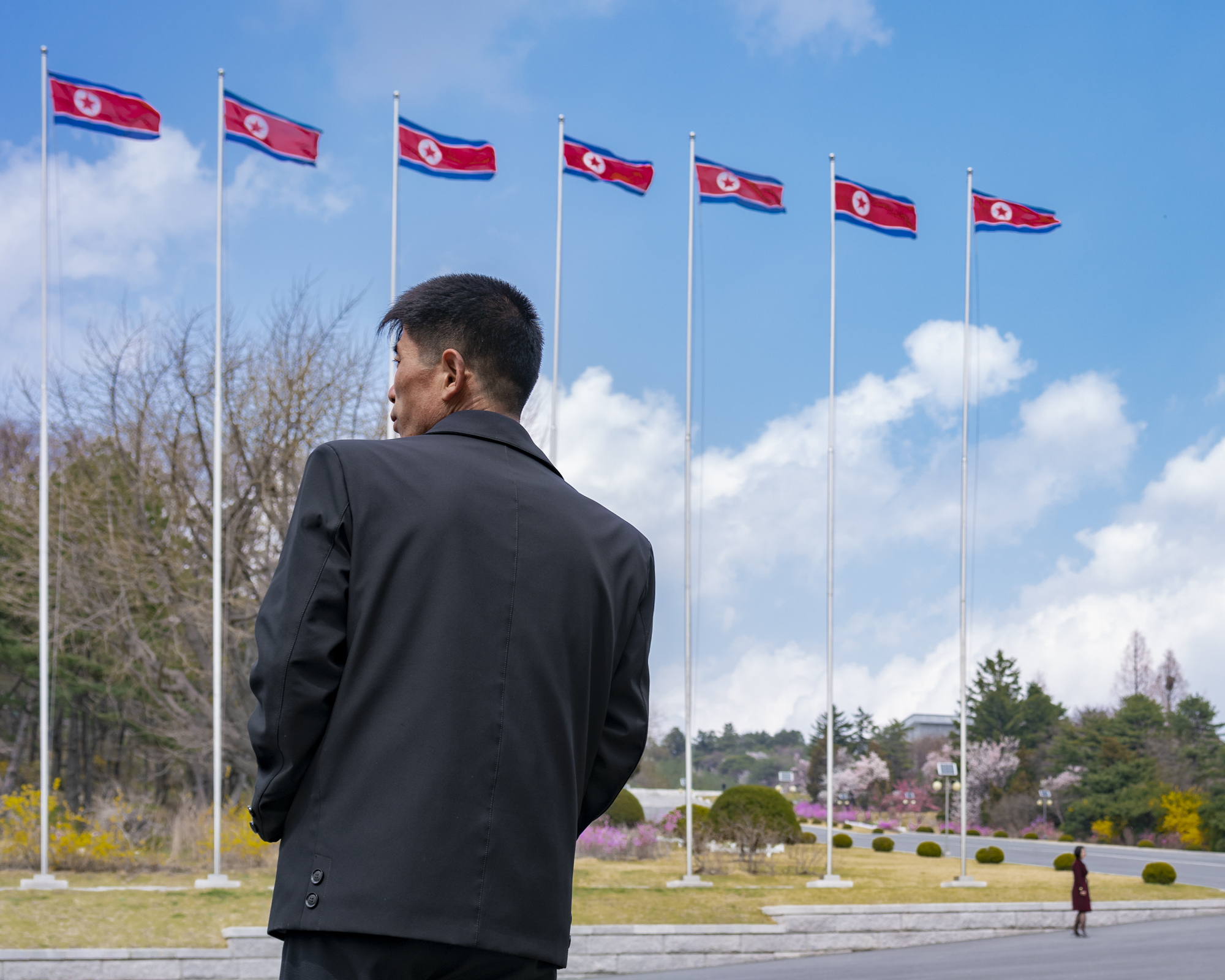
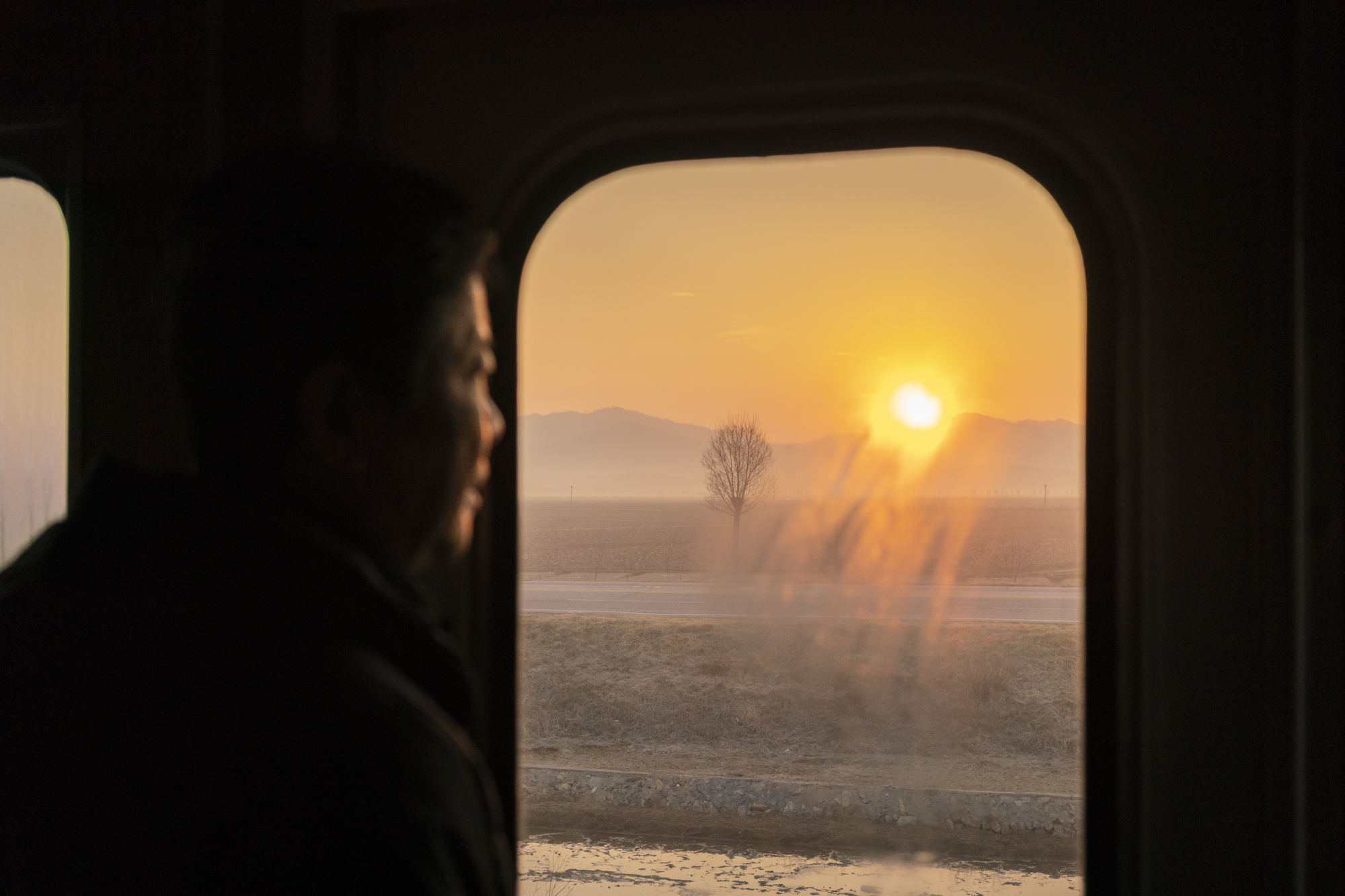
The journey from Sinŭiju–a North Korean city on the Chinese border–down to Pyongyang, is a six hours-long ride, passing through the central highlands, towns and villages.
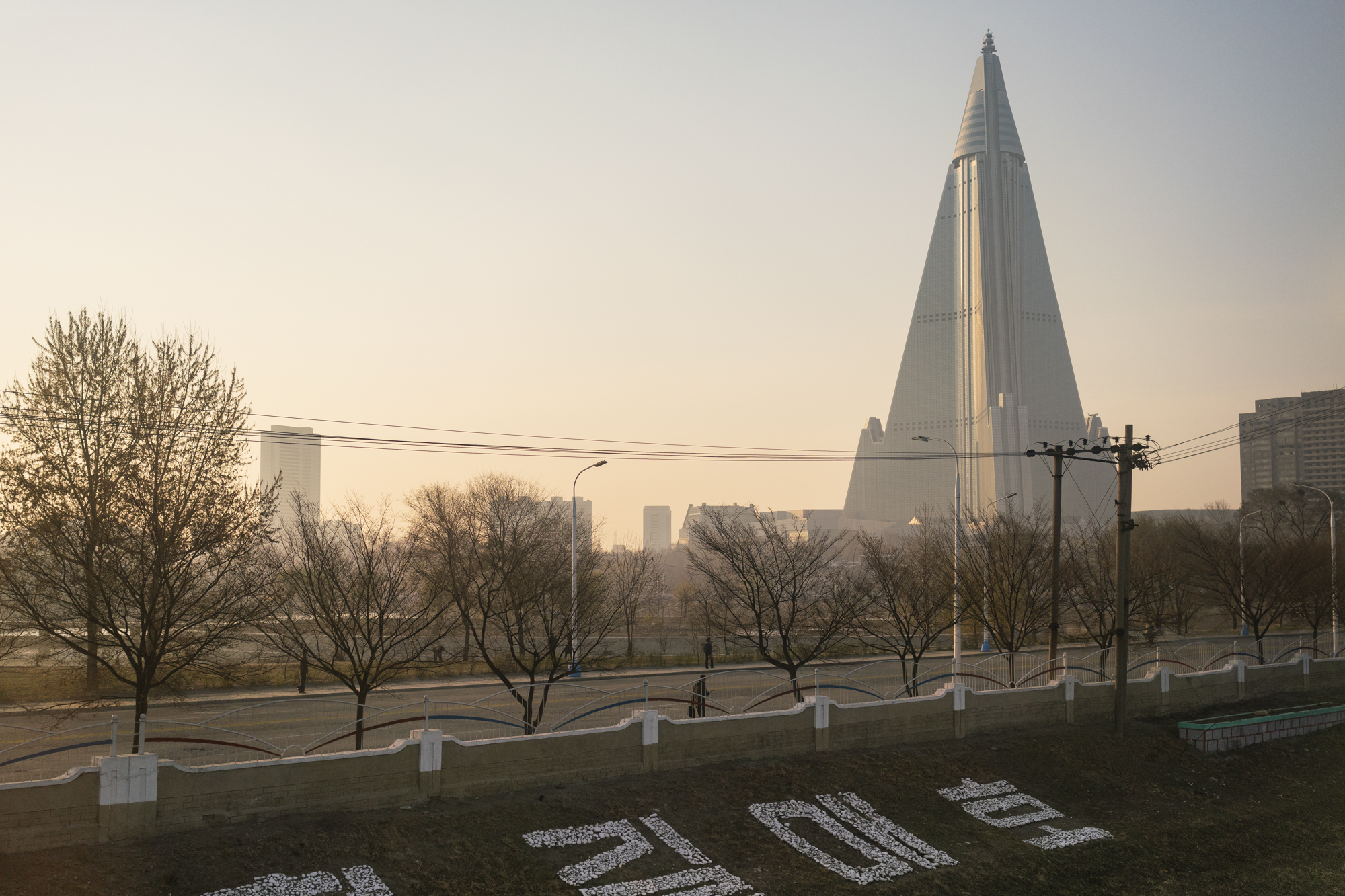
Arriving in Pyongyang, the Ryugyong Hotel dominates the scenery of the city since dawn.
Backed initially by the Soviet Union, the construction on the mysterious building–nicknamed “Hotel of Doom” due to the continuous interruptions on its completion–began in 1987 under the direction of Kim Jong Il, former Leader of North Korea, with the intention to create a national landmark for businessmen and international travellers. A partial opening was announced for 2013, but it was eventually cancelled. Yet, nowadays, more than thirty years later, it isn’t clear to what use the 105-story building is conceived for.
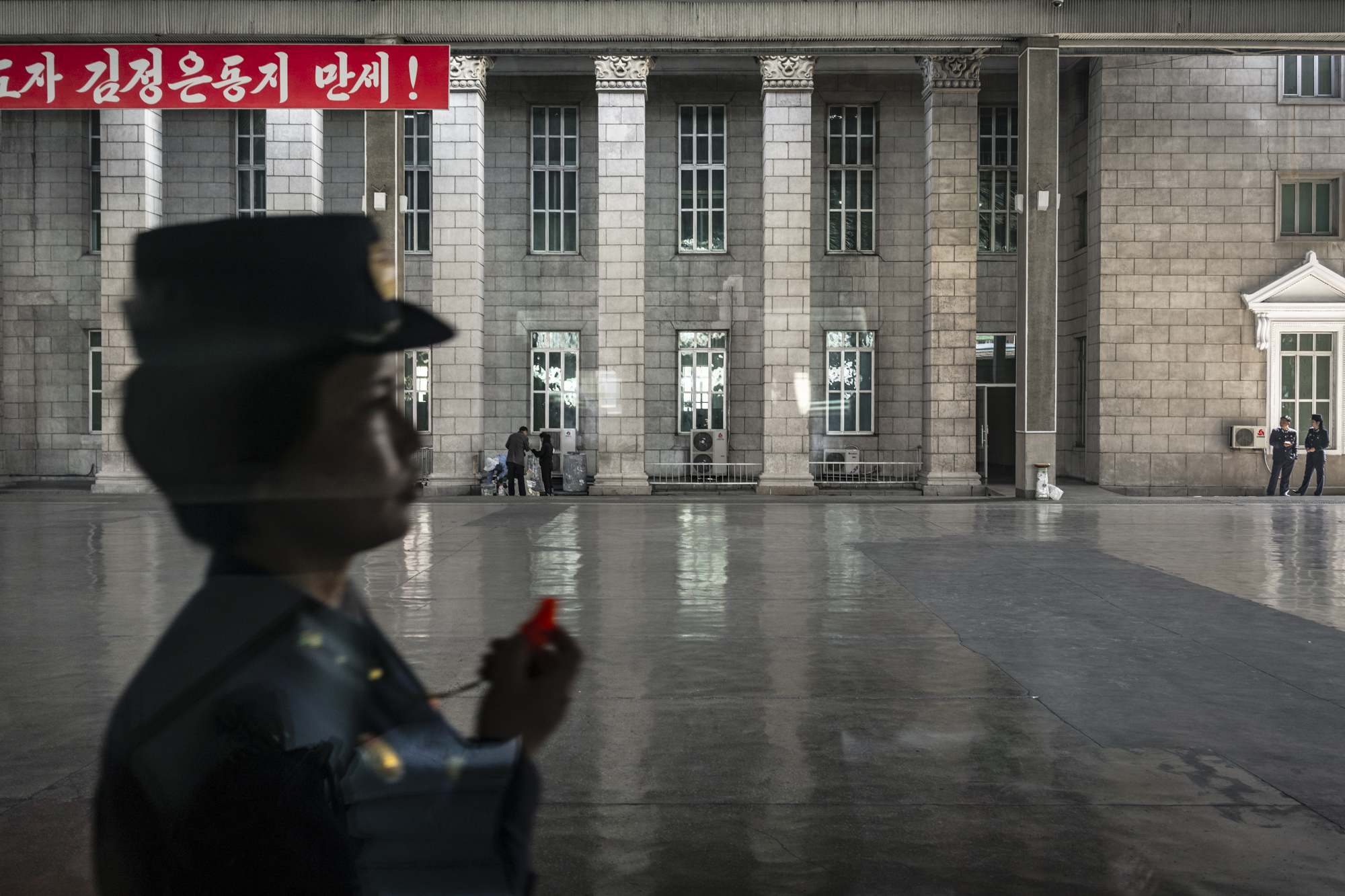
A train station officer with a whistle on the platform at Pyongyang Railway Station.
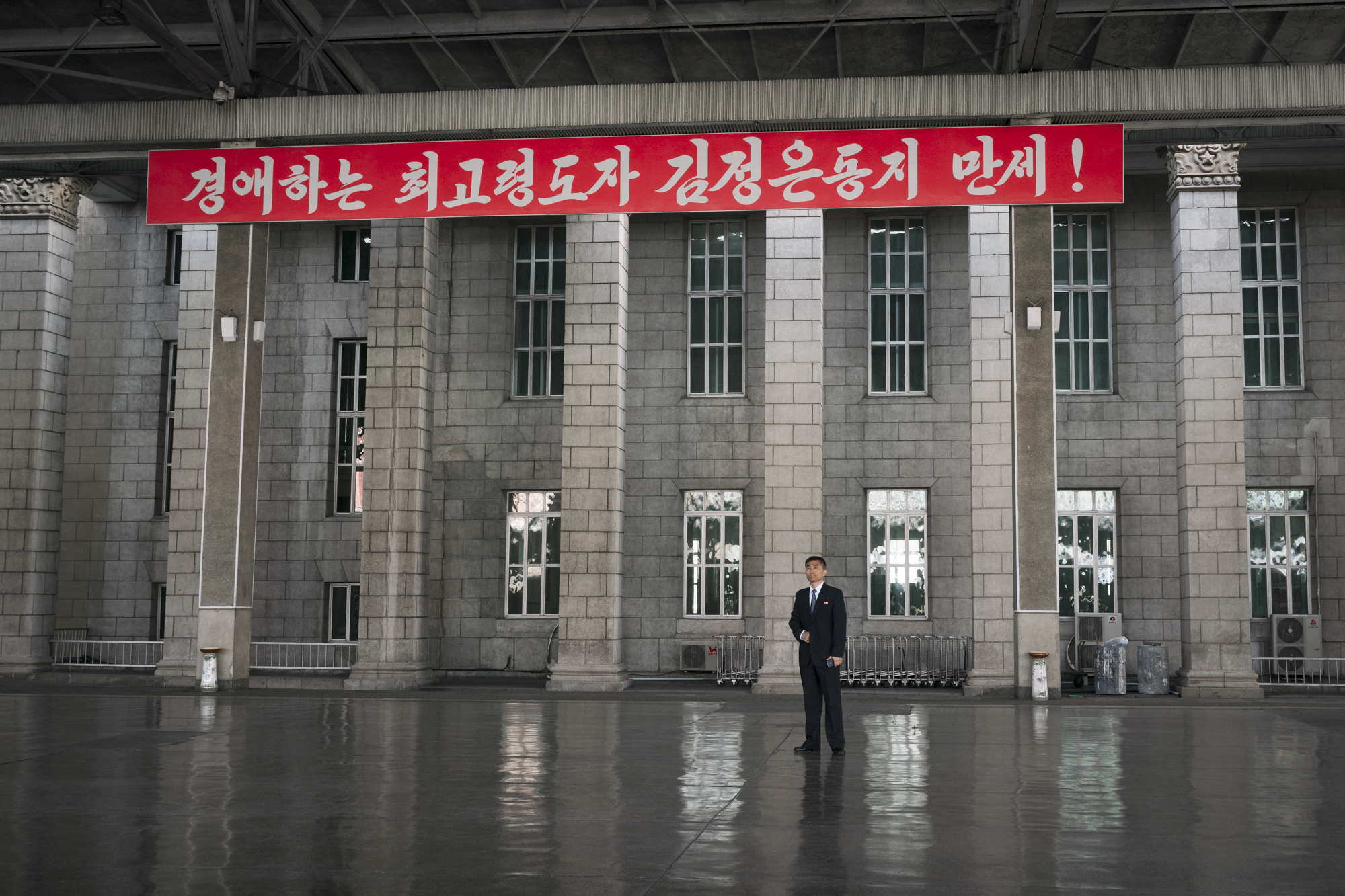
A North Korean man is standing by the platform n.1 at the Pyongyang Railway Station, which also serves as the main station in North Korea connecting most of the cities in the country.
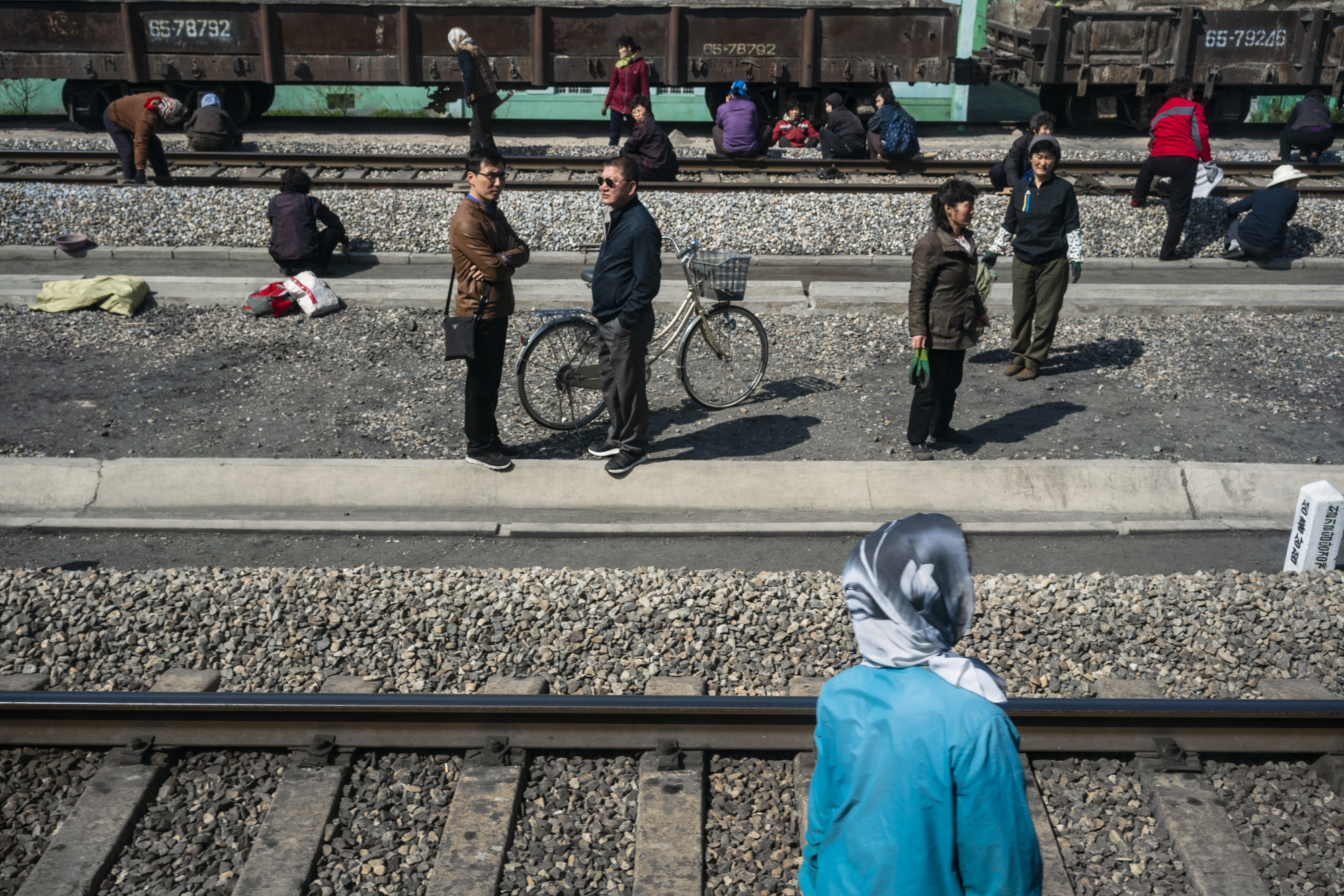
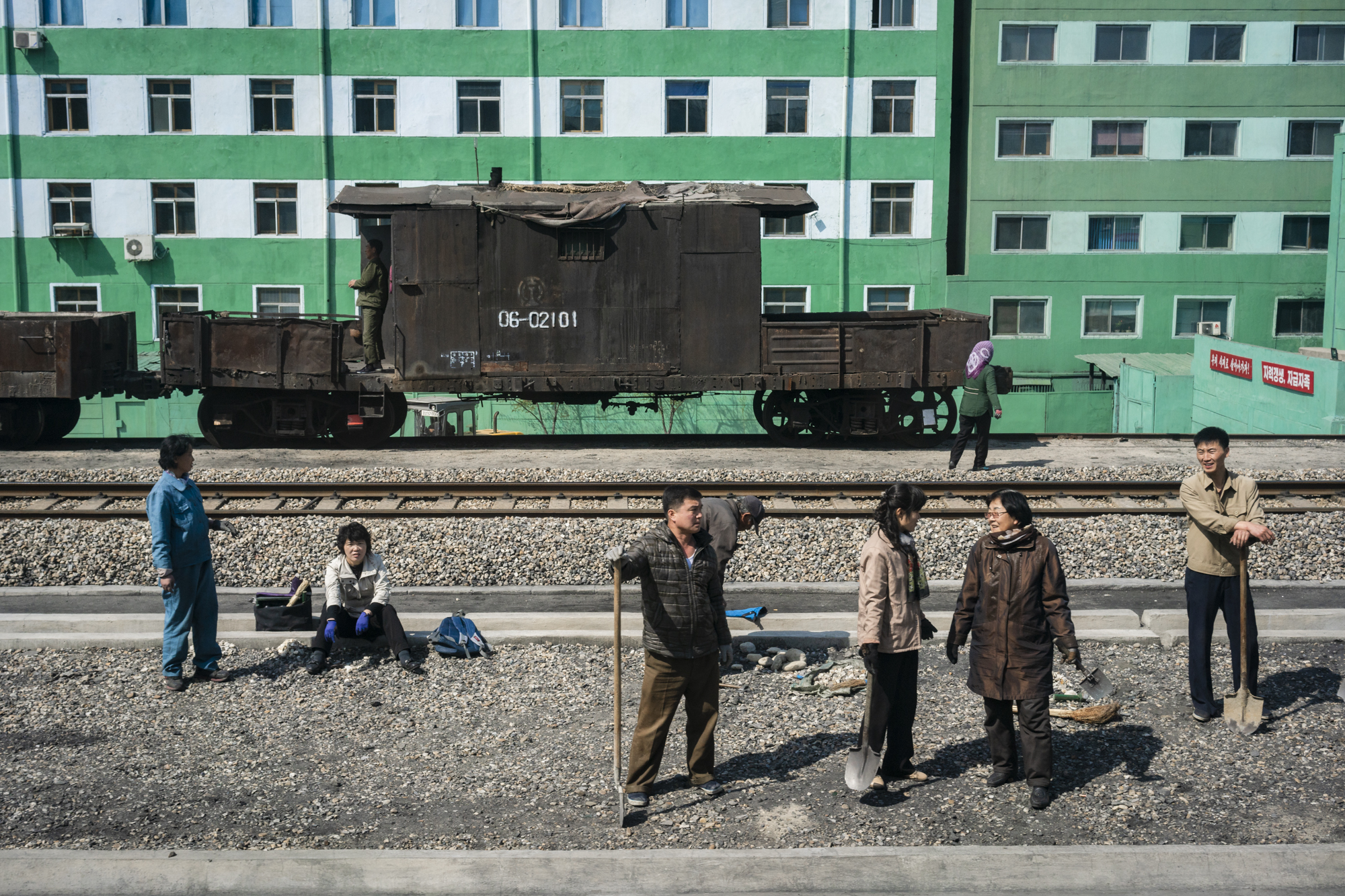
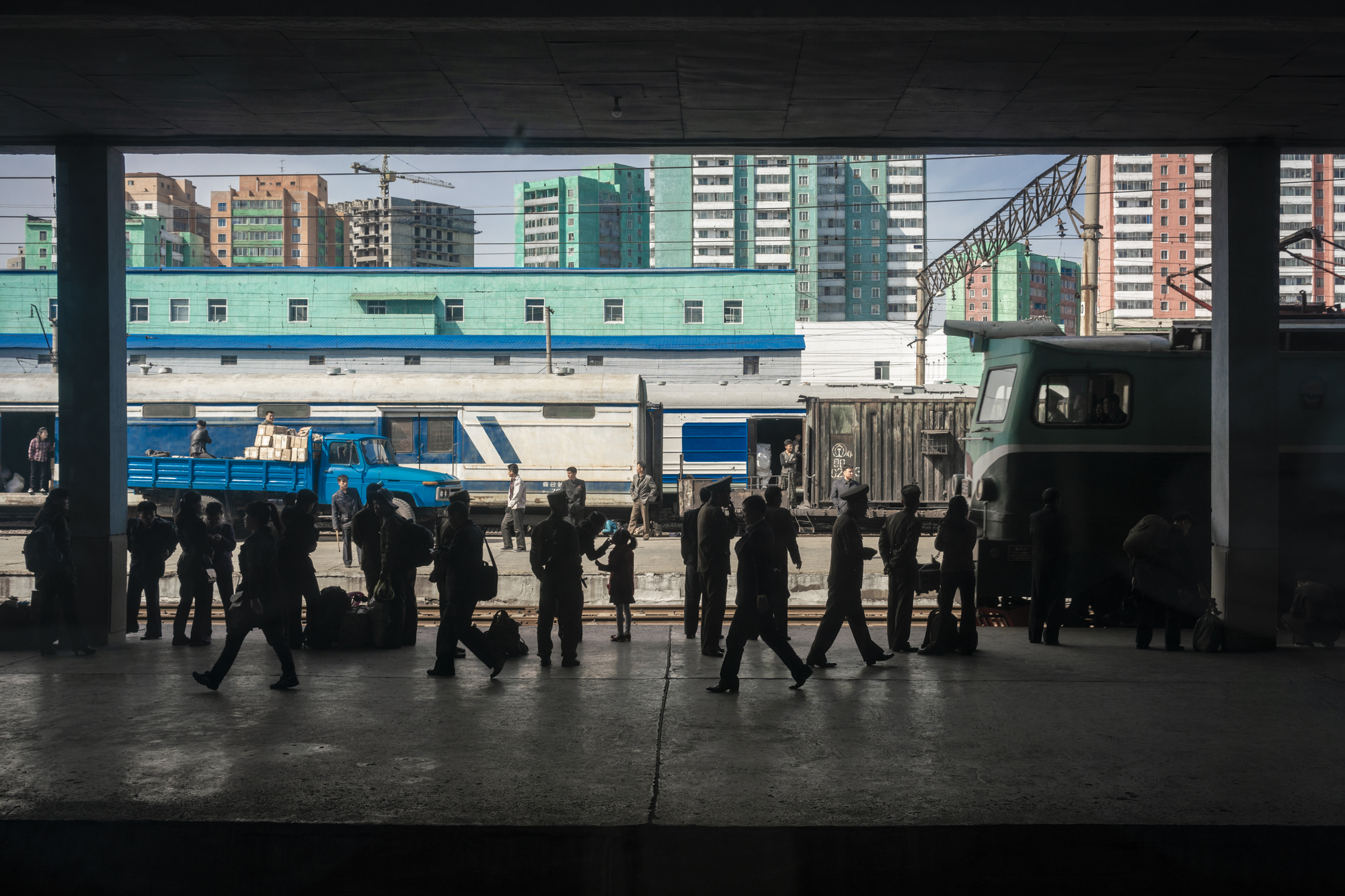
North Korean commuters are standing on the platform waiting for the train.
The North Korean Railway still utilises old Soviet trains from the mid-20th century.
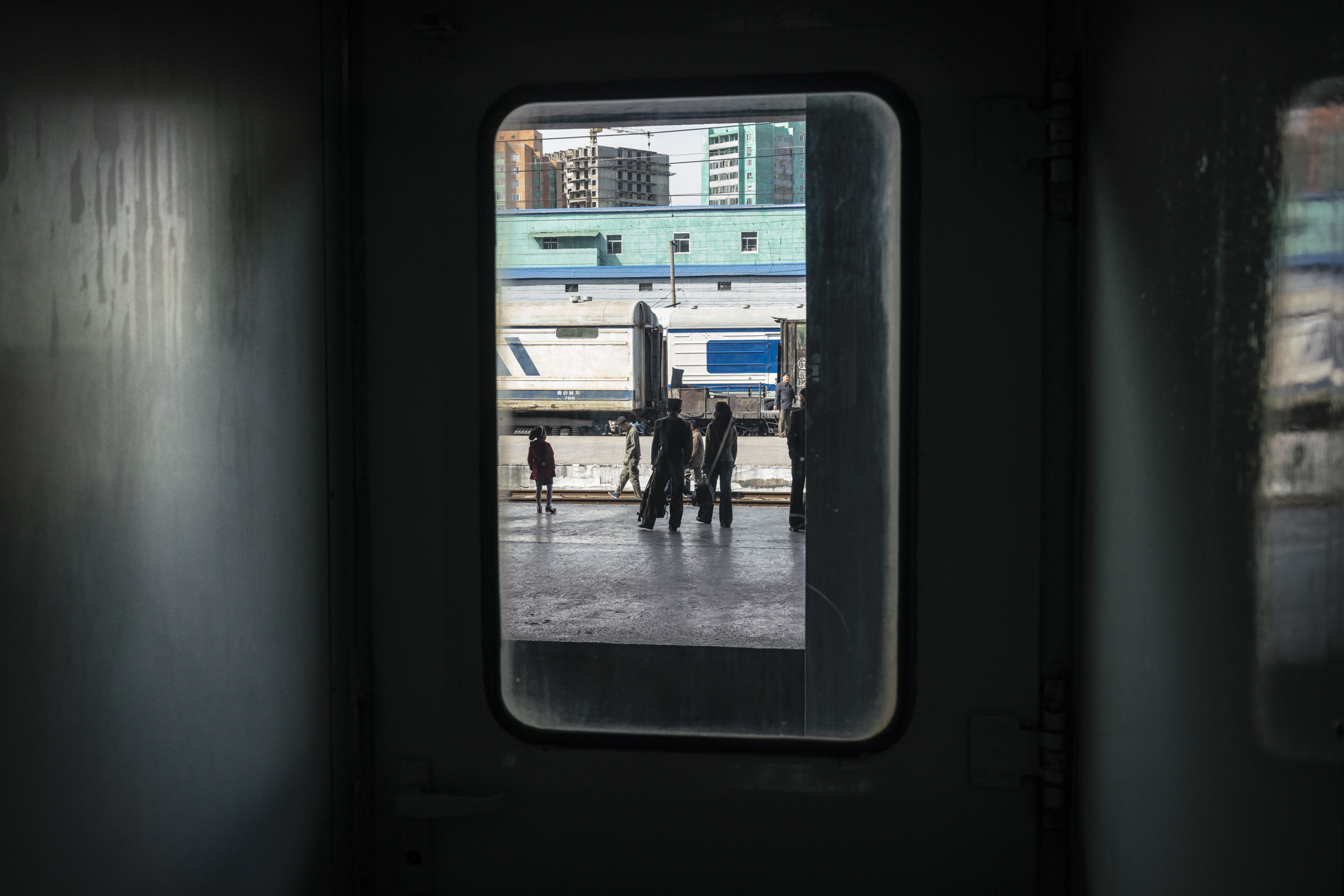
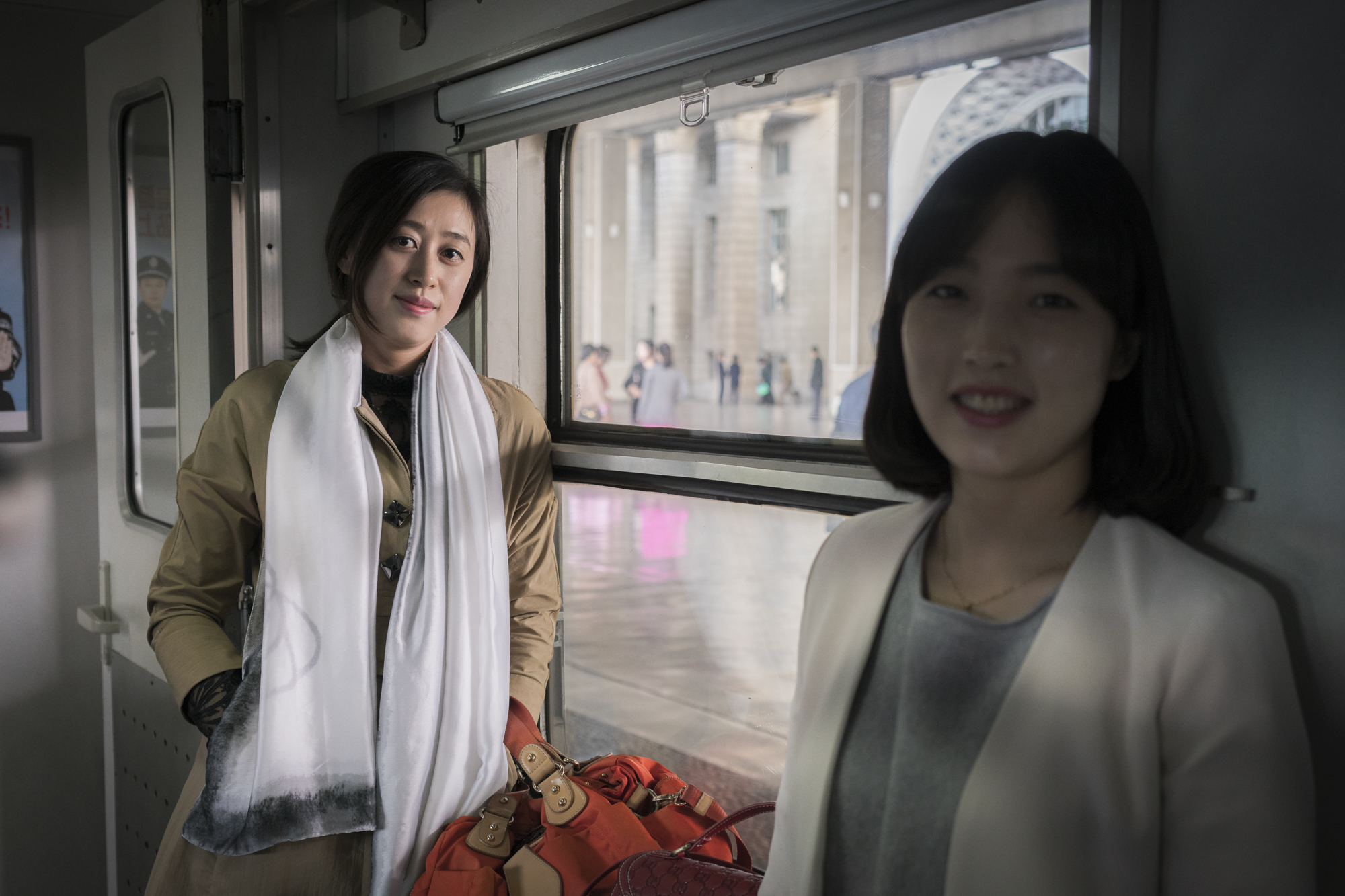
The North Korean government guides, known as “minders”, an assured–sometimes even pleasant–part of any visit to the DPRK.
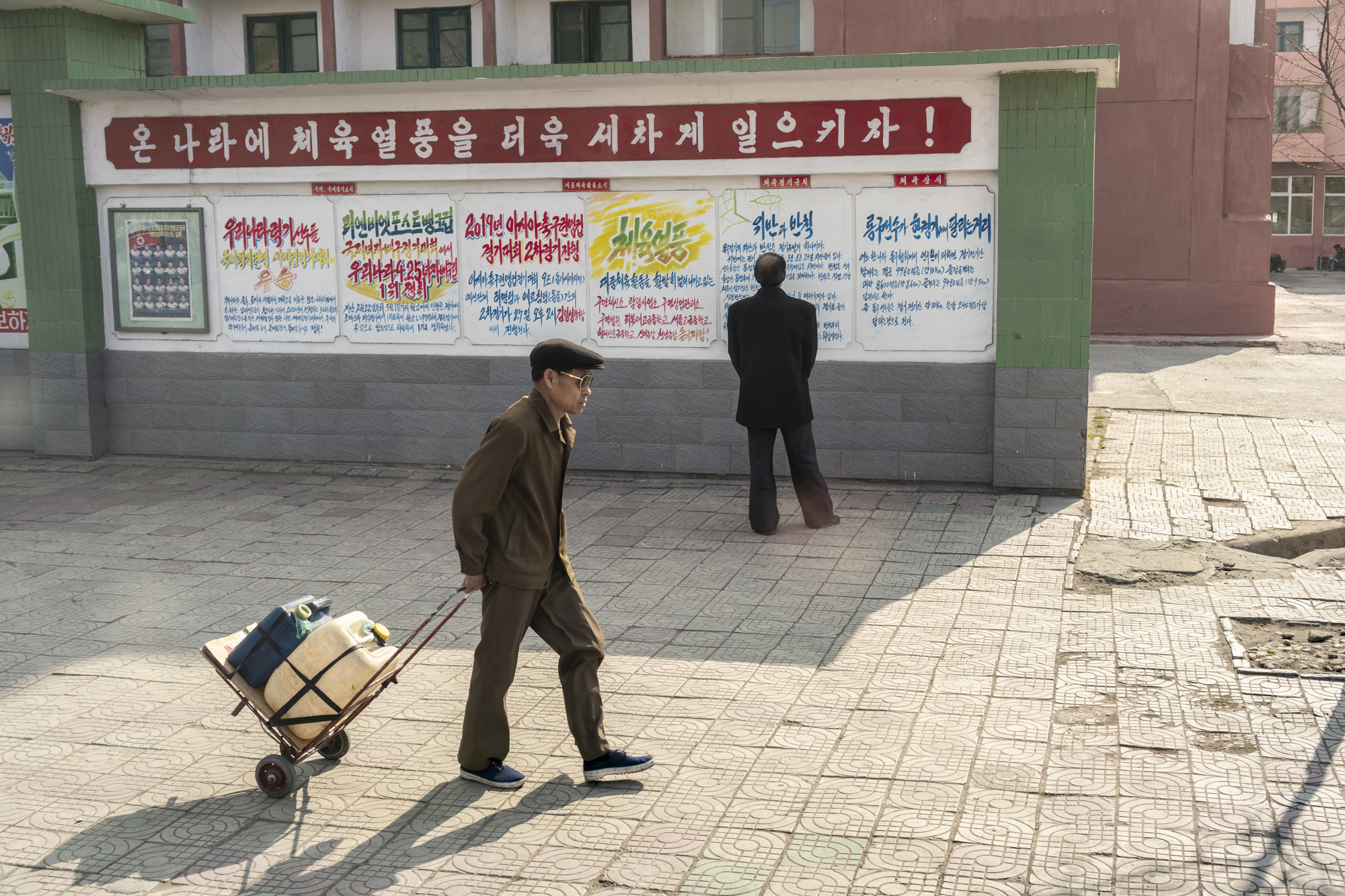
A man is reading propaganda messages on a wall in a Pyongyang neighbourhood.
All propaganda messages are produced following the guidelines set by the Propaganda and Agitation Department (PAD) and placed throughout the whole country to encourage people to work hard and to boast about the glories of North Korea.
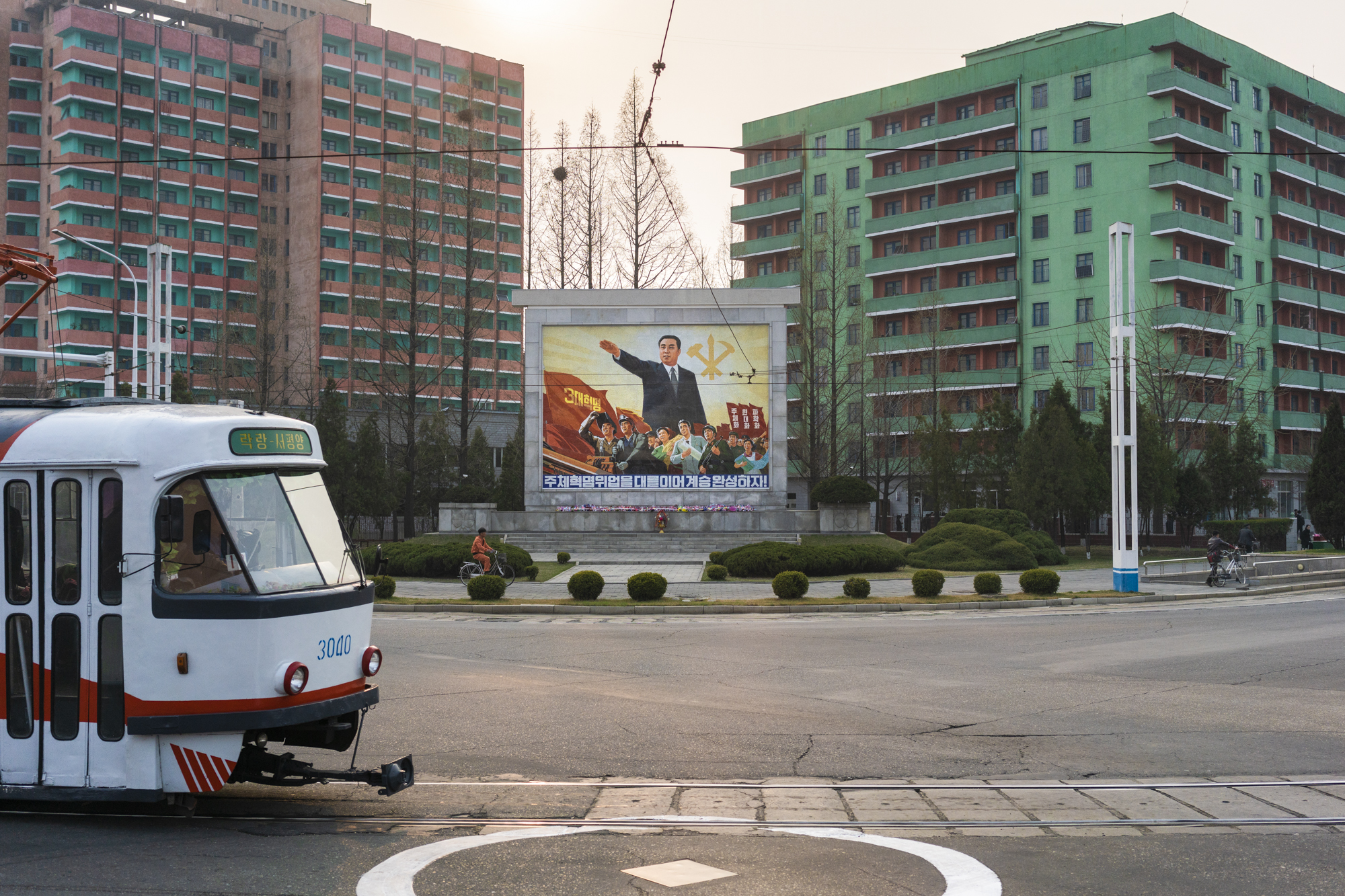
A propaganda mural depicting the Great Leader Kim Il Sung leading the Nation.
Most of the North Korean propaganda disseminates Juche, which means “self-reliance,” the North Korean ideology of independence promoted by North Korean founder Kim Il Sung.
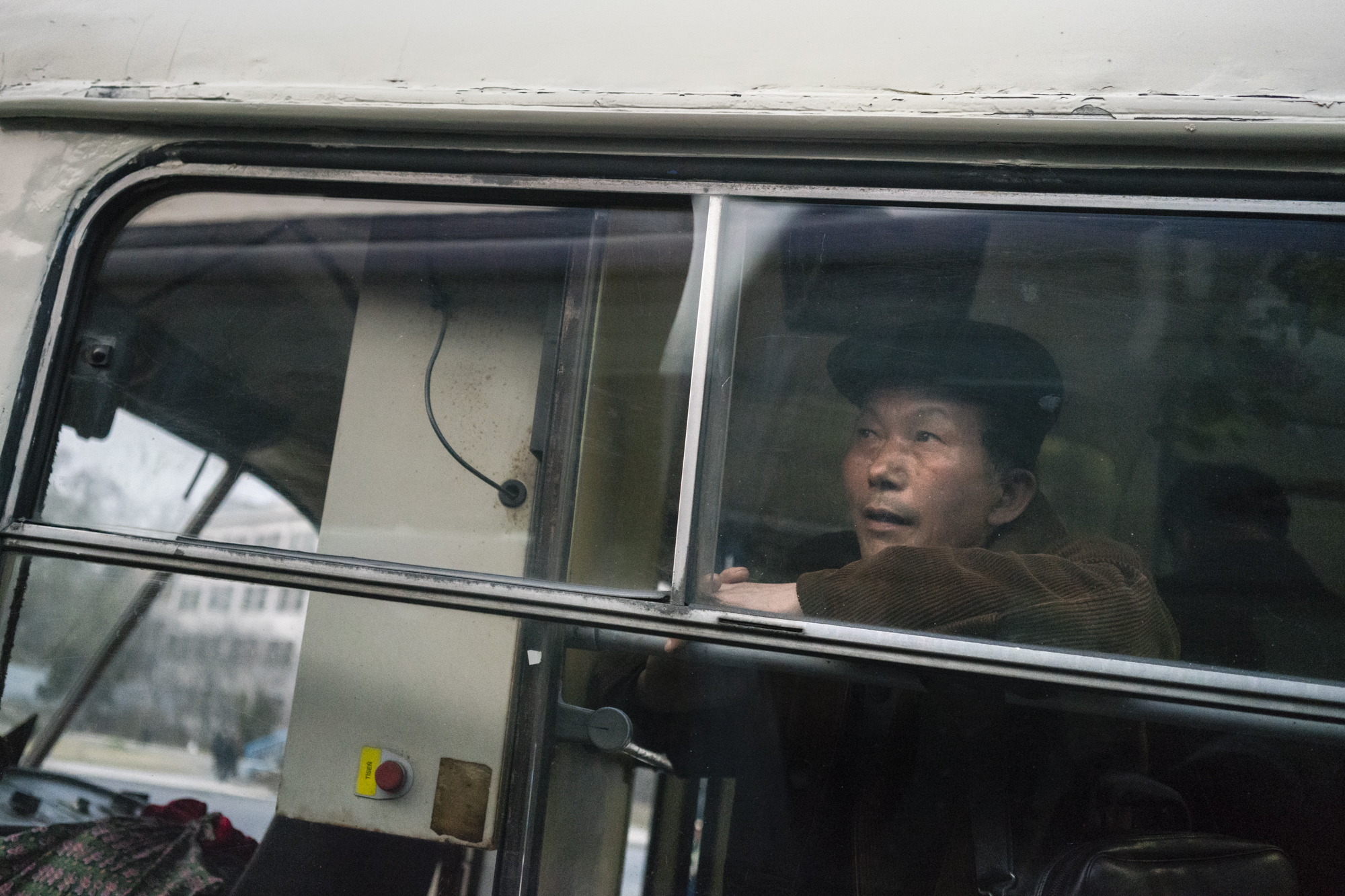
In North Korea, public transportation connecting the main towns is nearly nonexistent, citizens need permits to go from one place to another. By entering and leaving Pyongyang and other major cities, soldiers are assigned at checkpoints placed on the road to control people’s movements.
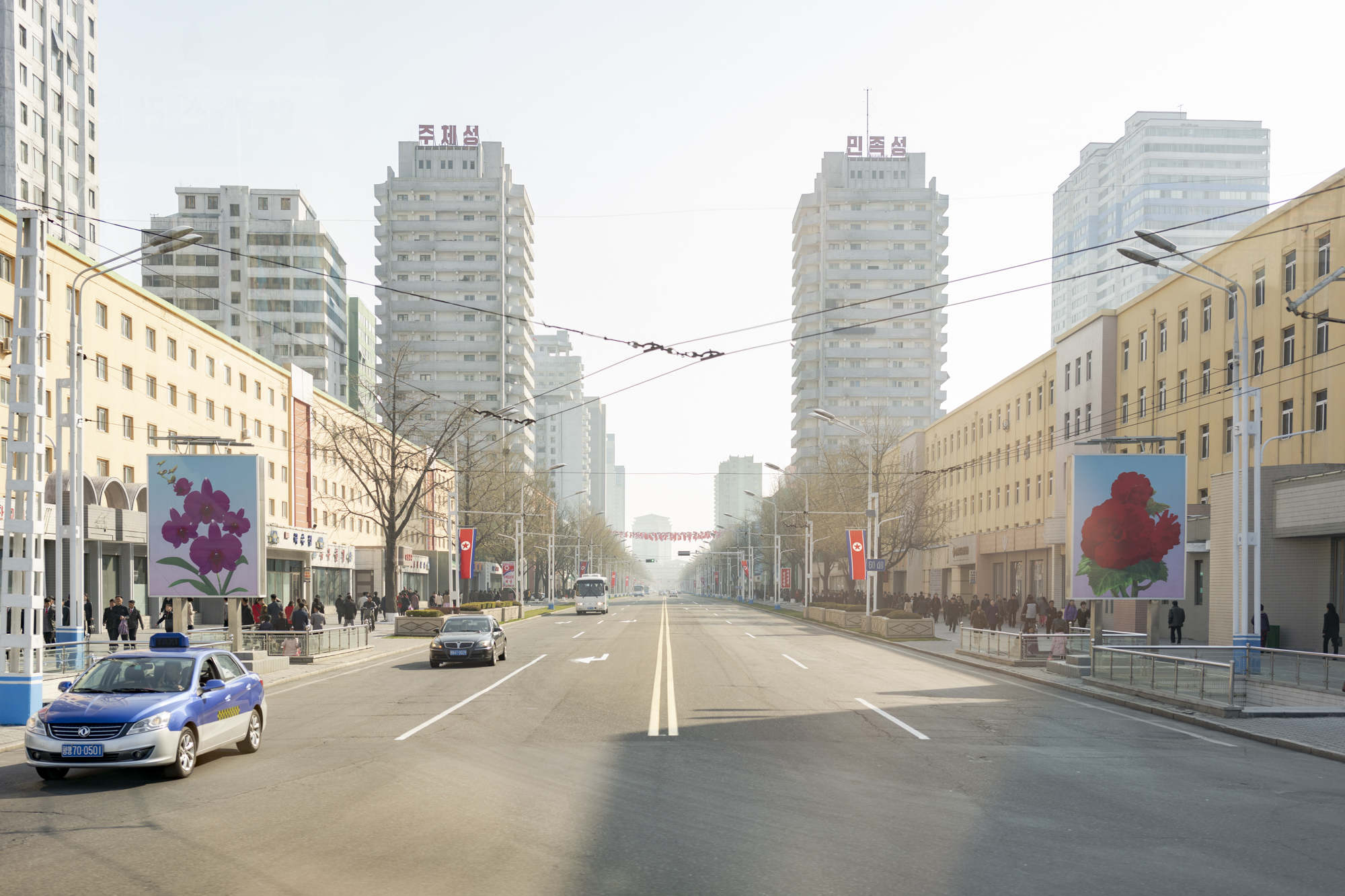
The majority of North Koreans do not own cars. As well as for the city’s best neighbourhoods and apartments, also cars are reserved for the Party elite as symbols of a higher rank in society.
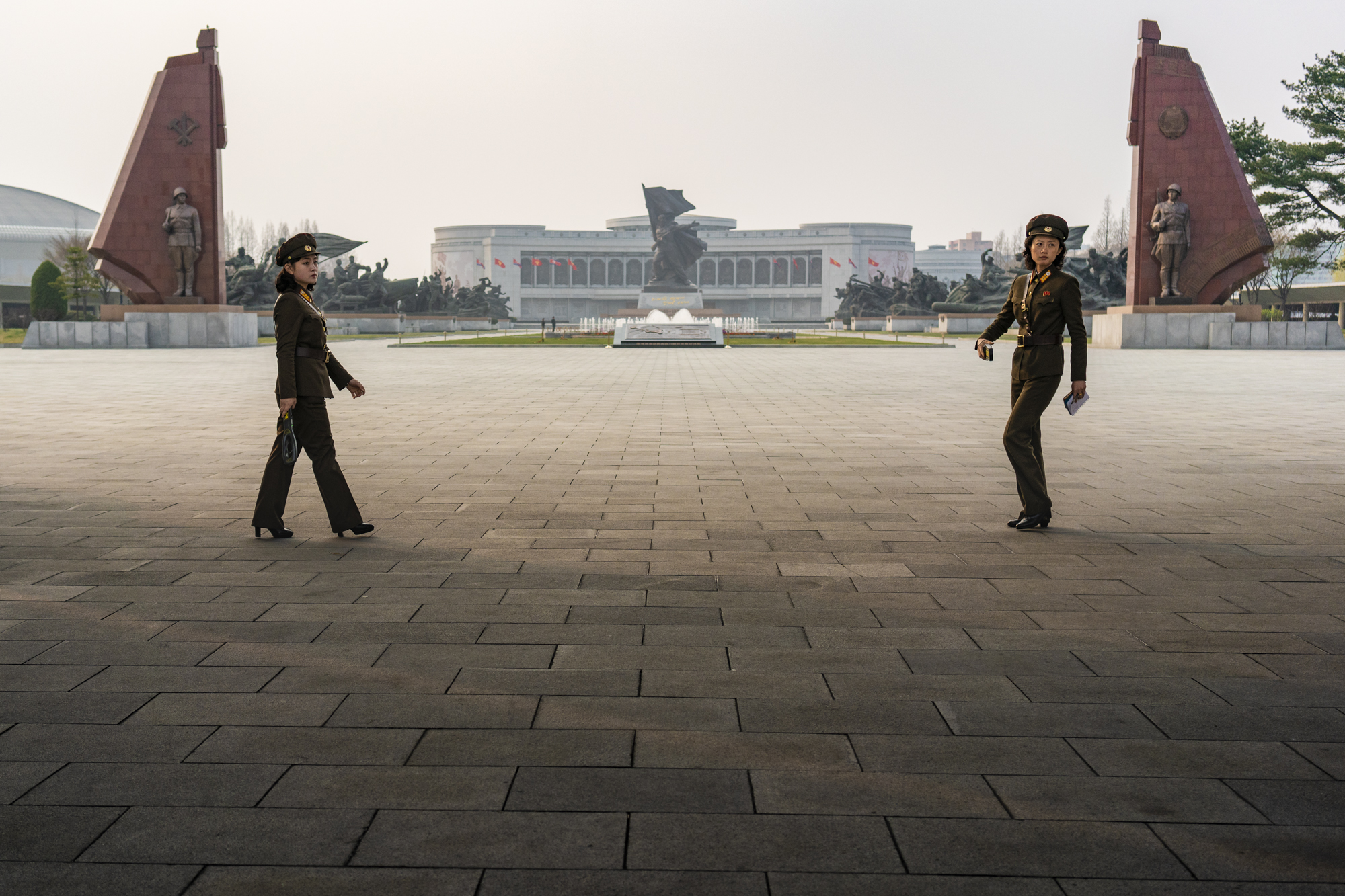
The entrance to the Victorious Fatherland War Museum in Pyongyang. A history and military museum dedicated to the Korean War.
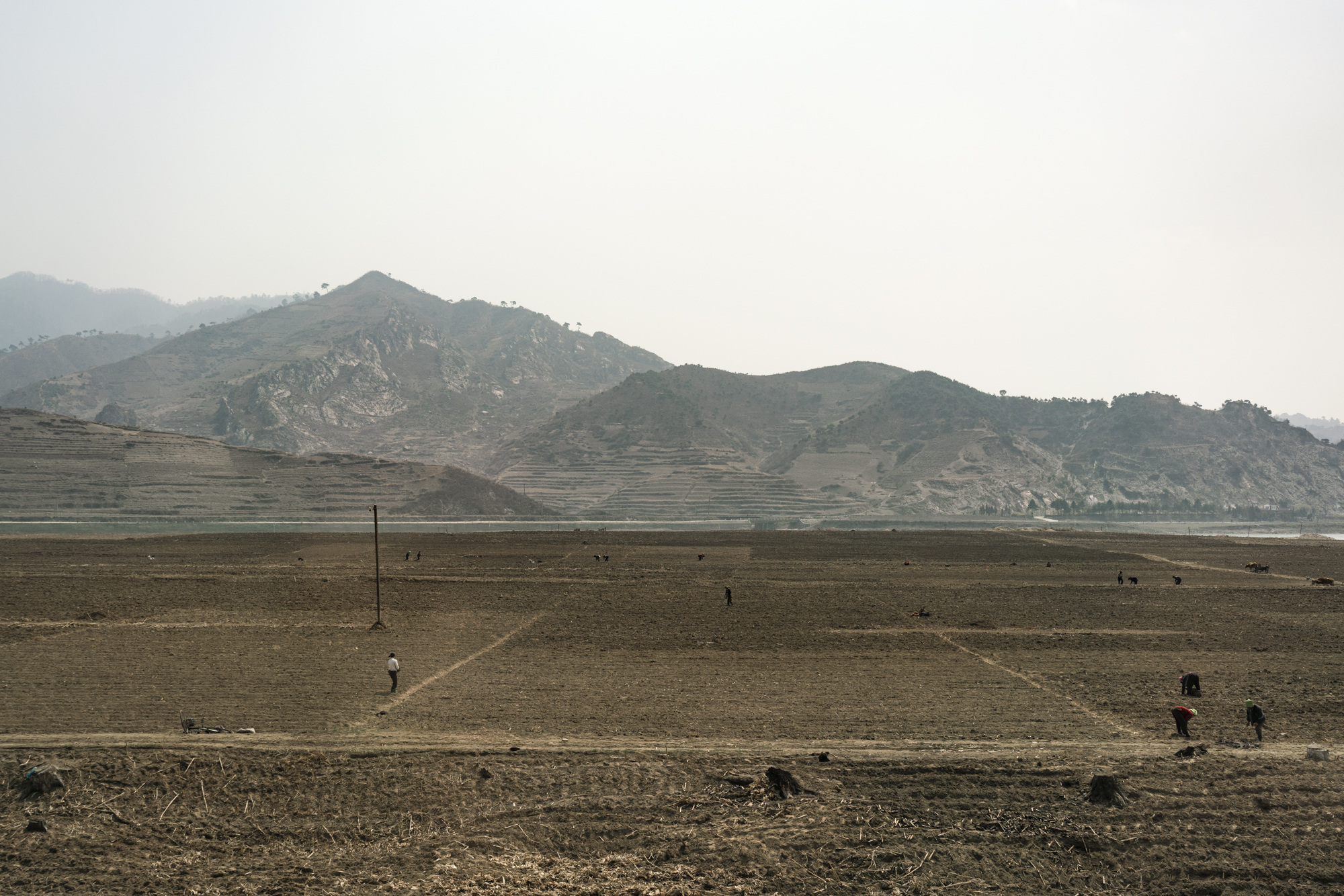
Crops are harvested in the North Hwanghae Province.
Natural disasters and poor farming practices led to North Korea’s worst yield in more than a decade. In recent years, North Korea has been fighting severe droughts which decimated its production of crops causing chronic food shortages.
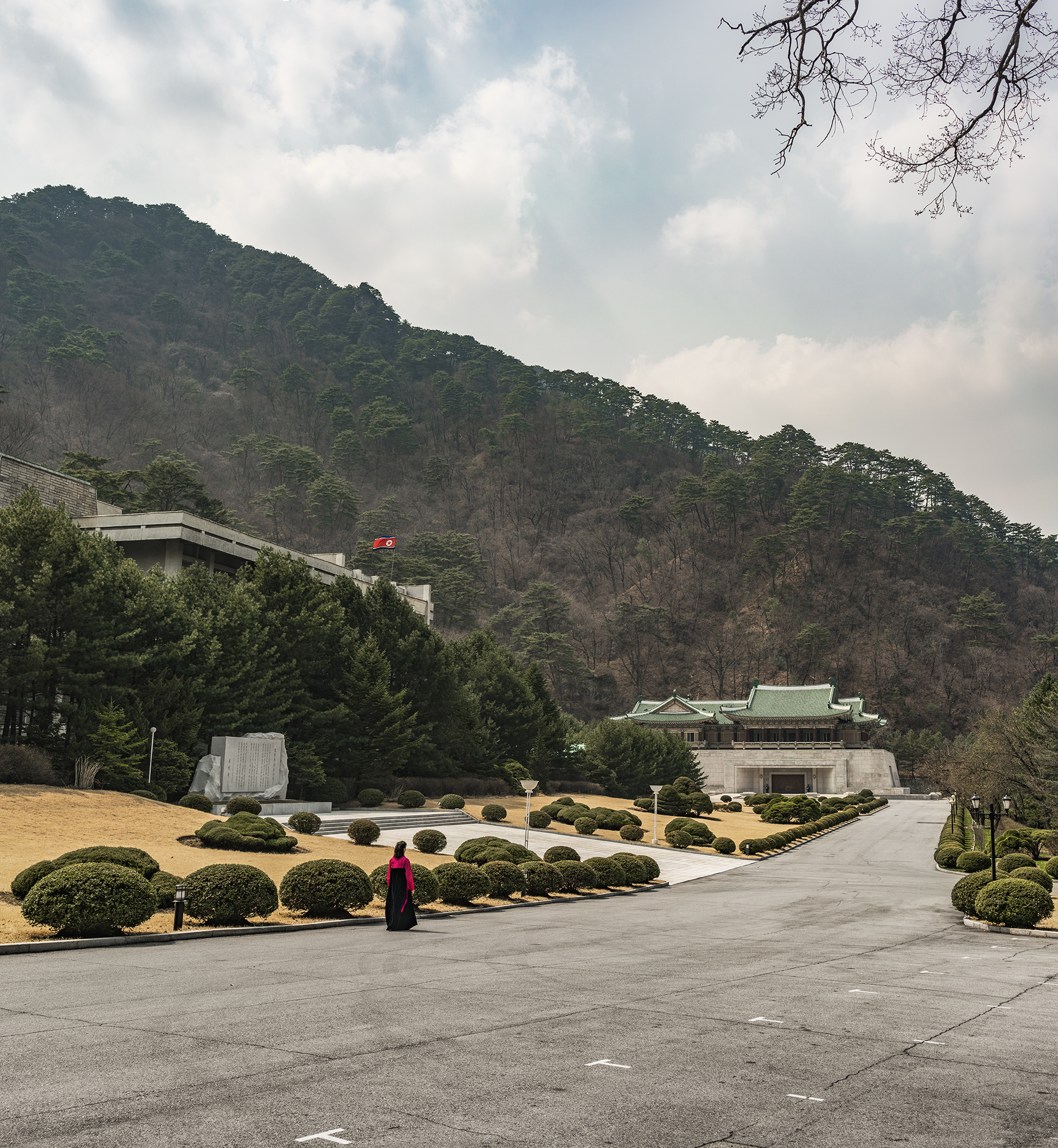
A North Korean guide wearing a traditional dress is walking towards the International Friendship Exhibition Hall in the Myohyang Mountains area.
The complex is an underground exhibition consisting of all the gifts that the Great and Dear Leaders of North Korea received on state visits and official occasions.
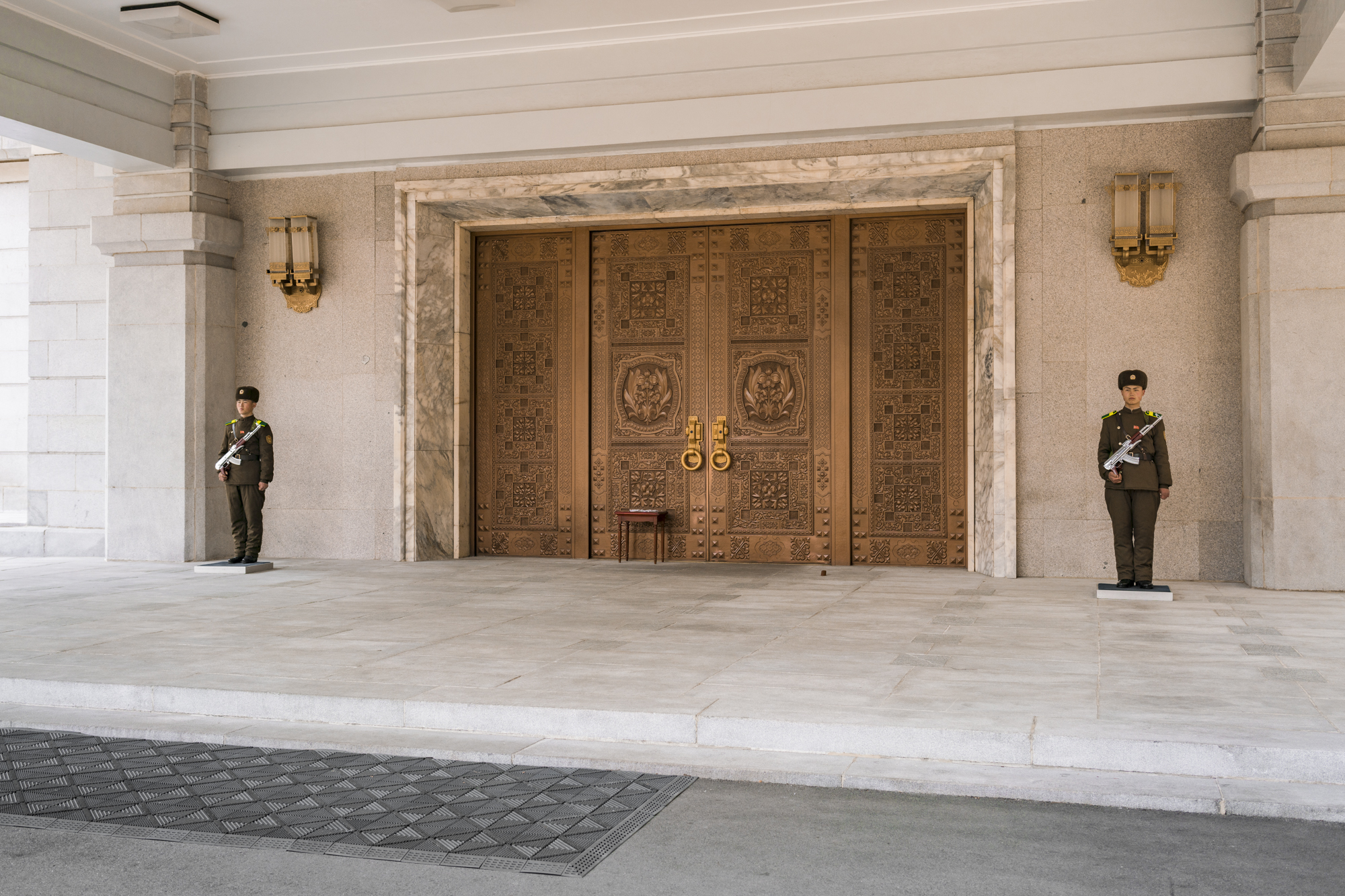
Two motionless North Korean army soldiers with polished silver-plated machine guns guarding the entrance to the Friendship Exhibition Hall complex in the Myohyang Mountains area.
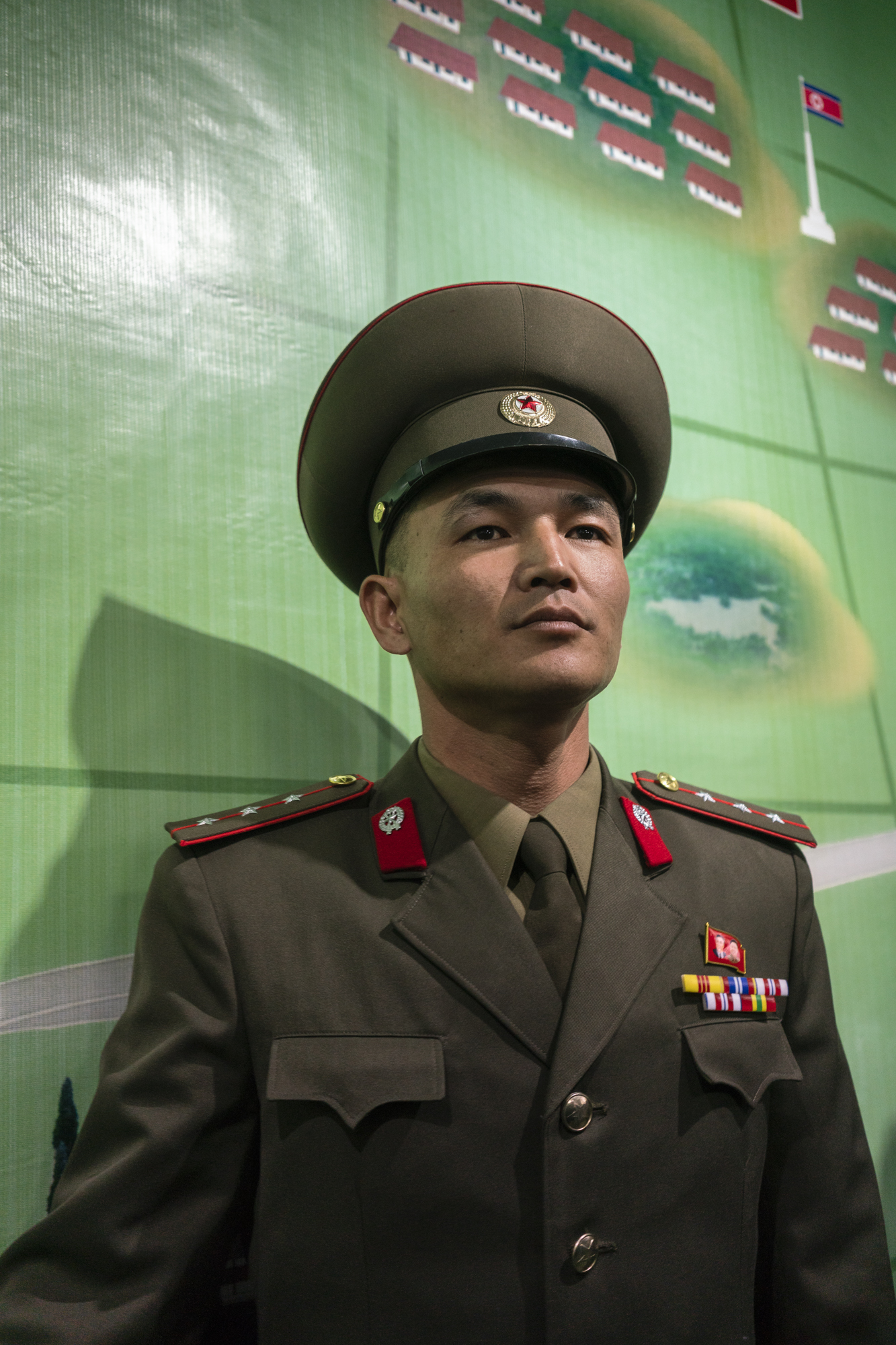
A North Korean official is standing in front of a map that illustrates the border between North and South Korea in the DMZ.
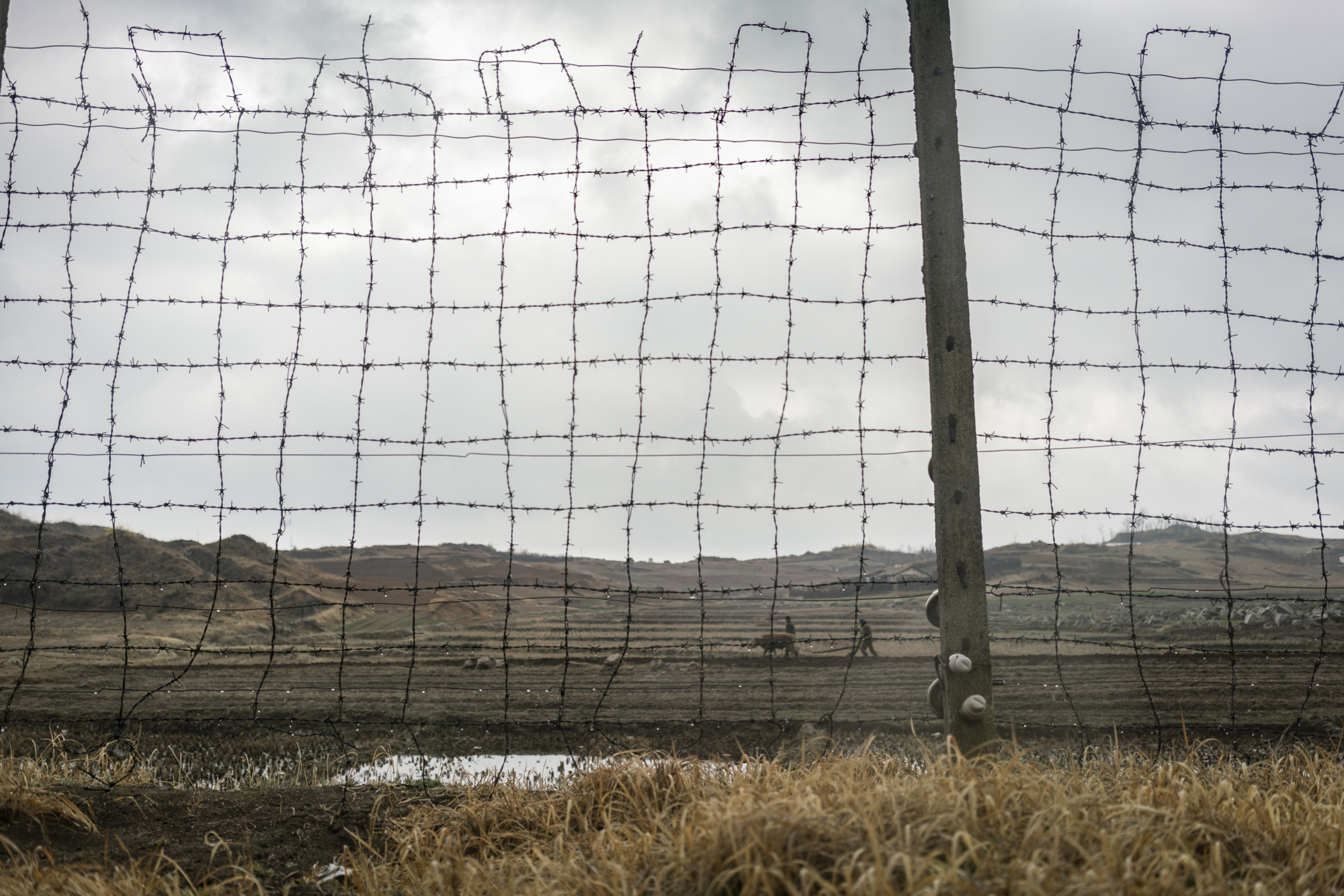
Behind the barbed wire, farmers work the land in Kijŏng-dong, also known in North Korea as “Peace Village”, one of the only two villages permitted to remain in the four-kilometre-wide DMZ laid out under the 1953 armistice ending the Korean War.
According to the North Korean government, the village has a collective farm that is run and maintained by 200 local families living in the area.
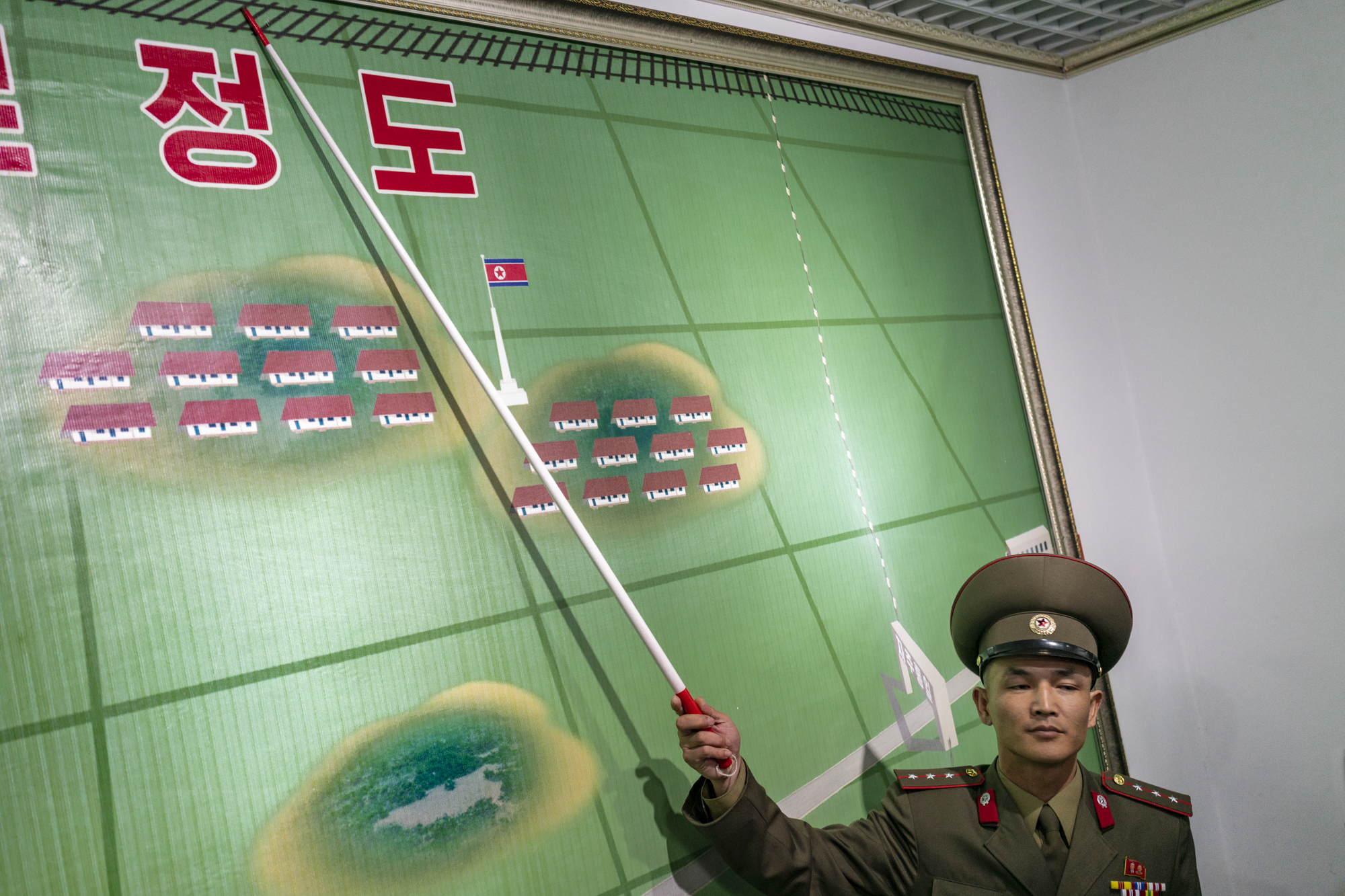
A North Korean soldier points a map of the border between North and South Korea in the DMZ.
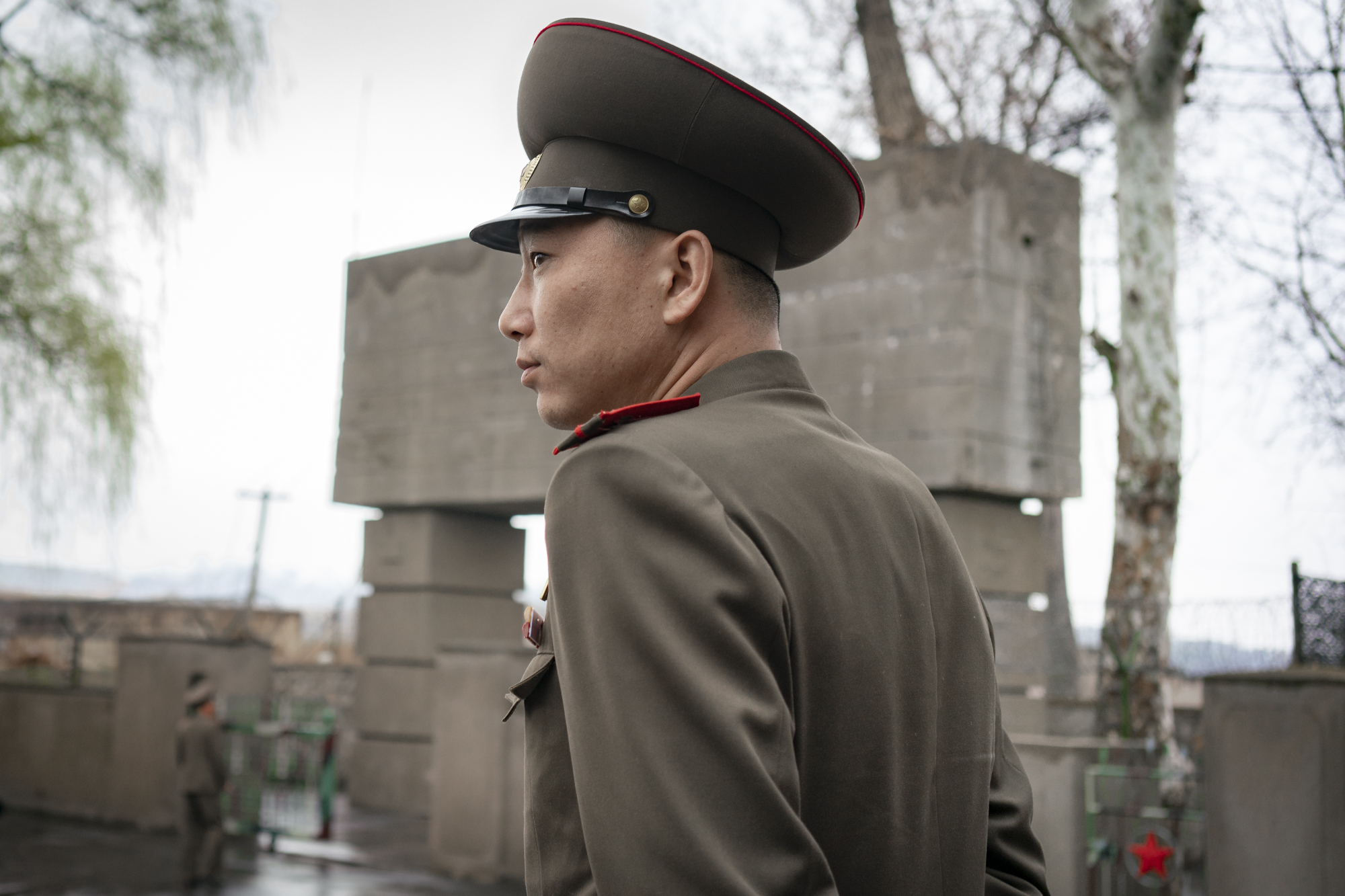
A uniformed North Korean army official is supervising the operations at the entrance of the DMZ in Kijŏng-dong.
The Korean Demilitarized Zone (DMZ) is a strip of land running across the Korean Peninsula serving as a buffer zone between North and South Korea.
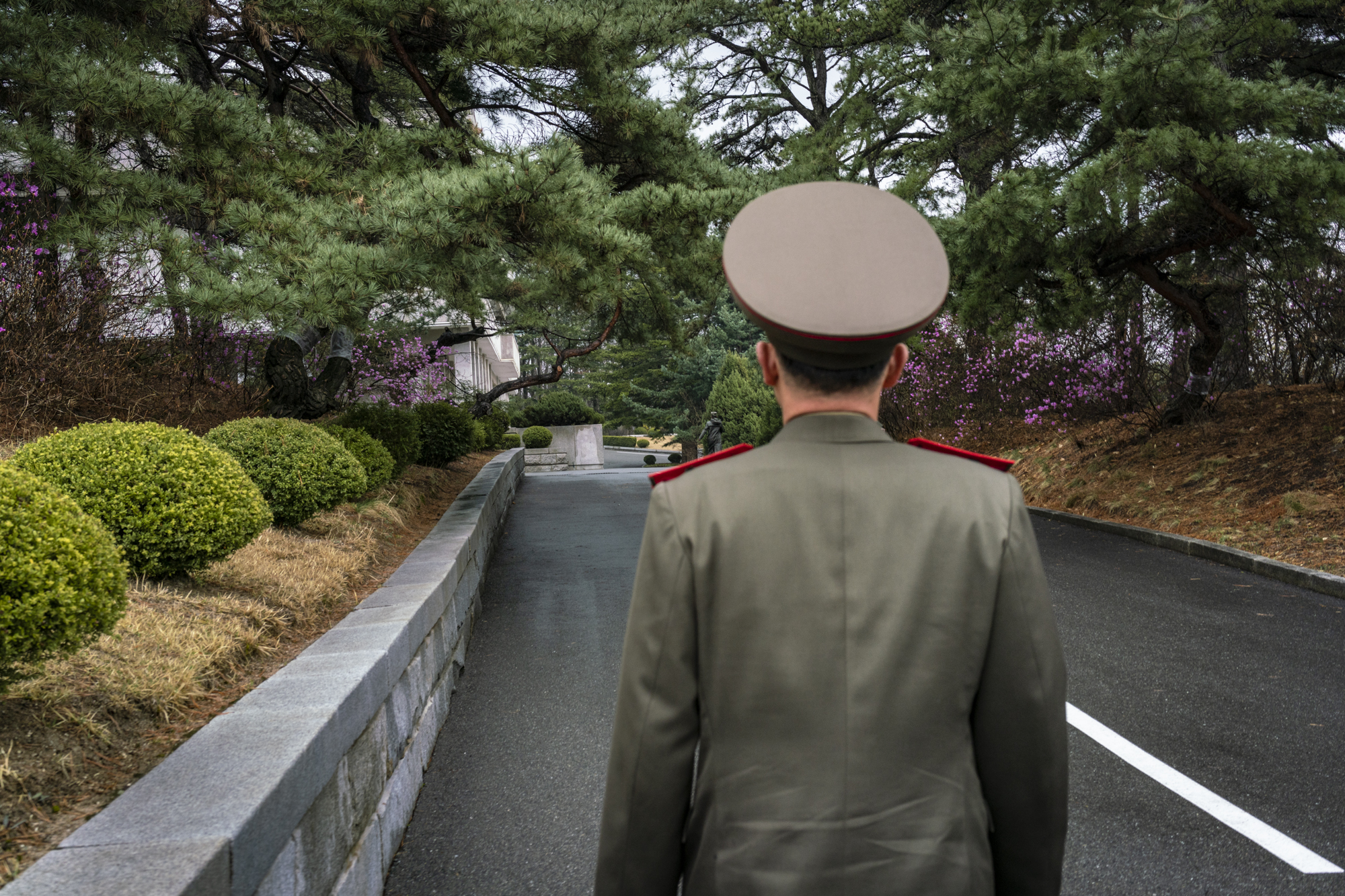
A uniformed North Korean army official is walking on the pathway towards the Joint Security Area (JSA) on the North Korea side.
Inside the DMZ, the Joint Security Area (JSA) is an area jointly policed by South and North, established as negotiating site, where the two sides occasionally meet for discussions.
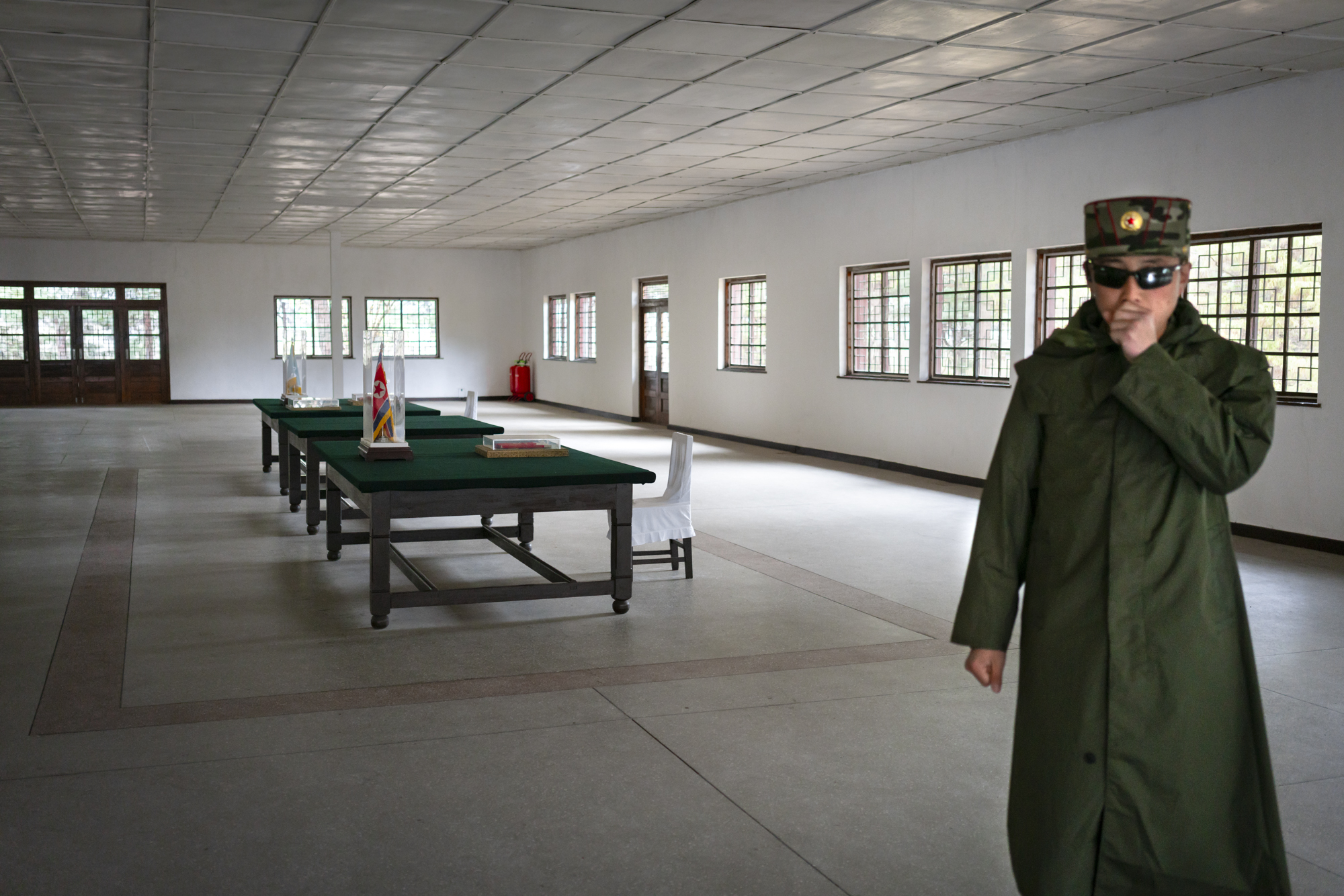
A North Korean soldier in the Armistice room, wherein 1953 North and South signed a truce that stopped hostilities, thus ending the Korean war and establishing the current borders.
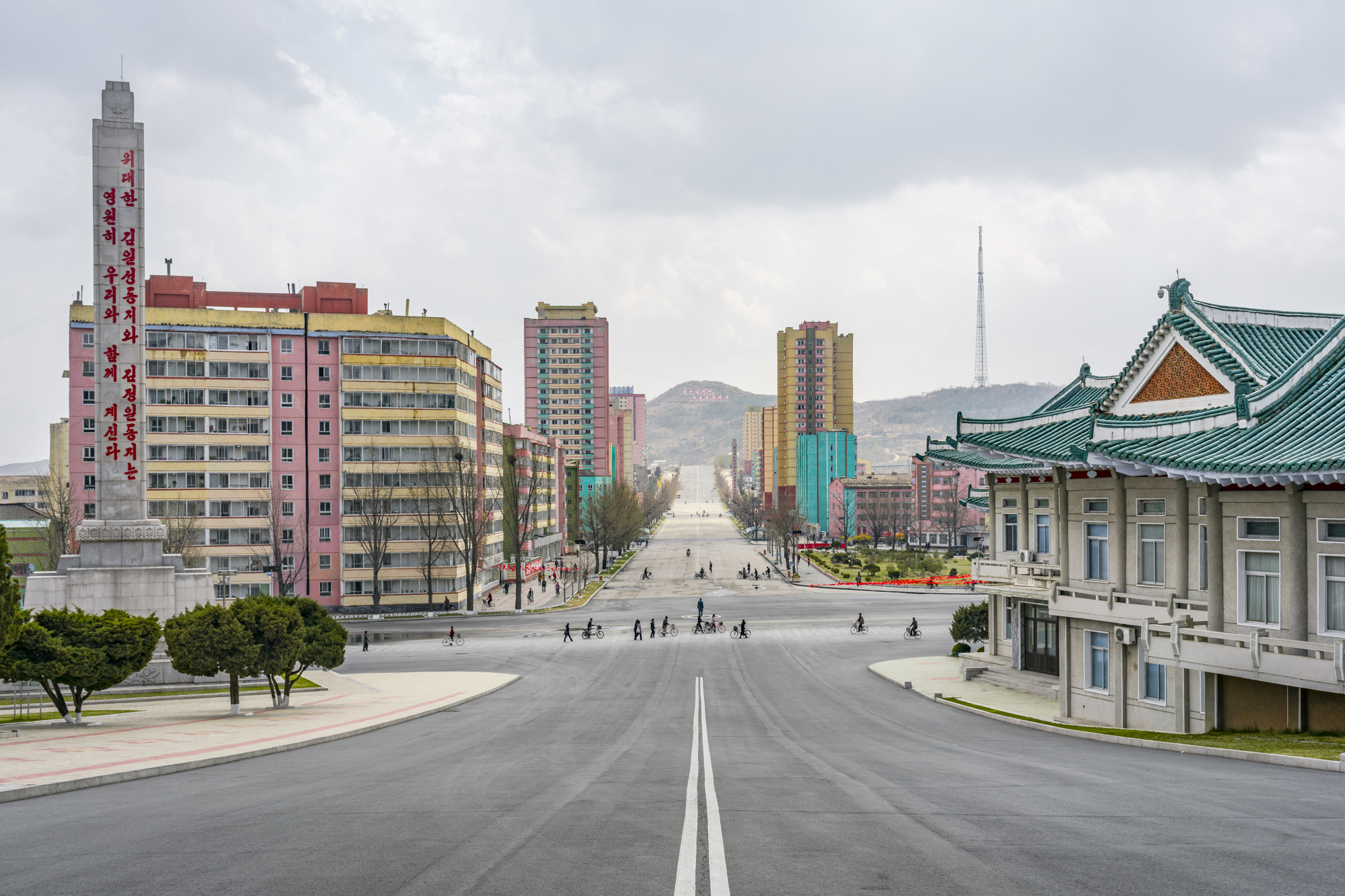
A street scene in Kaesŏng, North Hwanghae Province, the ancient capital of the Koryo Dynasty, North Pyongyang. On the left, the monument inspired by the Juche Tower.
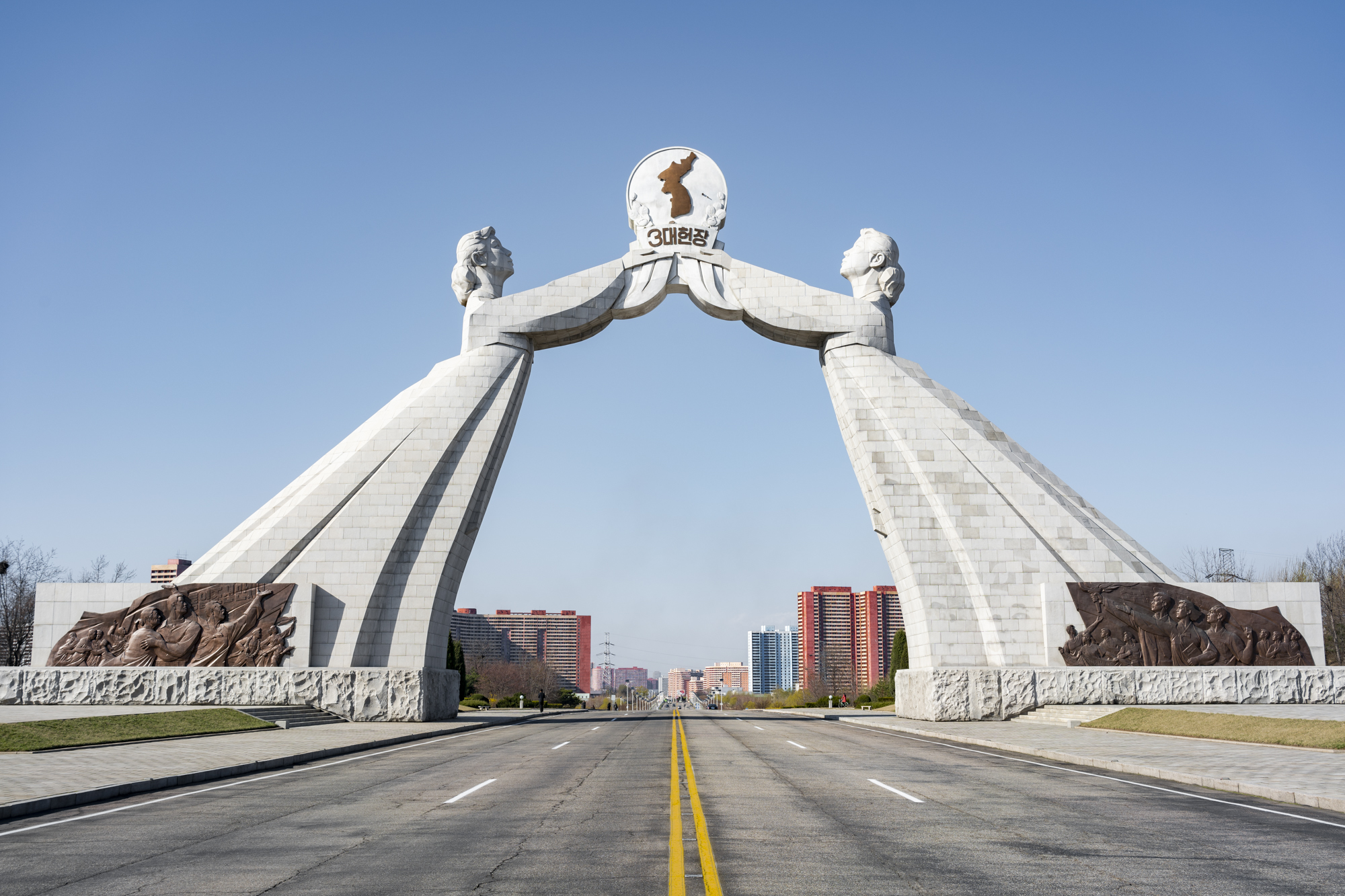
The Arch of Reunification on the Reunification Highway in Pyongyang, is a monument that symbolises North Korea's intention of reuniting North and South Korea into one democratically governed 'Koryo Federation.'
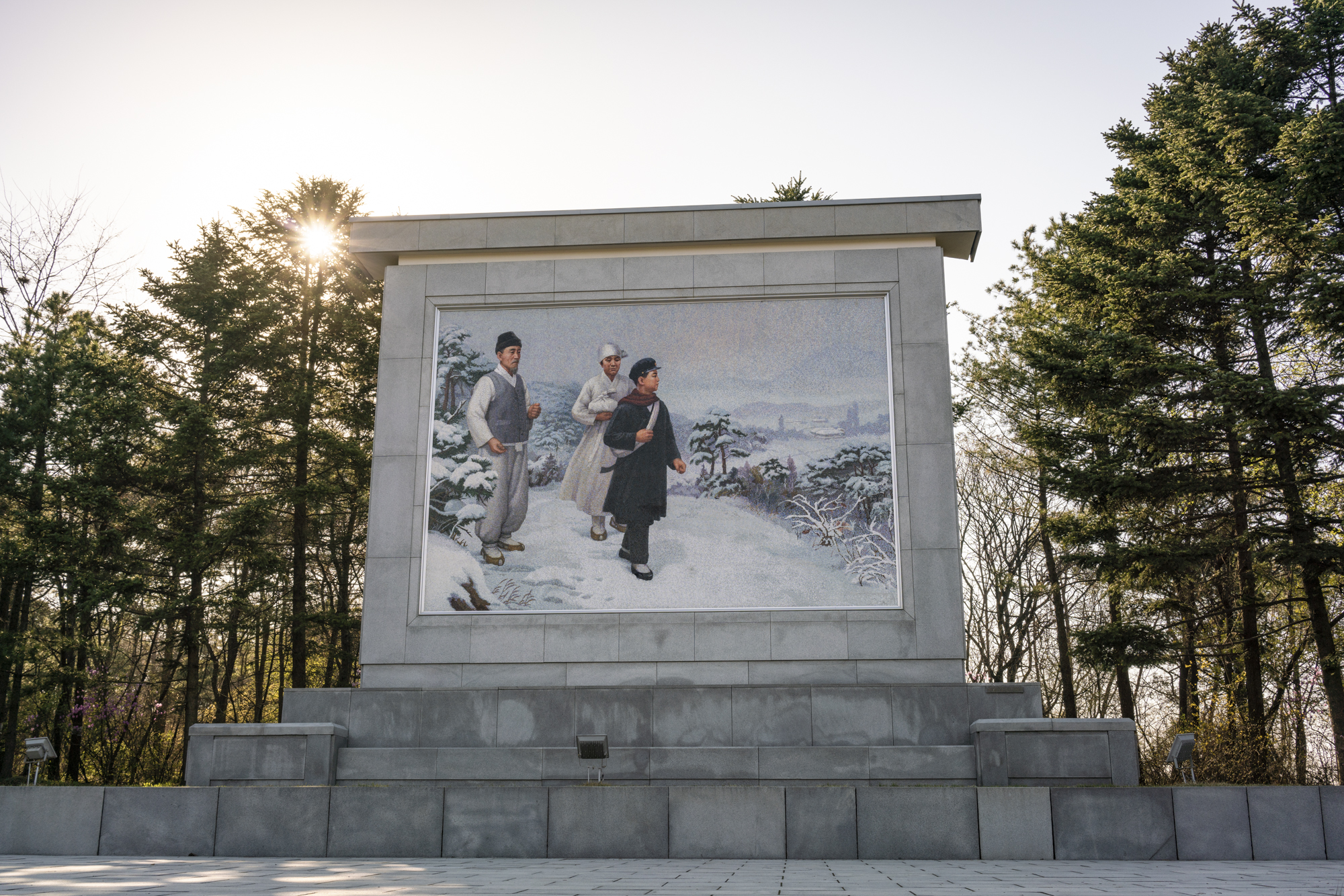
A mosaic depicting Kim Il Sung as a young man leaving home to lead the resistance against the Japanese.
Mangyongdae, just outside Pyongyang, is the birthplace of Kim Il Sung. The area, considered a sacred site, is a place of revolutionary pilgrimage and glorified as a North Korean cultural icon.
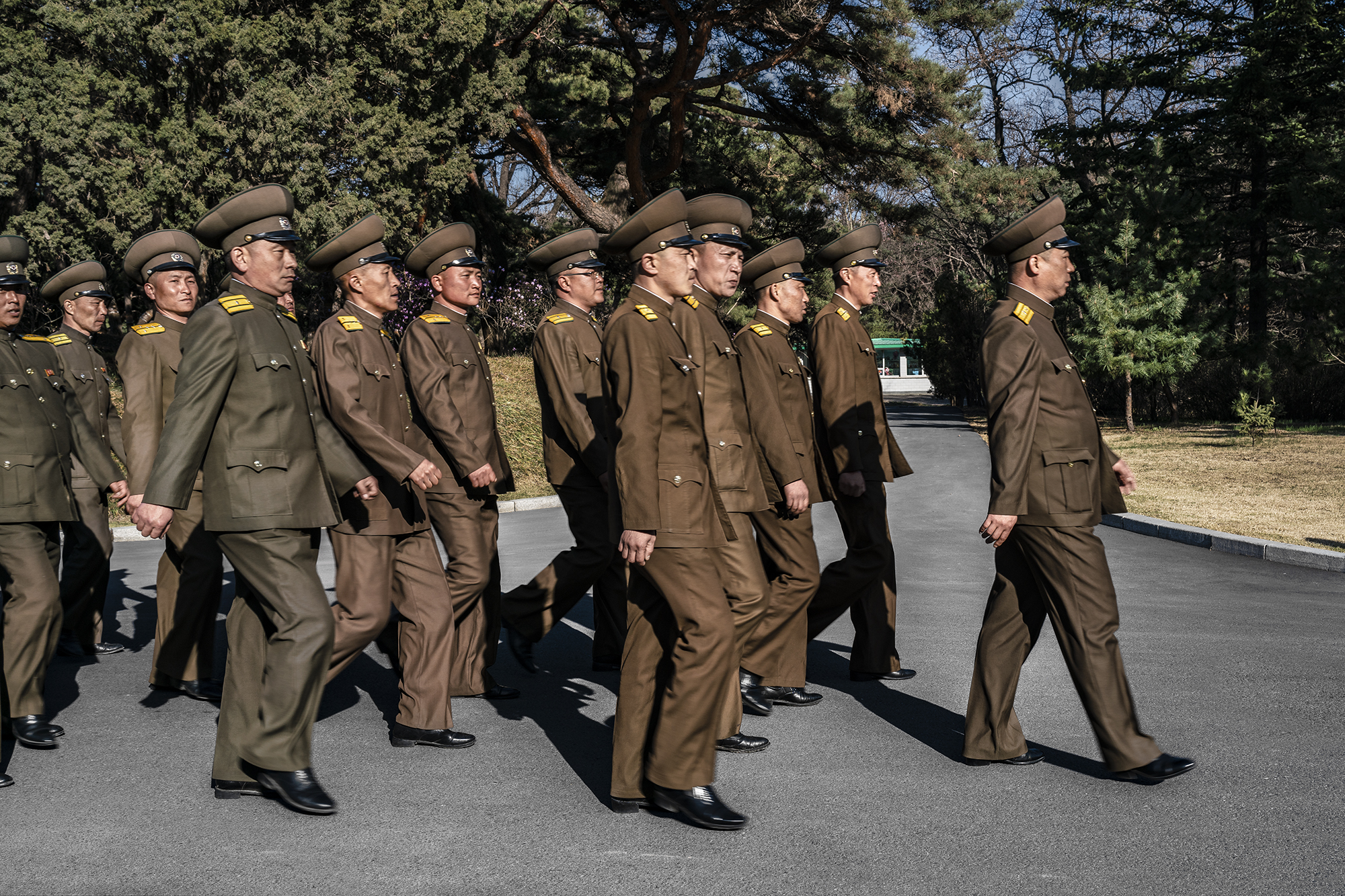
North Korean army officials marching in Mangyongdae, Pyongyang.
The area was designated as historic and listed as a revolutionary site by Kim Jong Il to solidify the North Korean cult of personality centred around him and his father, Kim Il Sung.
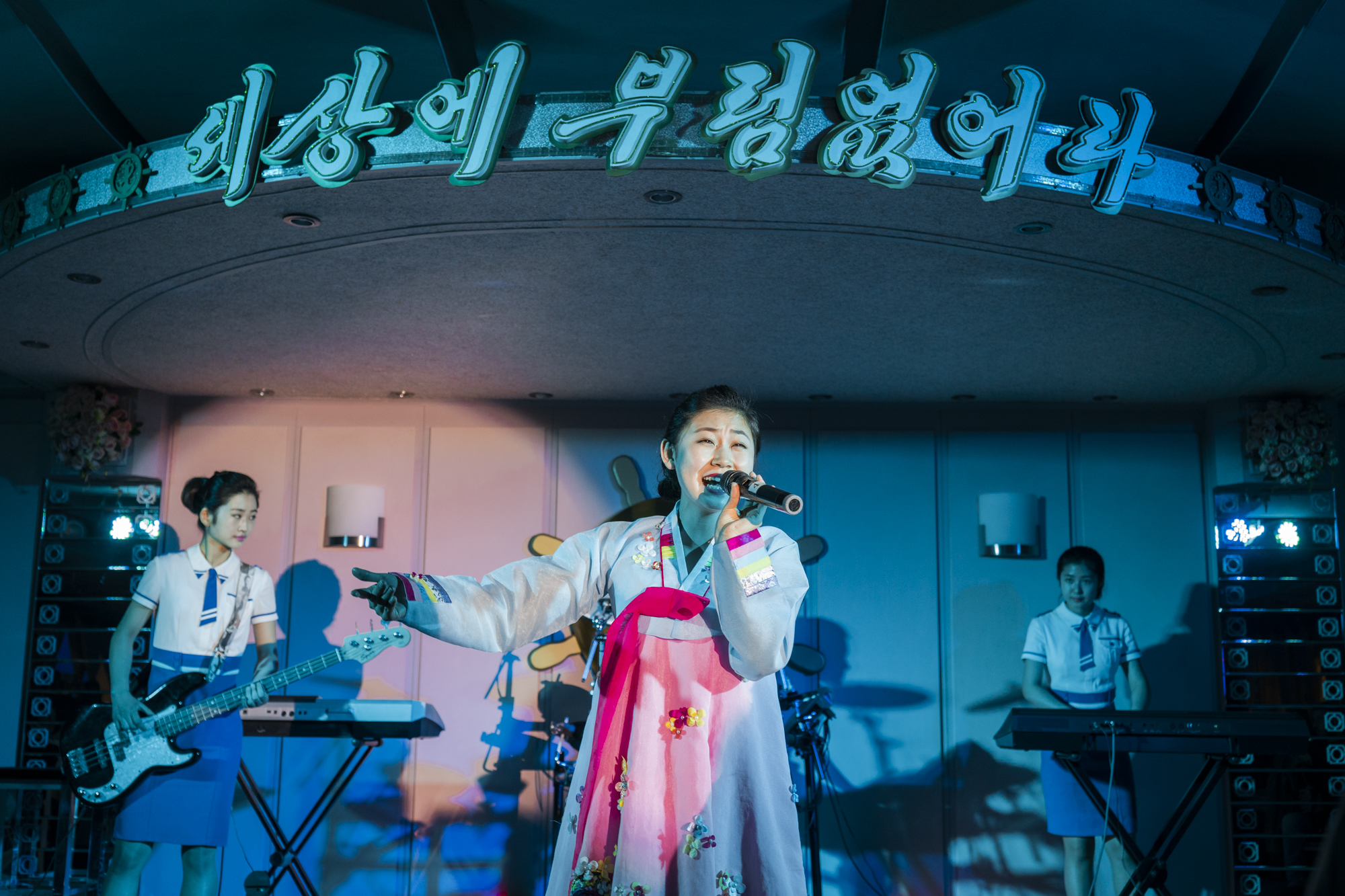
A traditional North Korean music performance by three young women in a Pyongyang restaurant open to foreigners.
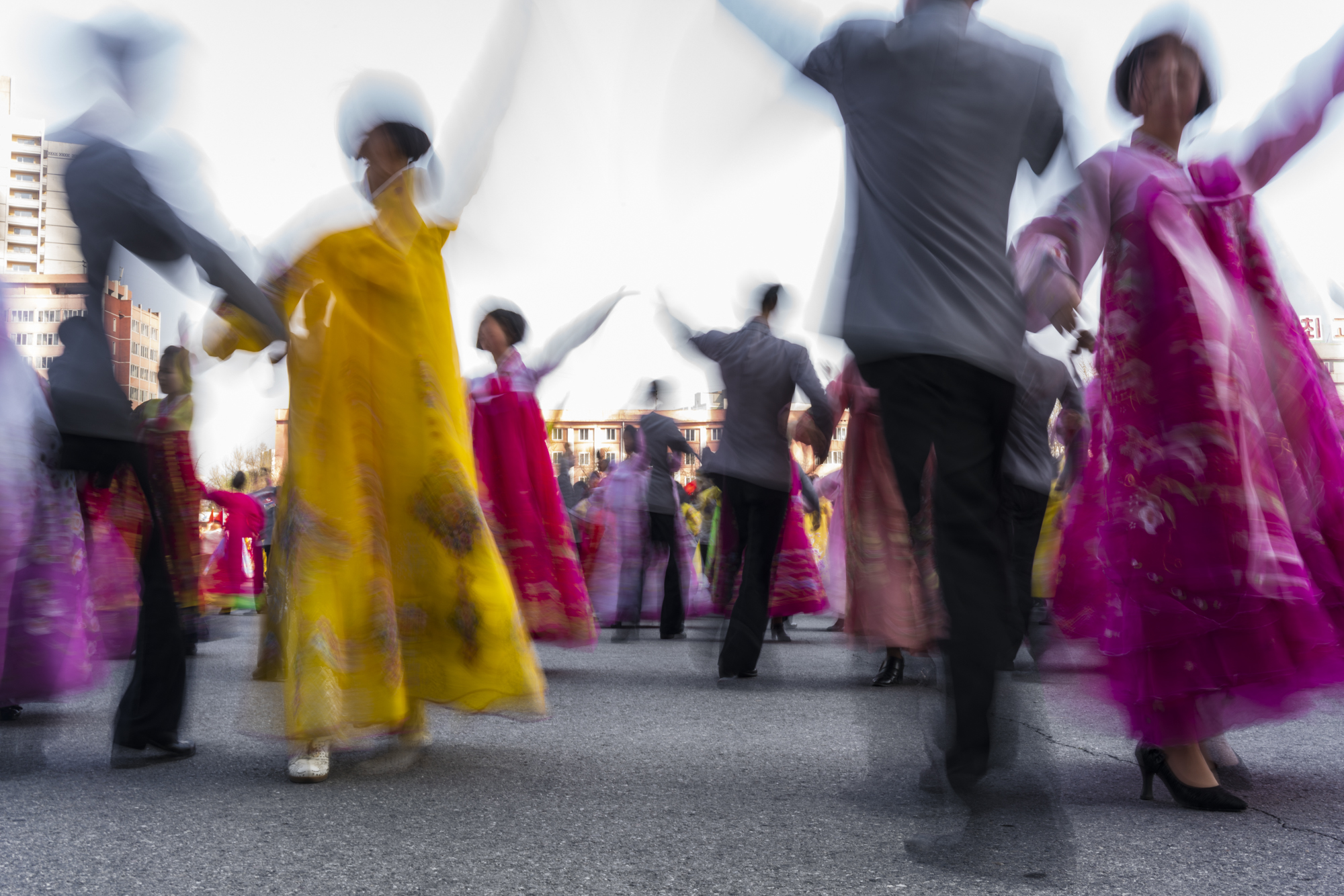
North Korean students perform at a Mass Dance in honour of the former Great Leader Kim Il Sung on his birthday anniversary in Pyongyang on April 15.
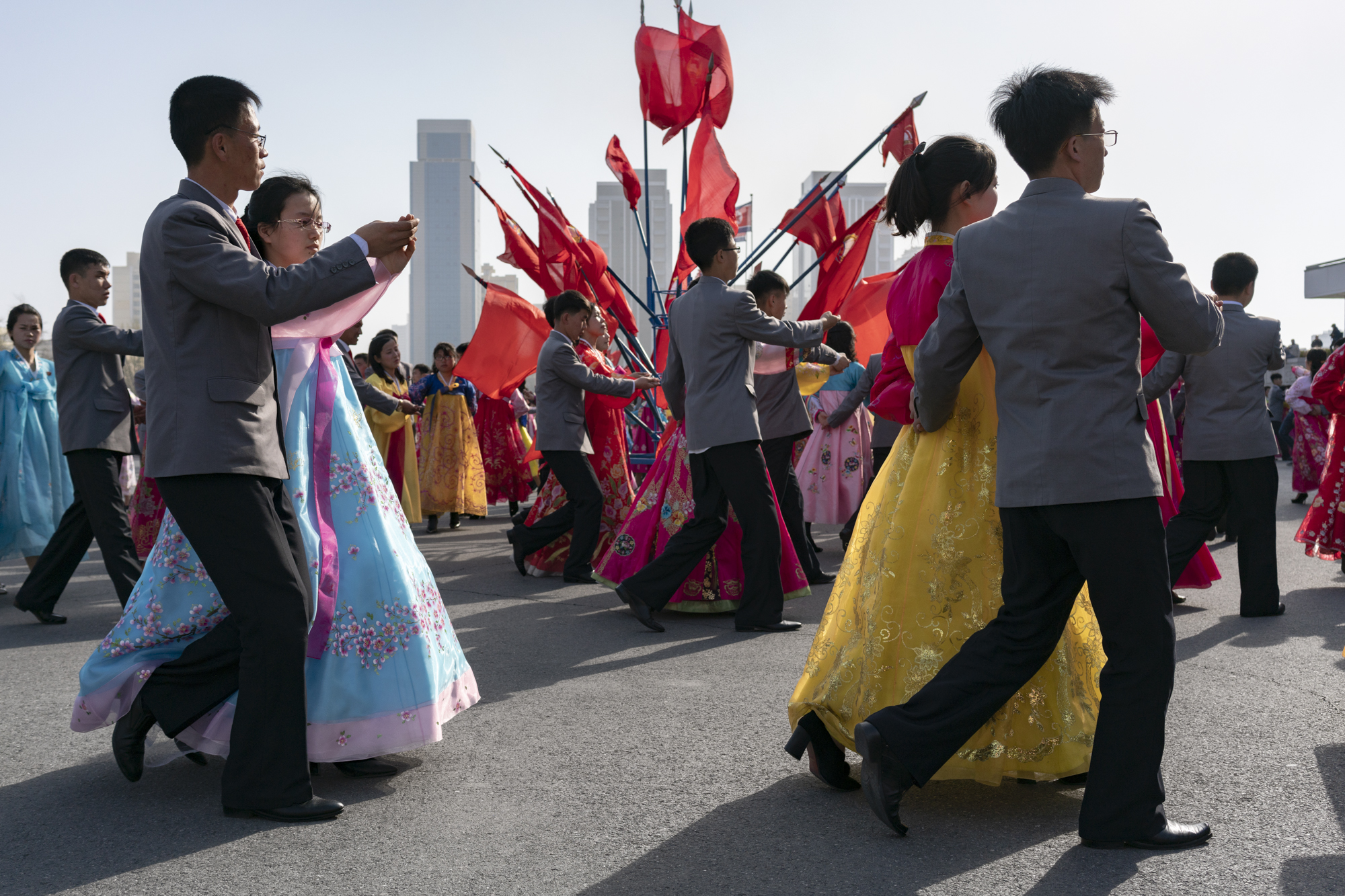
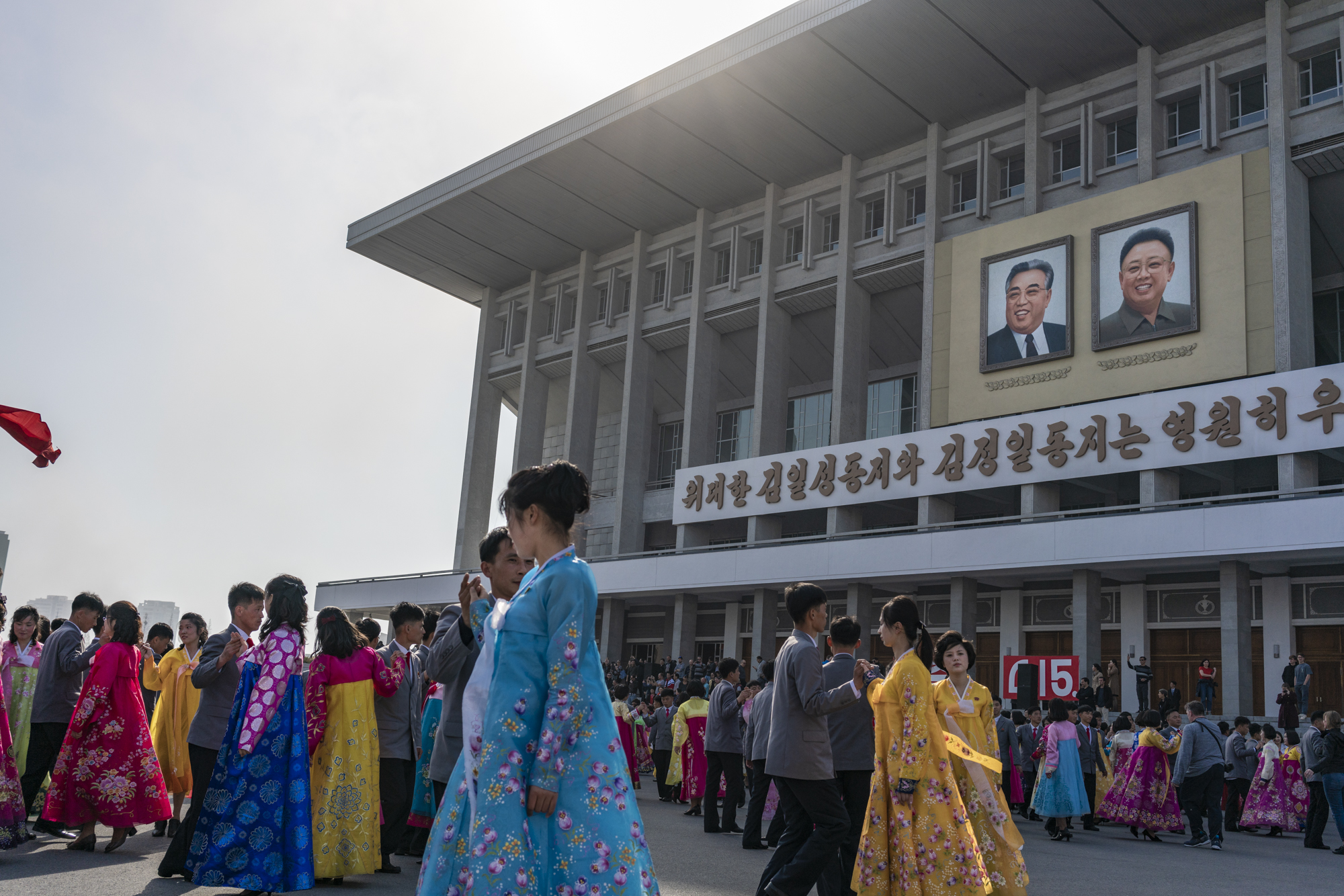
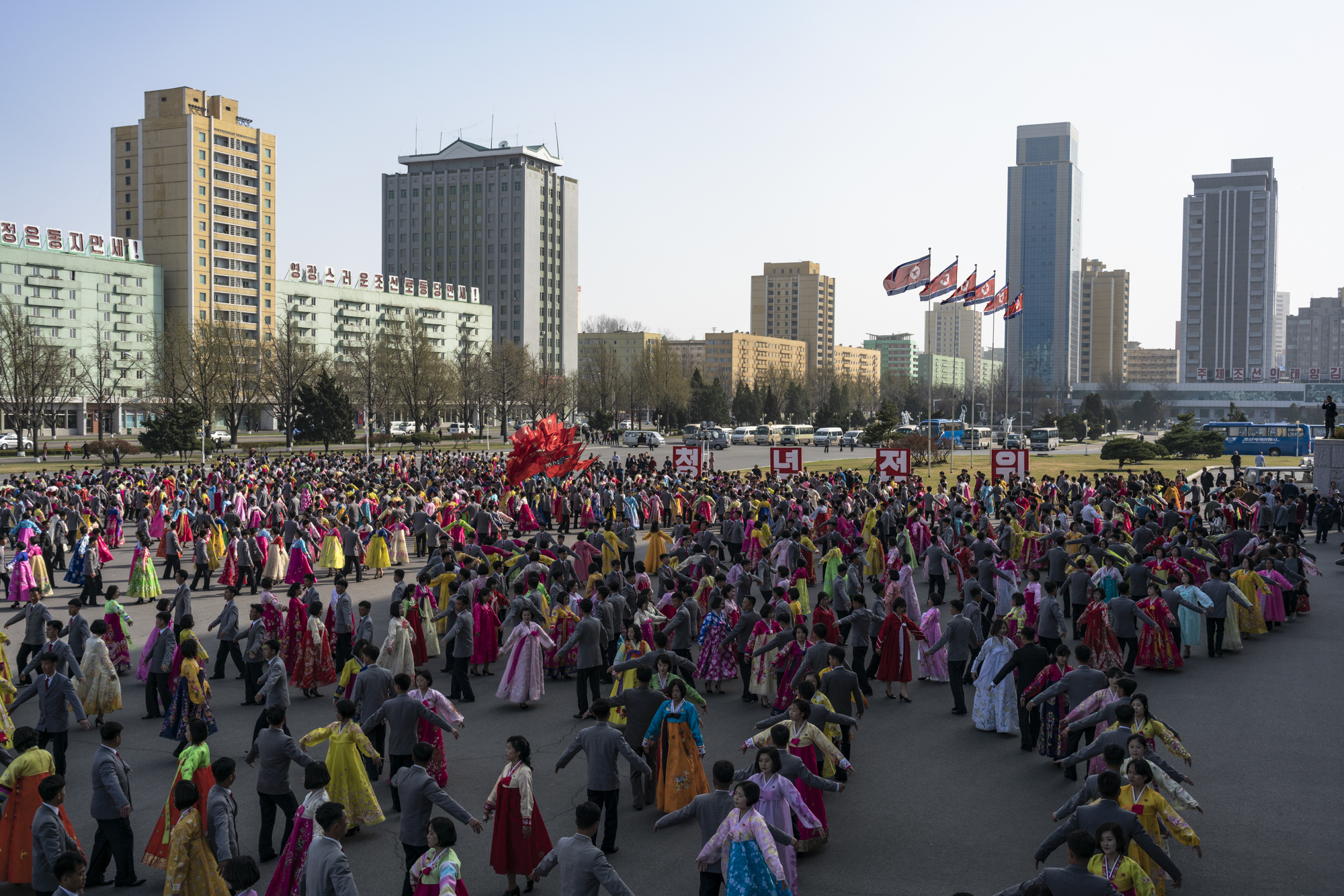
North Korean students perform at a Mass Dance in honour of the former Great Leader Kim Il Sung on his birthday anniversary in Pyongyang on April 15.
Mass Dances are large choreographed dances, accompanied by revolutionary and folk music, taking place at various locations around the country and can include hundreds to thousands of participants.
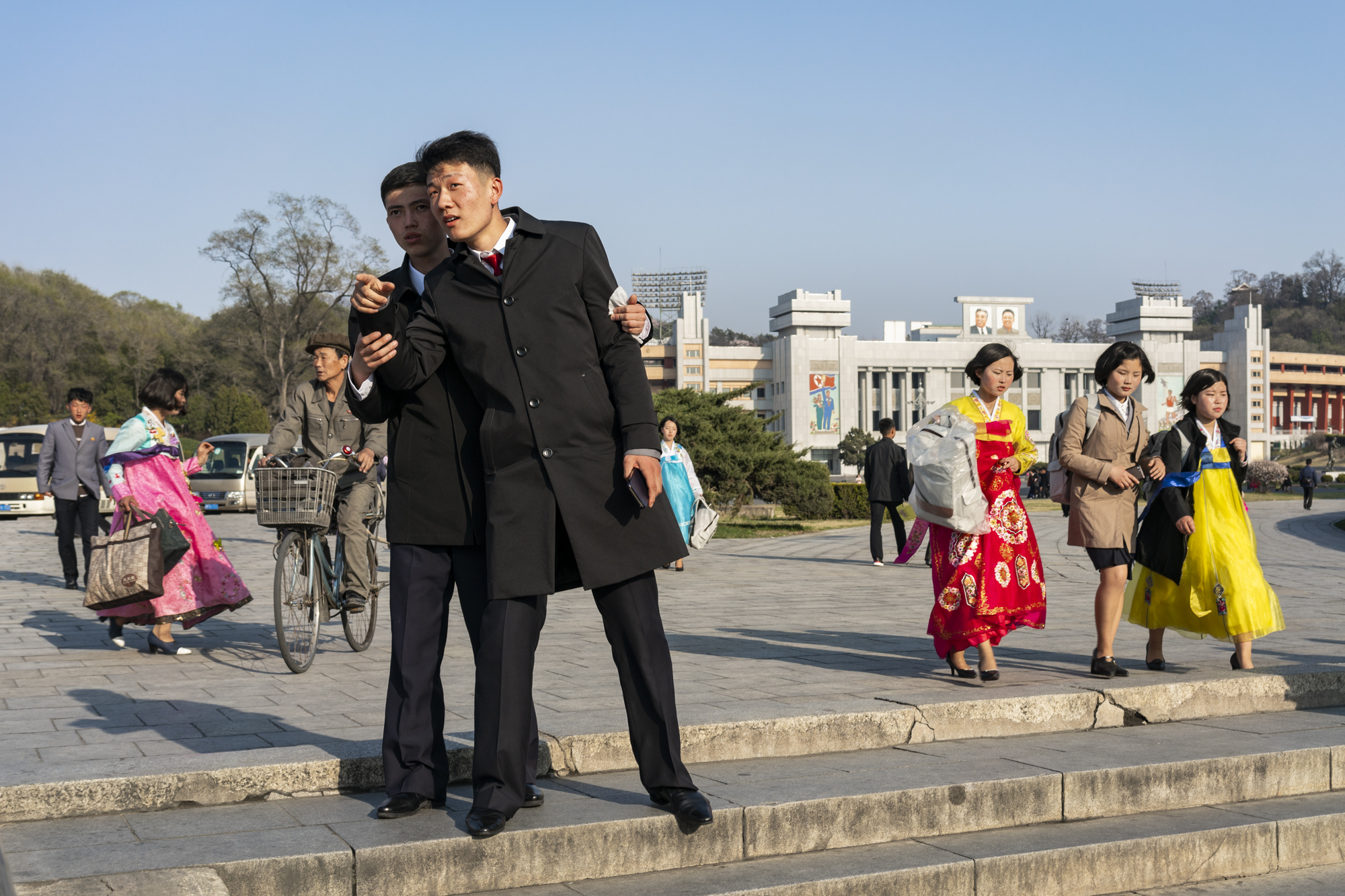
A street scene near the Kim Il Sung Stadium in Moran Hill, Pyongyang.
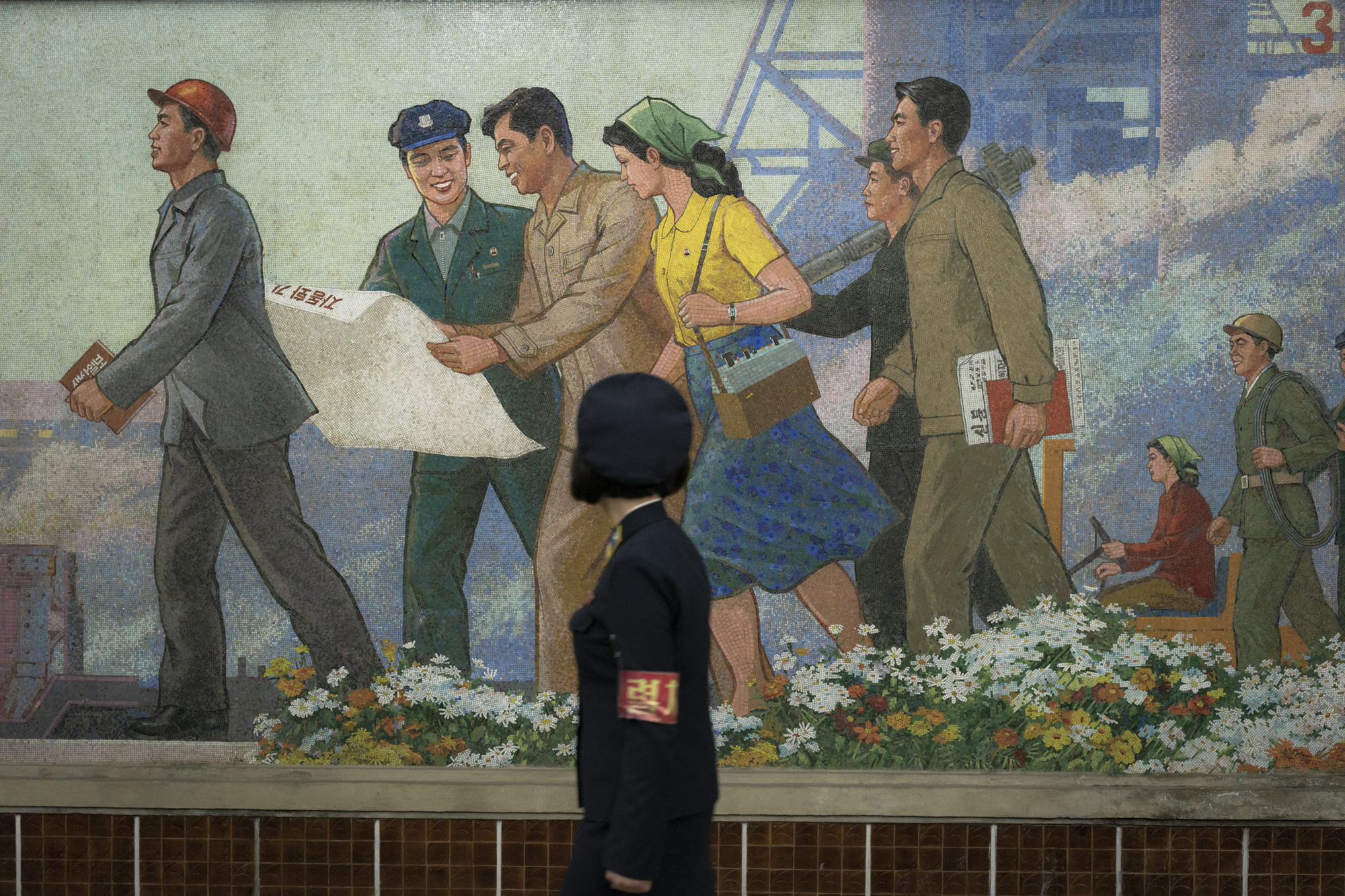
At Puhung (Prosperity) Station, built in 1987 and one of the many 100-metre deep subway stations on the Pyongyang subway network, a North Korean metro attendant is walking in front of one the many propaganda murals depicting revolutionary and socialist ideology.
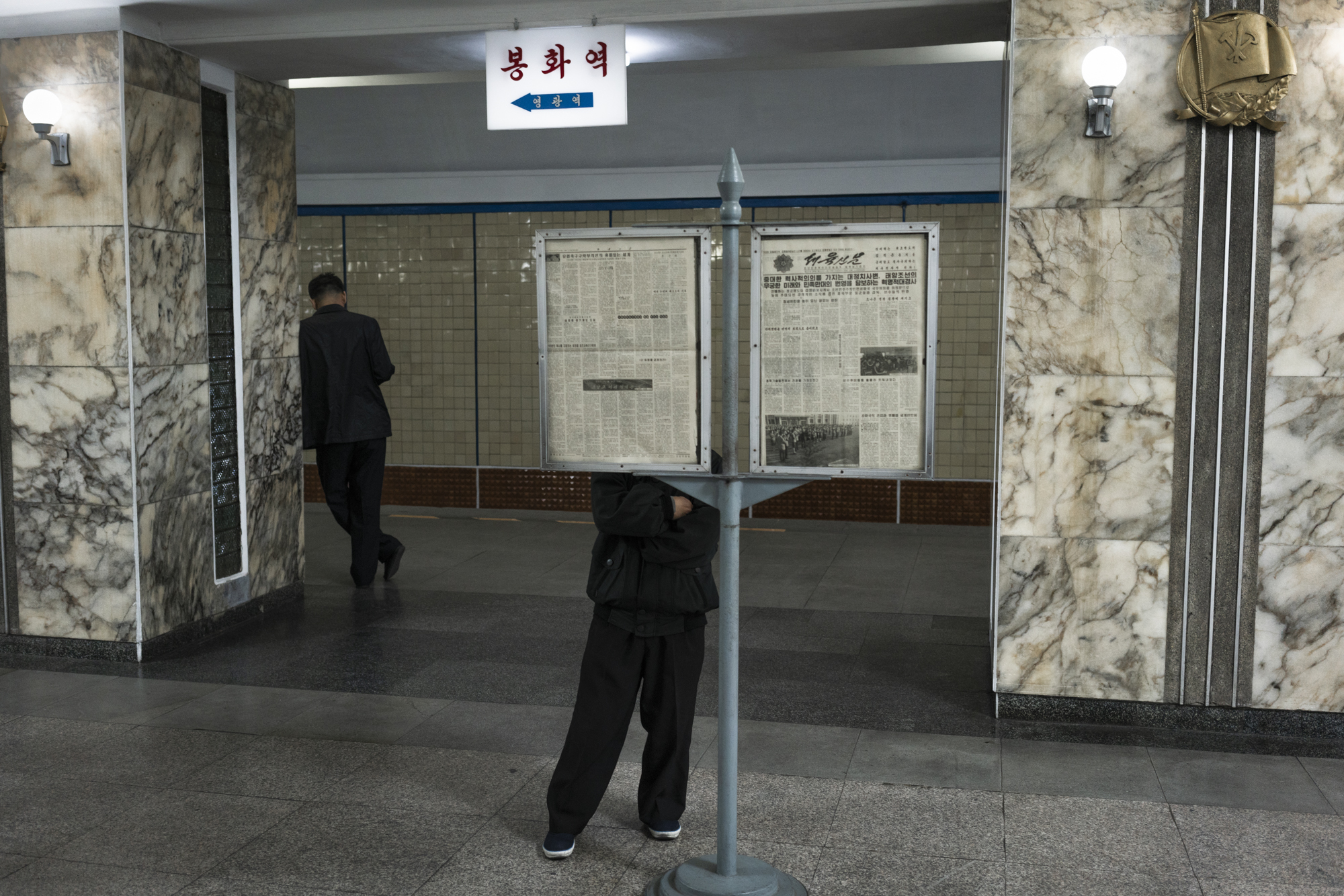
At the Pyongyang metro Station, on the Chollima Line, a commuter is reading a daily report of the official newspaper of North Korea’s ruling Workers’ Party while awaiting the train.
Newspapers in North Korea go through tight censorships by the PAD (Propaganda and Agitation Department).
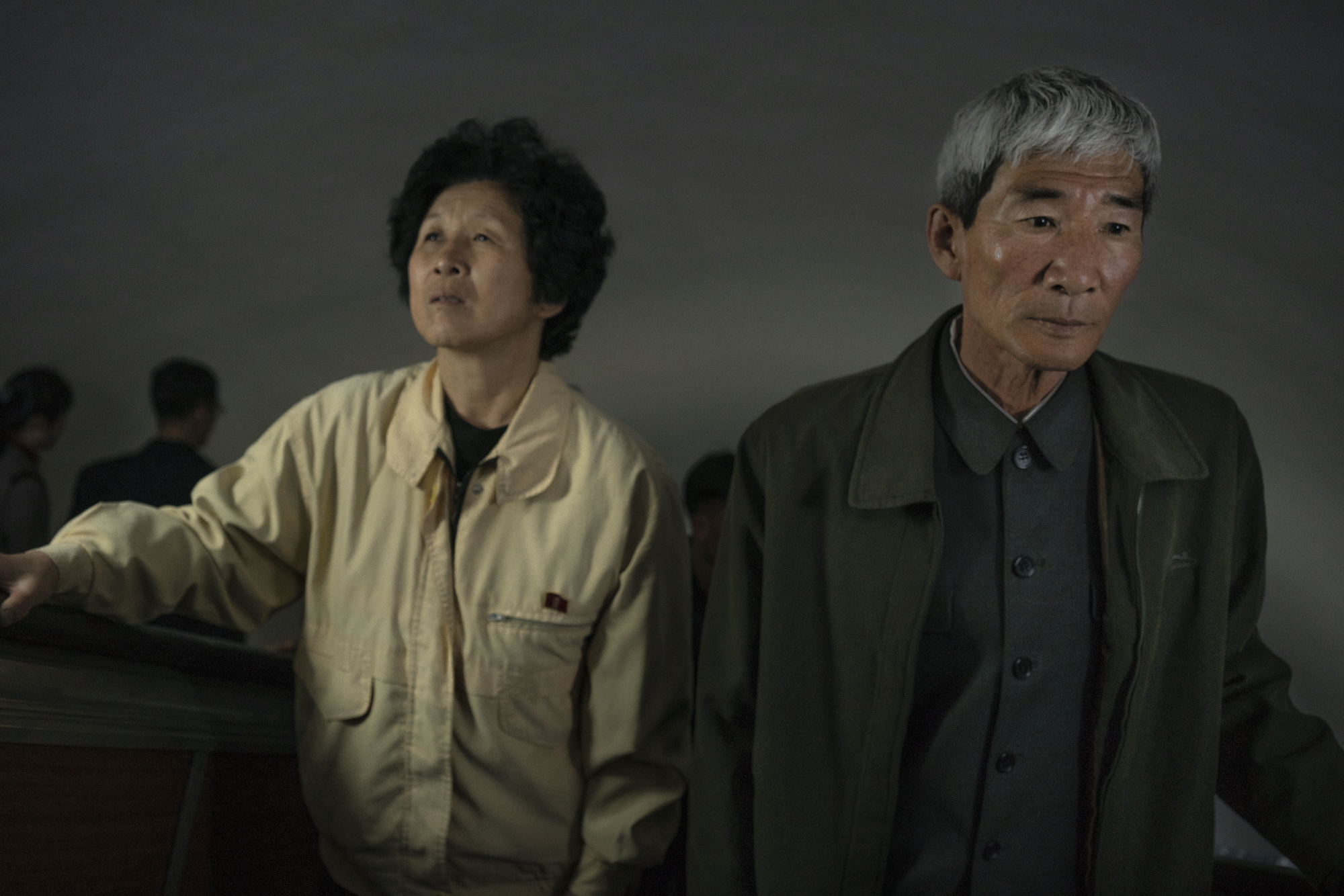
A North Korean couple rides the escalator in silence at the Pyongyang subway station.
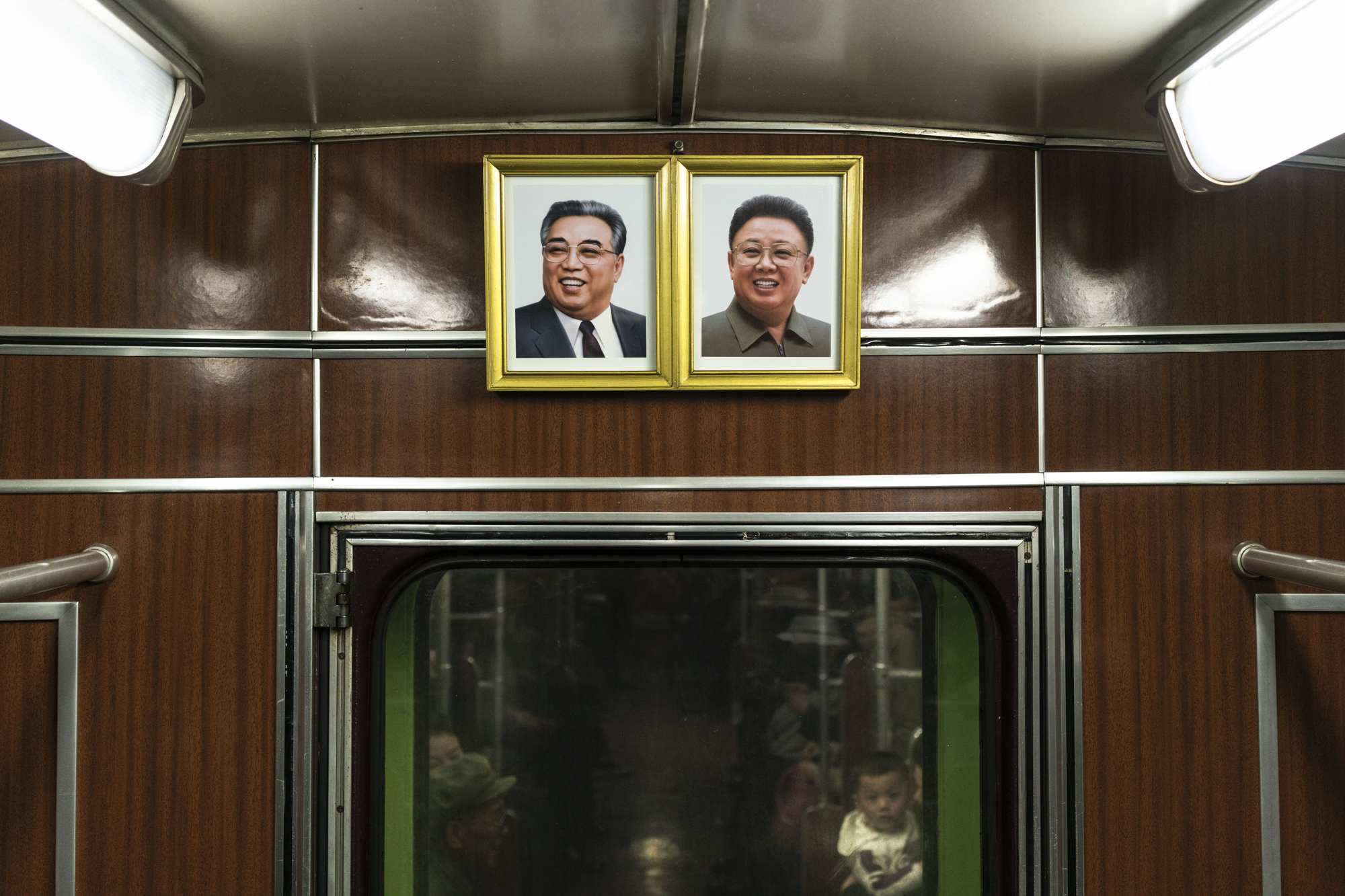
The centrality of the Leaders can be seen in everyday’s life. In the Pyongyang subway, portraits of Kim Il Sung and Kim Jong Il are present in every train carriage.
By law, the structures of the frames are made thicker on the top side and angled downwards to oversee the people in any room they are placed.
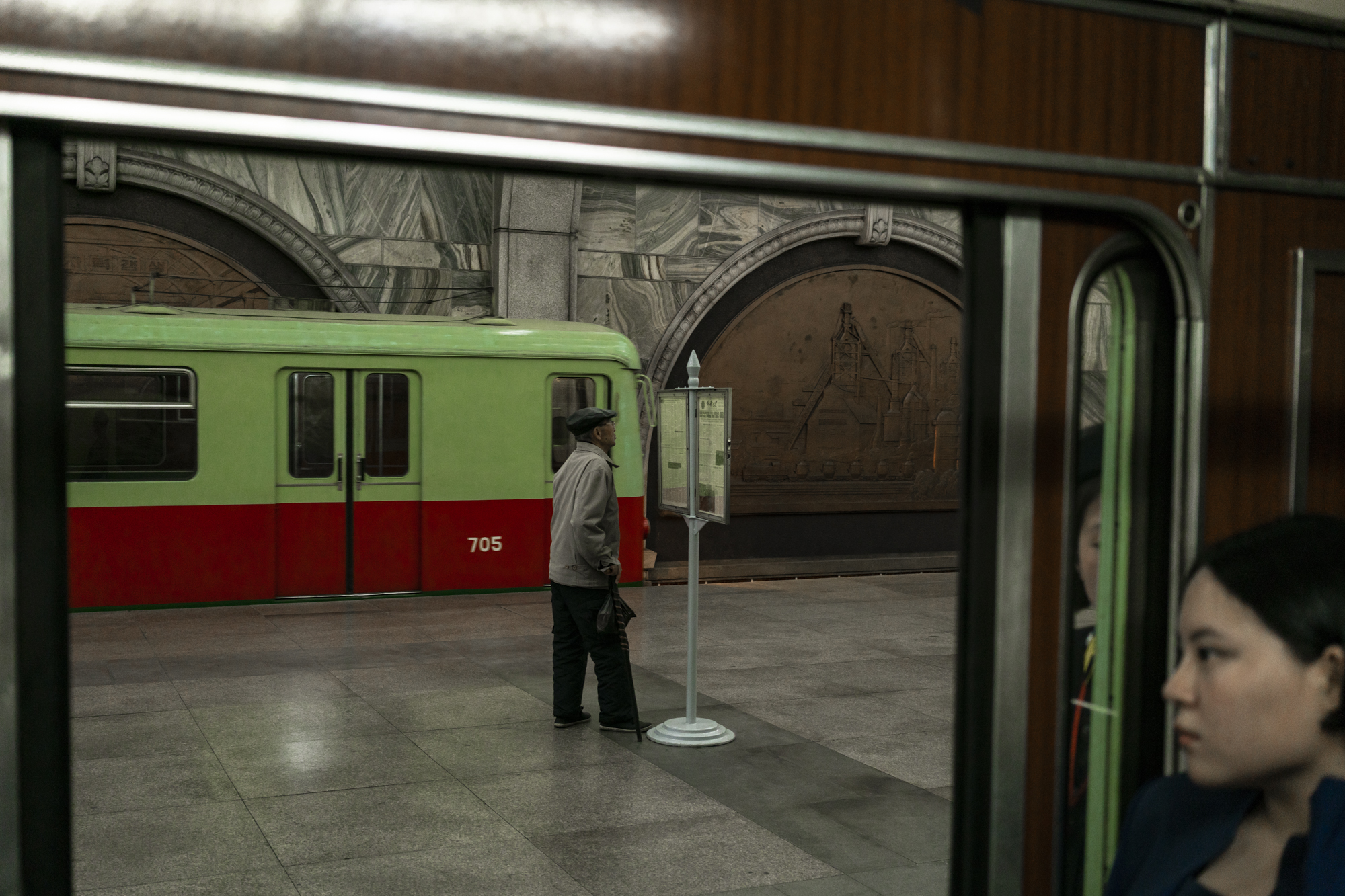
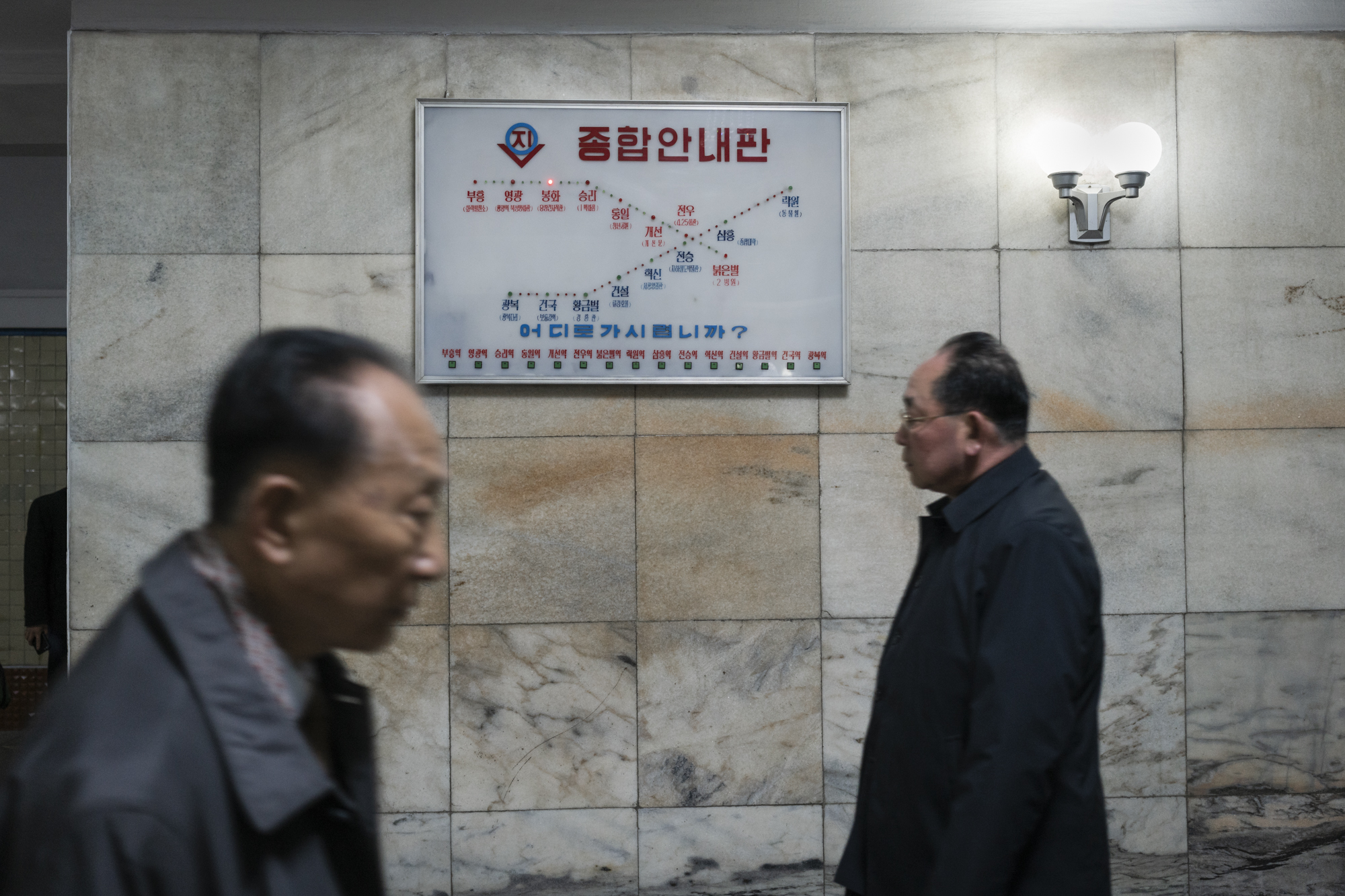
Commuters walking in front of an electronic board on the Chollima line at the Pyongyang metro Station.
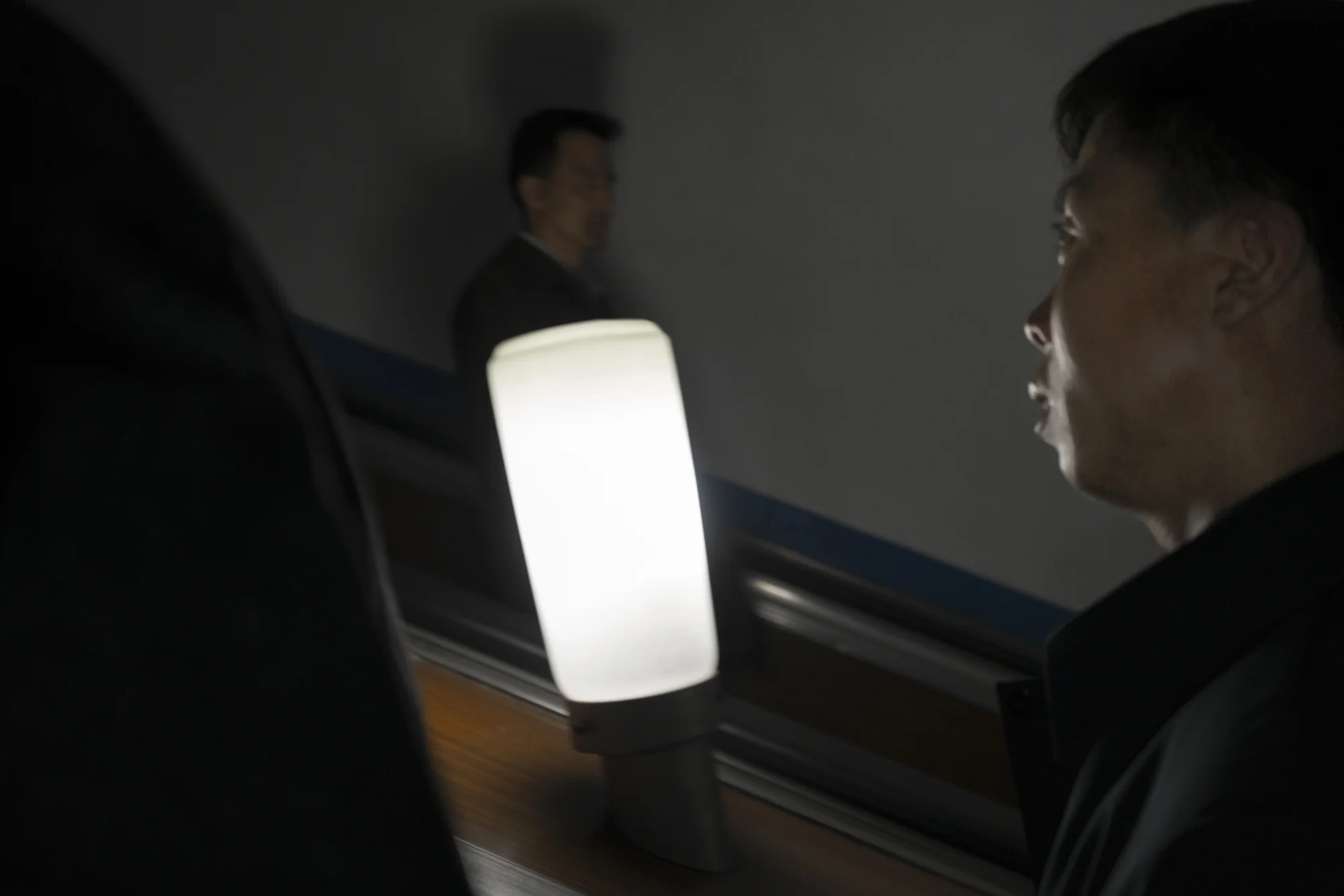
The Pyongyang Metro is the deepest subway system in the world at 110 metres with an almost four-minute descent to reach the train platforms.
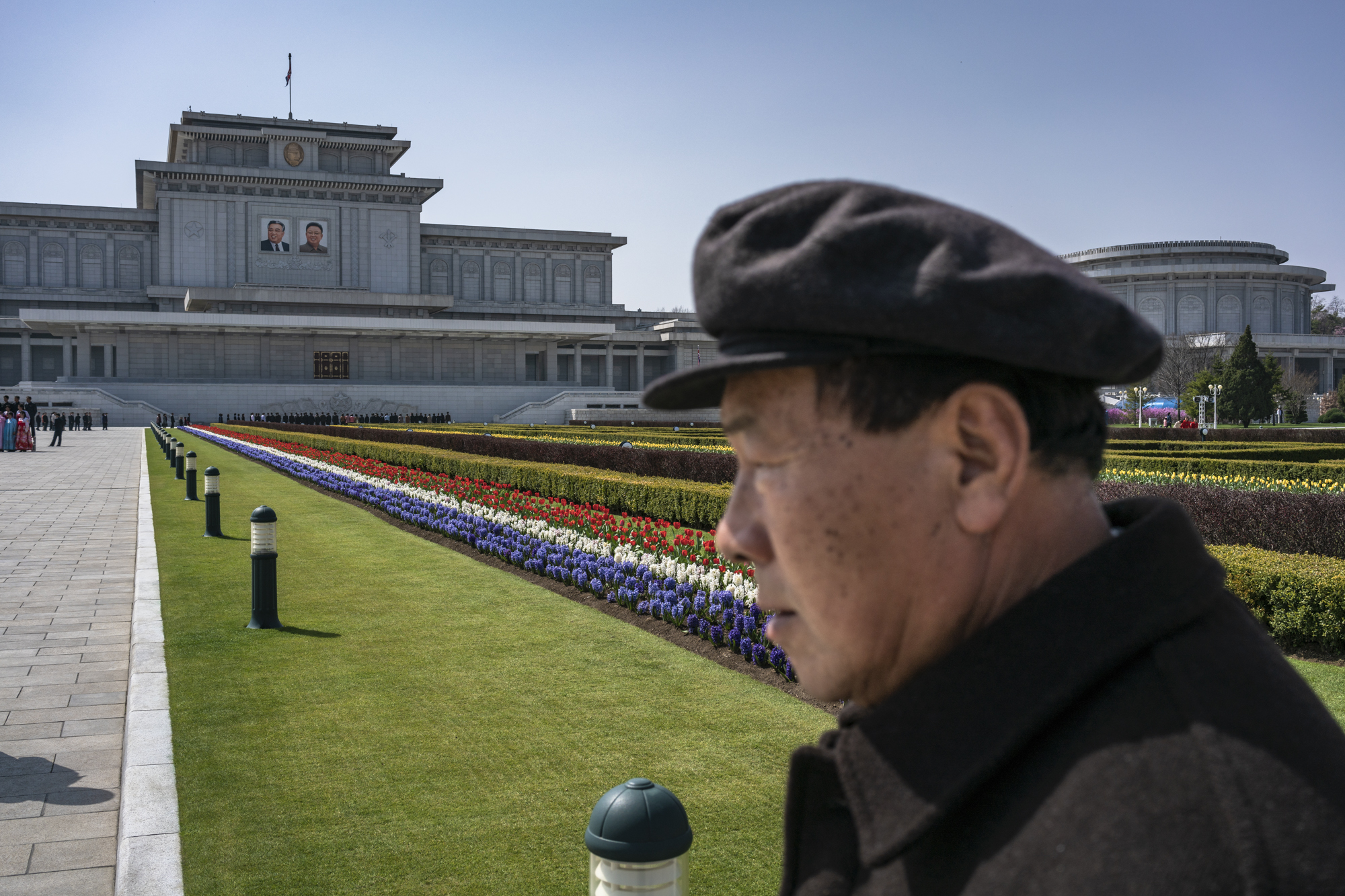
North Koreans pay tributes to nation founders Kim Il Sung and his son Kim Jong Il at the Kumsusan Memorial Palace of the Sun in Pyongyang, the largest structure in the world of its kind.
Although some Koreans will never get the chance to visit it, others living in or near the capital Pyongyang will visit on special occasions.
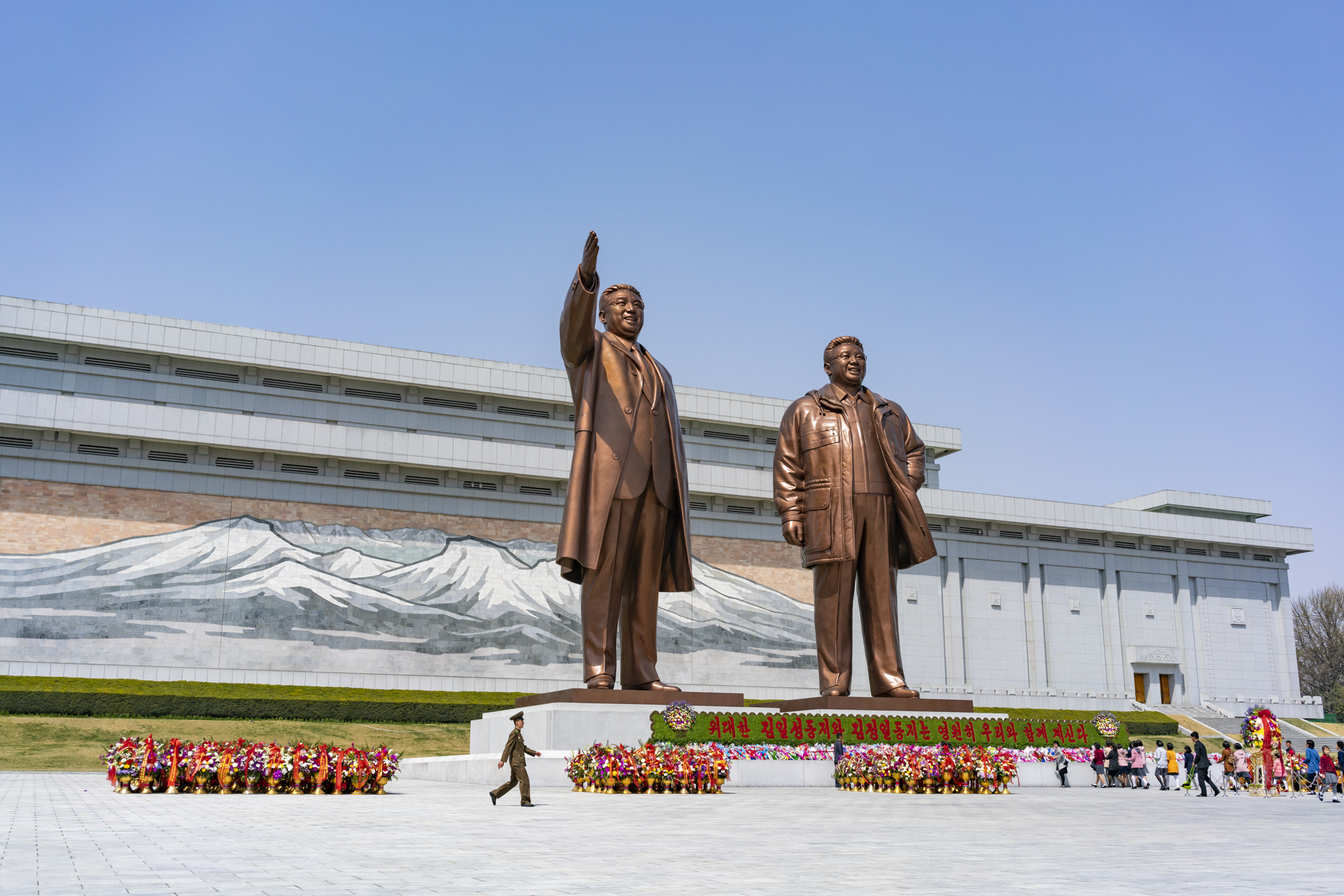
A North Korean soldier walks in front of the bronze statues of former North Korean leader Kim Il Sung and Kim Jong Il in Mansu Hill, Pyongyang, while citizens pay tribute bringing flowers on the birthday anniversary of the Eternal Leader.

The Juche Tower, also known as the Tower of the Juche Idea, located in Pyongyang on the Taedong river, represents the North Korean Juche ideology of independence promoted by North Korean founder Kim Il Sung, which could be defined as the ability of men and women to be in charge of their own destinies in order to make the nation great.
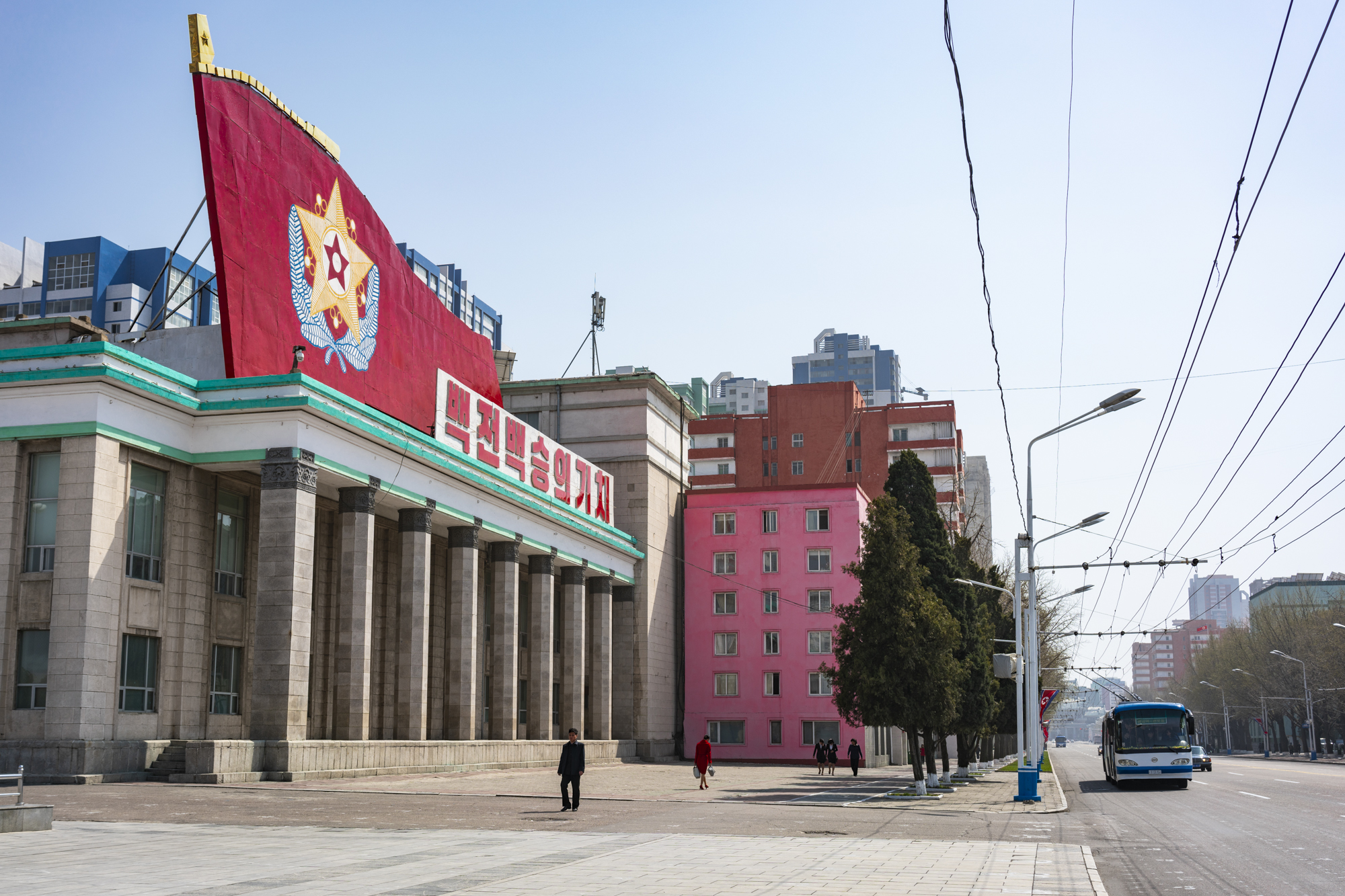
Building topped by revolutionary decoration, across from Kim Il Sung Square.
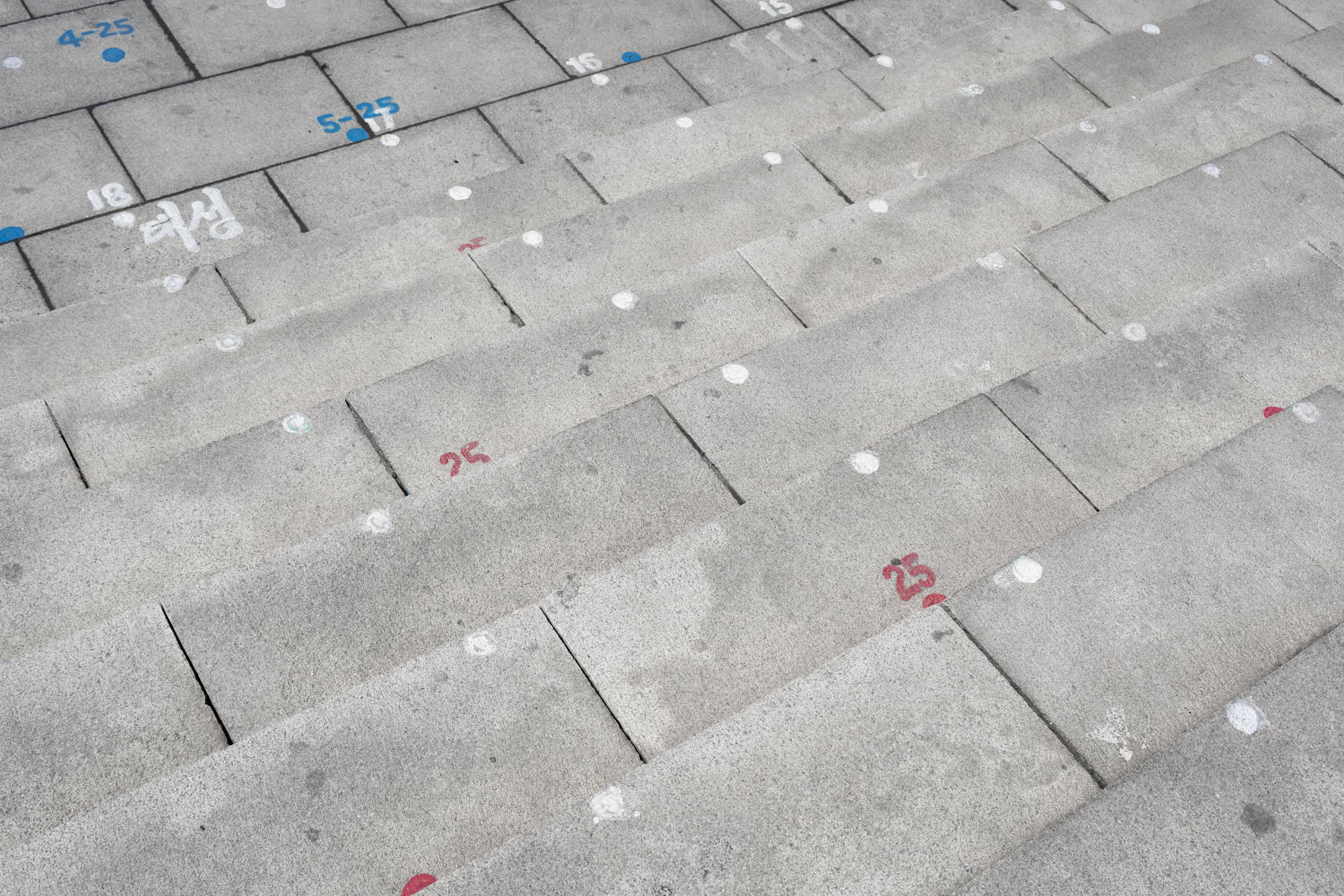
Markings on the floor of Kim II sung Square are used to guide positioning of parades and synchronised displays.
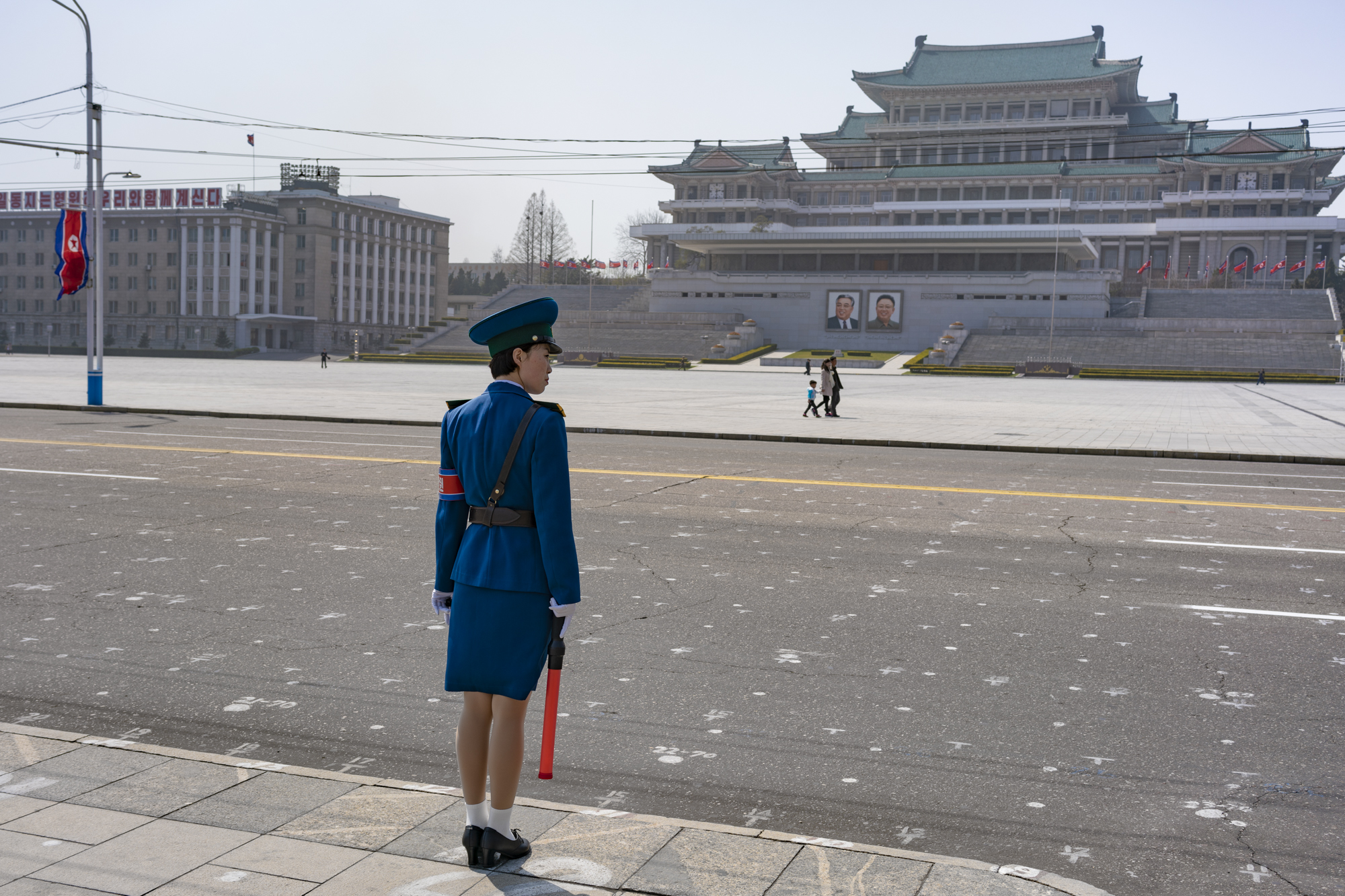
A North Korean traffic security officer stands on duty on a deserted intersection in Kim II Sung Square.
Chosen for their look and highly desired by the DPRK’s male population because of their beauty and high social status, the traffic officers have more privileges compared to the average North Korean citizens, as like as receiving better pay, more food per day, free housing and health care.
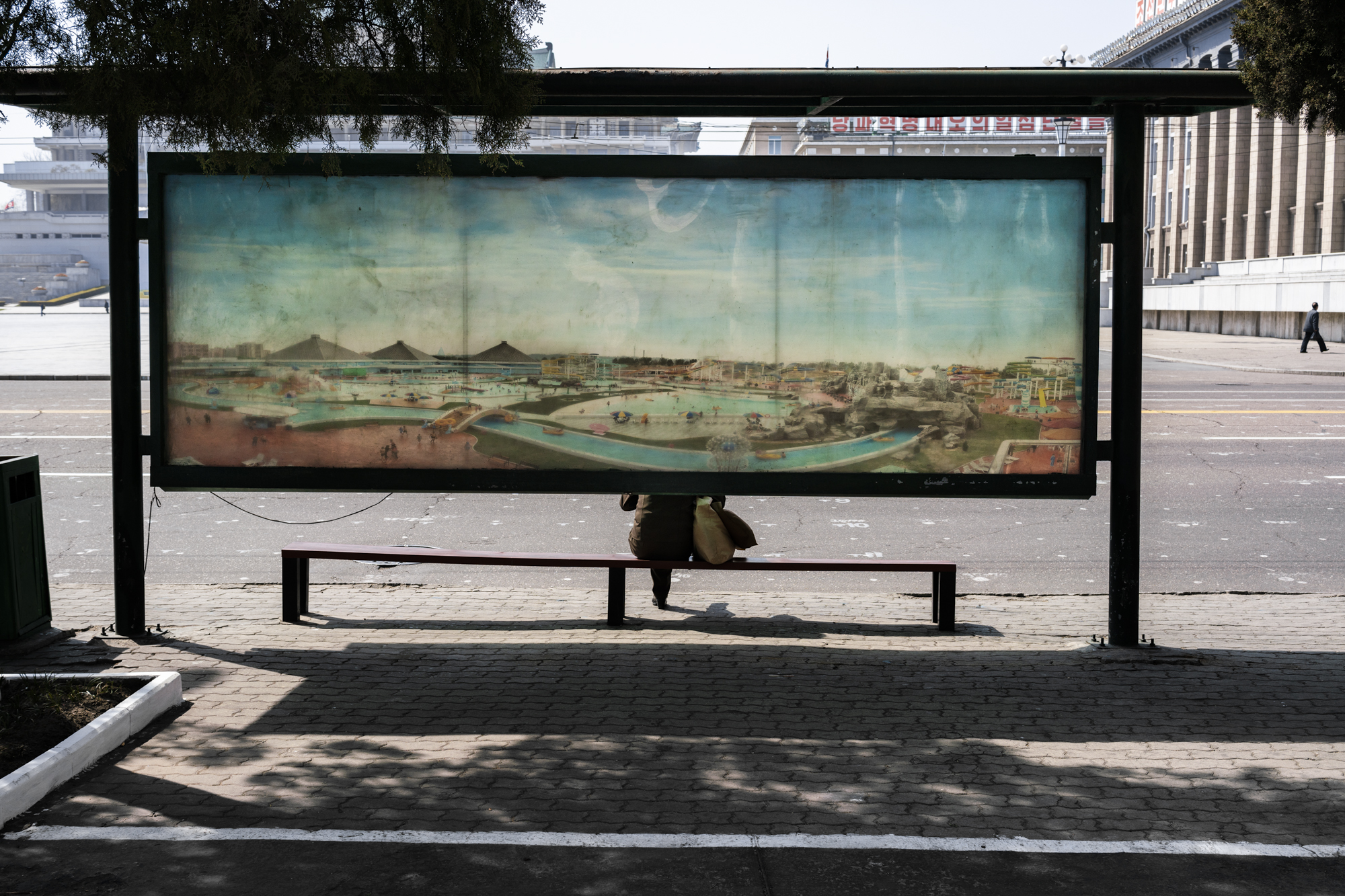
Street scene. A woman is waiting for a bus in Kim Il Sung Square.
The back of the bus stop itself is a large-scale print of the Munsu Water Park, a state run water park located in the east of Pyongyang.
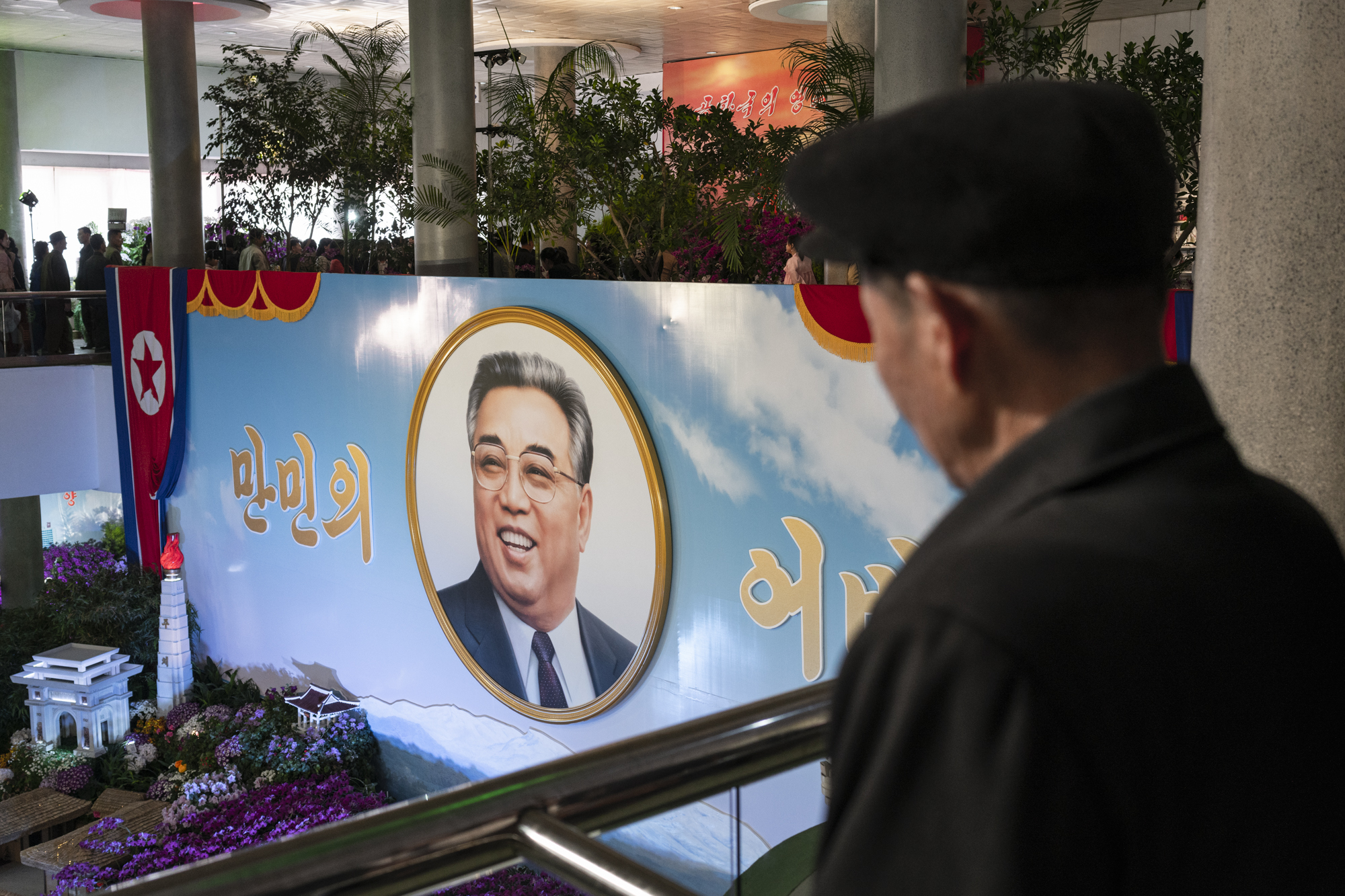
On the birthday anniversary of the former Leader Kim Il Sung , on April 15, North Koreans pay tributes visiting the Kimilsungia and Kimjongilia Flower Exhibition Hall in Pyongyang, two flowers named after Kim Il Sung and Kim Jong Il respectively.
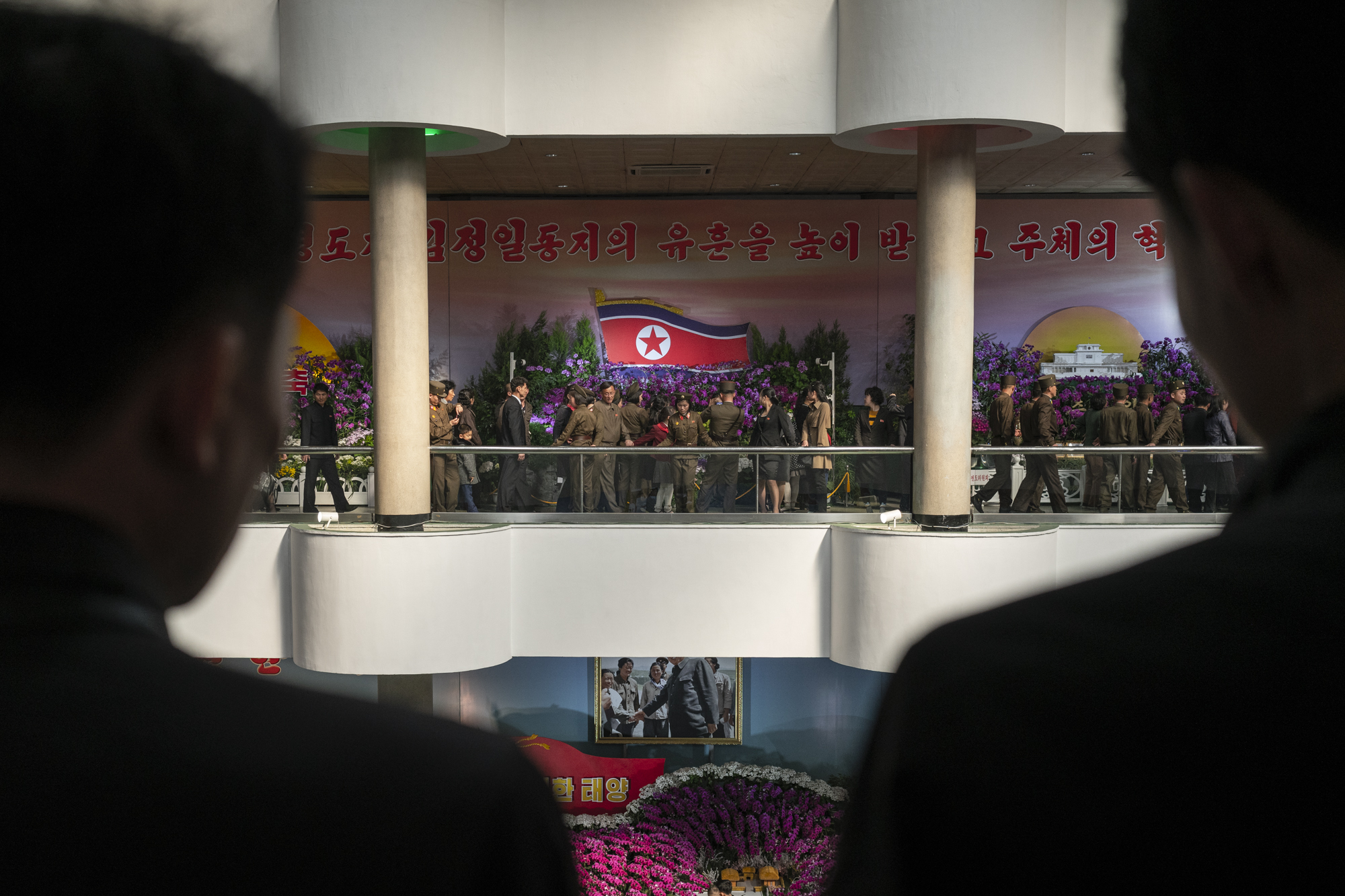
On special occasions, soldiers from all over the country are taken on trips to Pyongyang to visit and pay their respects to the Great Leaders, such as on the birthday anniversary of the former Leader Kim Il Sung, on April 15.

On the birthday anniversary of the former Great Leader Kim Il Sung, thousands of North Koreans visit various monuments as the Kimilsungia and Kimjongilia Flower Exhibition Hall located by the Taedong riverside.
The Kimilsungia and Kimjongilia Flower Exhibition is one of the highlighted events in North Korea. Citizens from all over the country arrive here to commemorate and to pay tributes to their late Leaders.
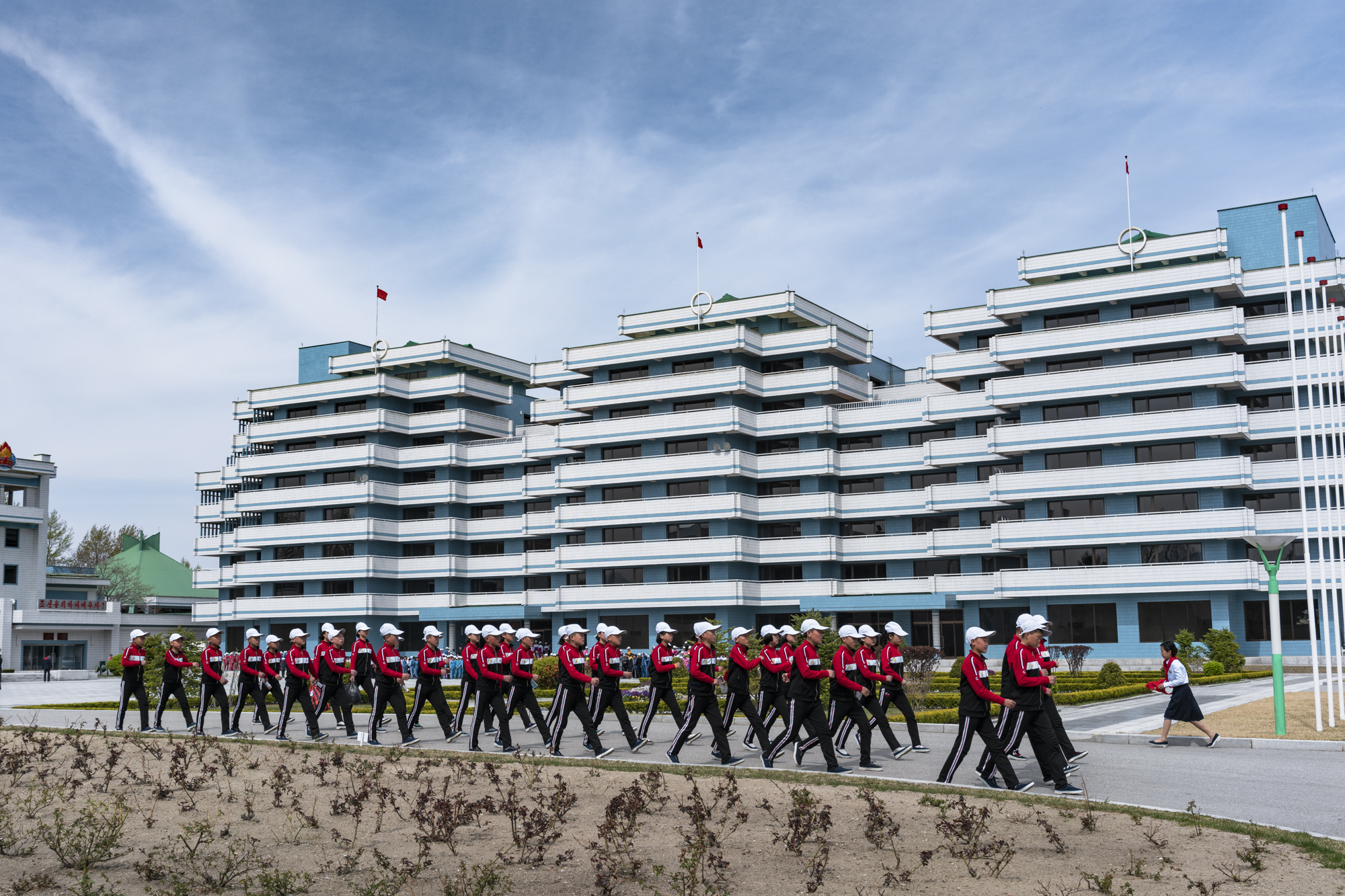
North Korean students marching in the front yard of the Songdowon International Children’s Camp, located in the Kangwŏn Province outside of Wŏnsan city.
The camp’s experience allows children to make connections worldwide, as well as helping open North Korea to the world.
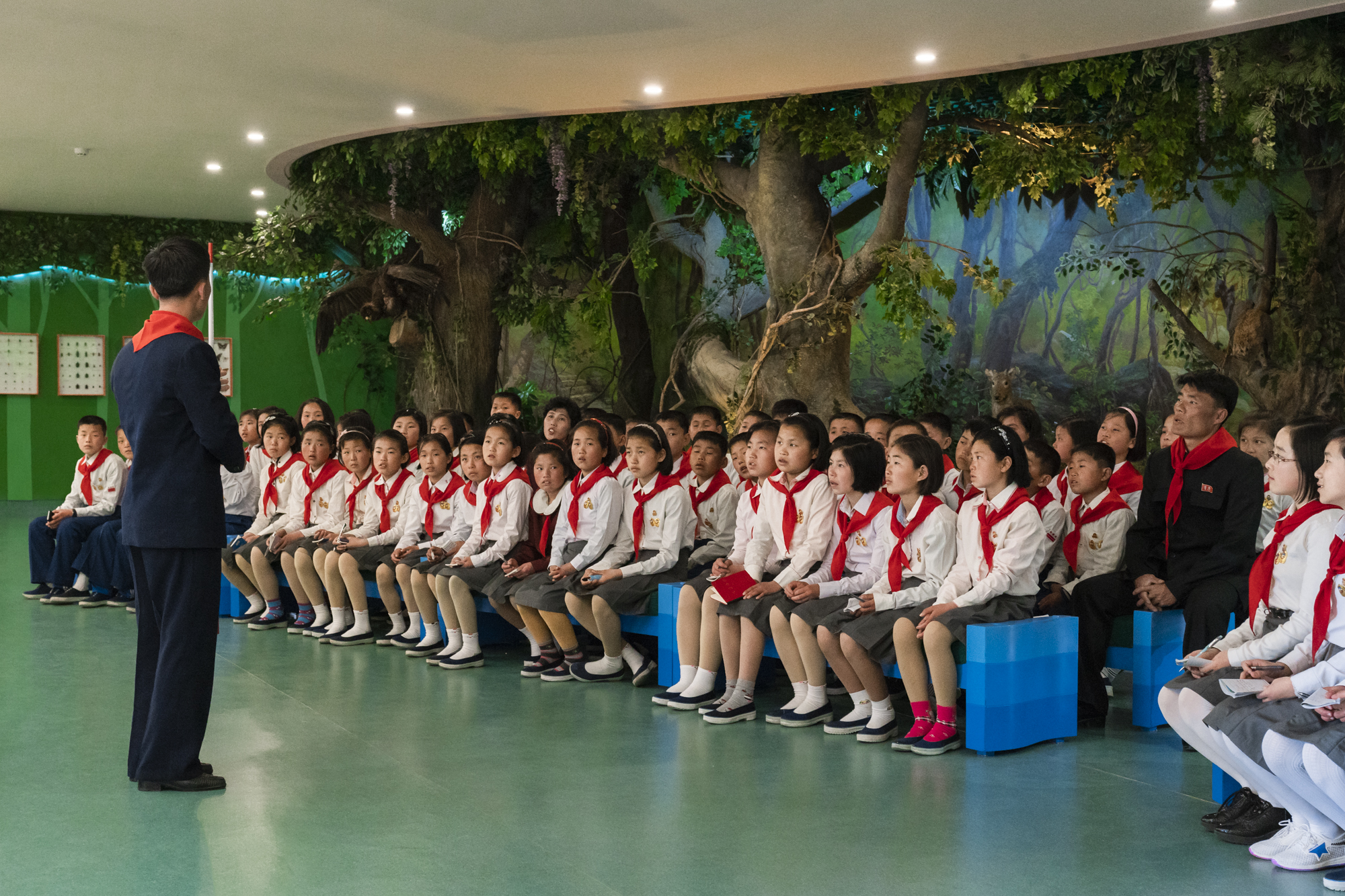
Students of the Songdowon International Children’s Camp are told by their teacher to revere the“Great Leader” Kim Il Sung.
The Political indoctrination starts at a young age in North Korea, where propaganda about the Eternal Leader and his Juche philosophy permeates all aspects of life.
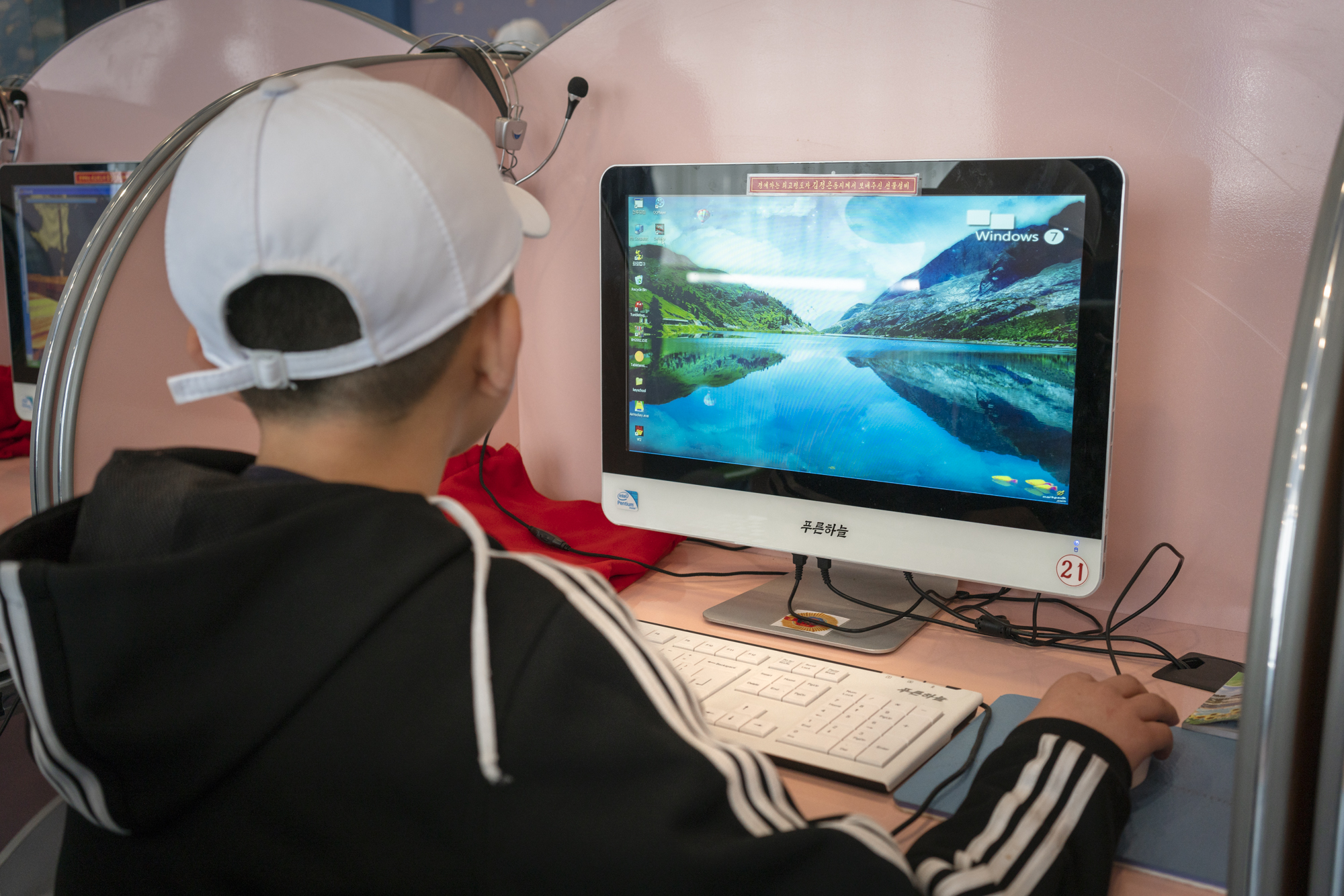
At the Songdowon International Children’s Camp, computers seem to be using Windows 7 software.
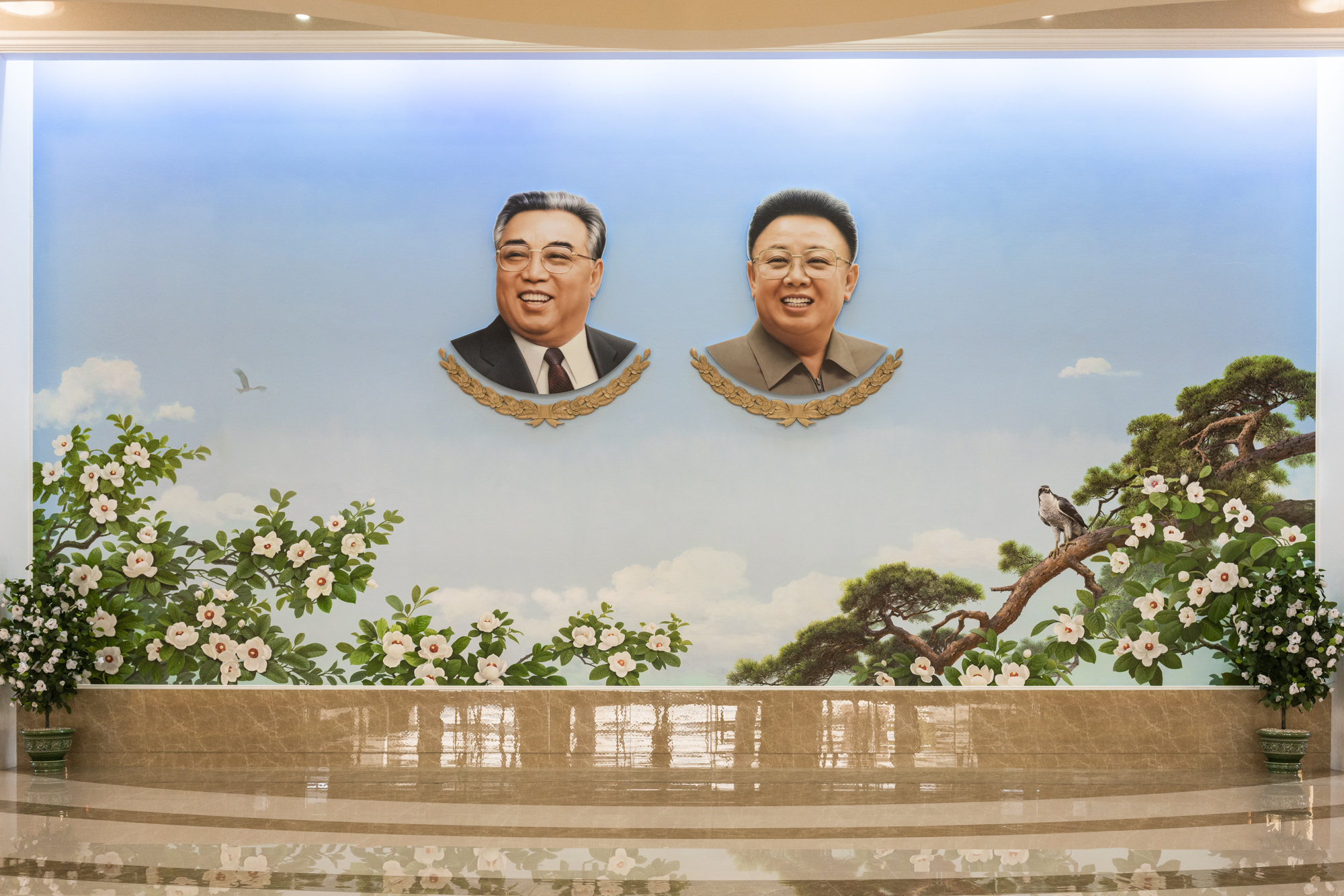
Cut out portraits of the North Korean former Leaders on a huge wall-painting depicting the national symbols – a northern goshawk and the magnolia flower, chosen for the purity perceived by its white colour.
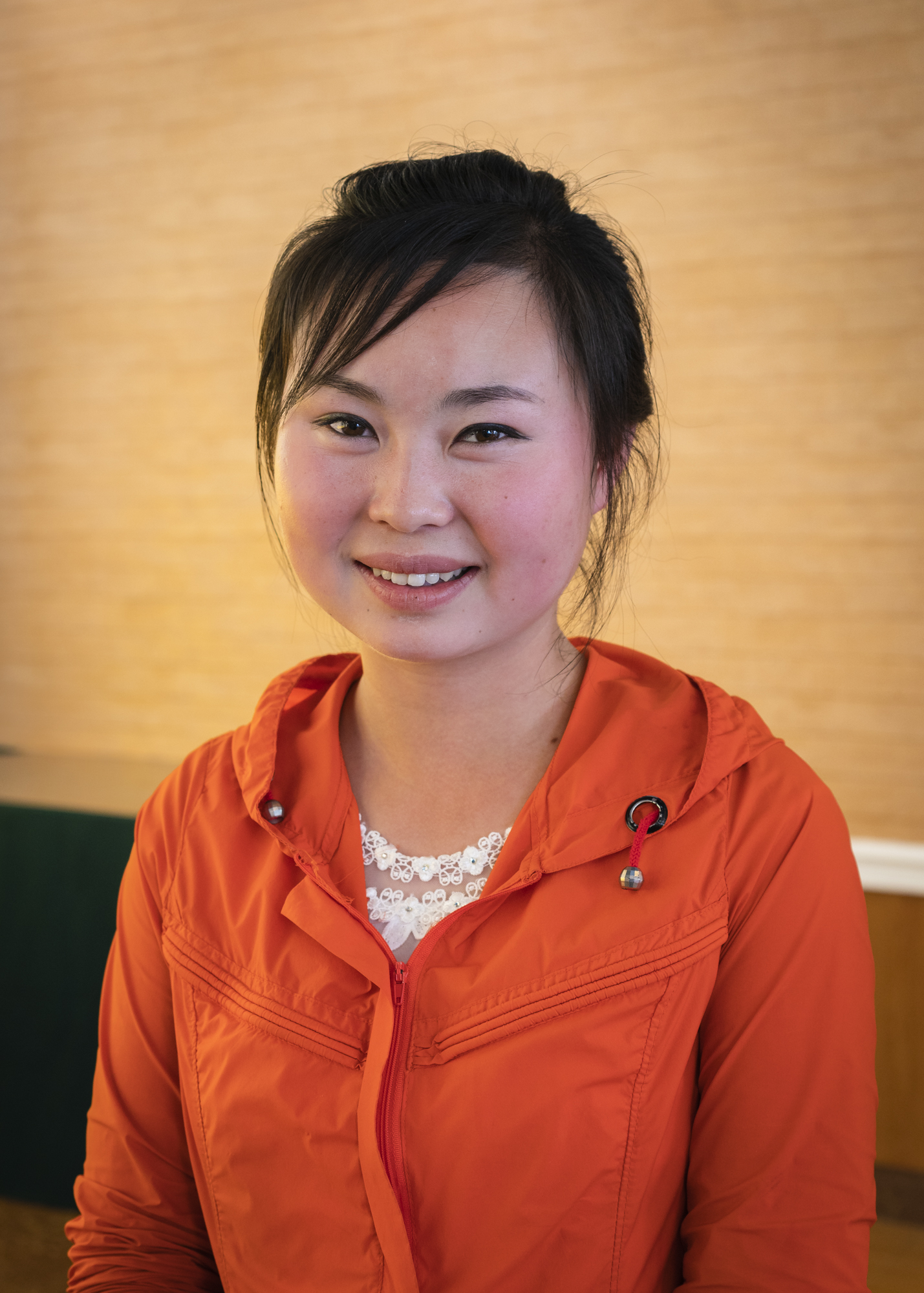
Portrait of a young woman working at the Songdowon International Children’s Camp.
At first afraid to be caught interacting with a foreigner by the omnipresent minders, she agreed to be photographed after hiding herself behind a column in one of the camp’s dining rooms.
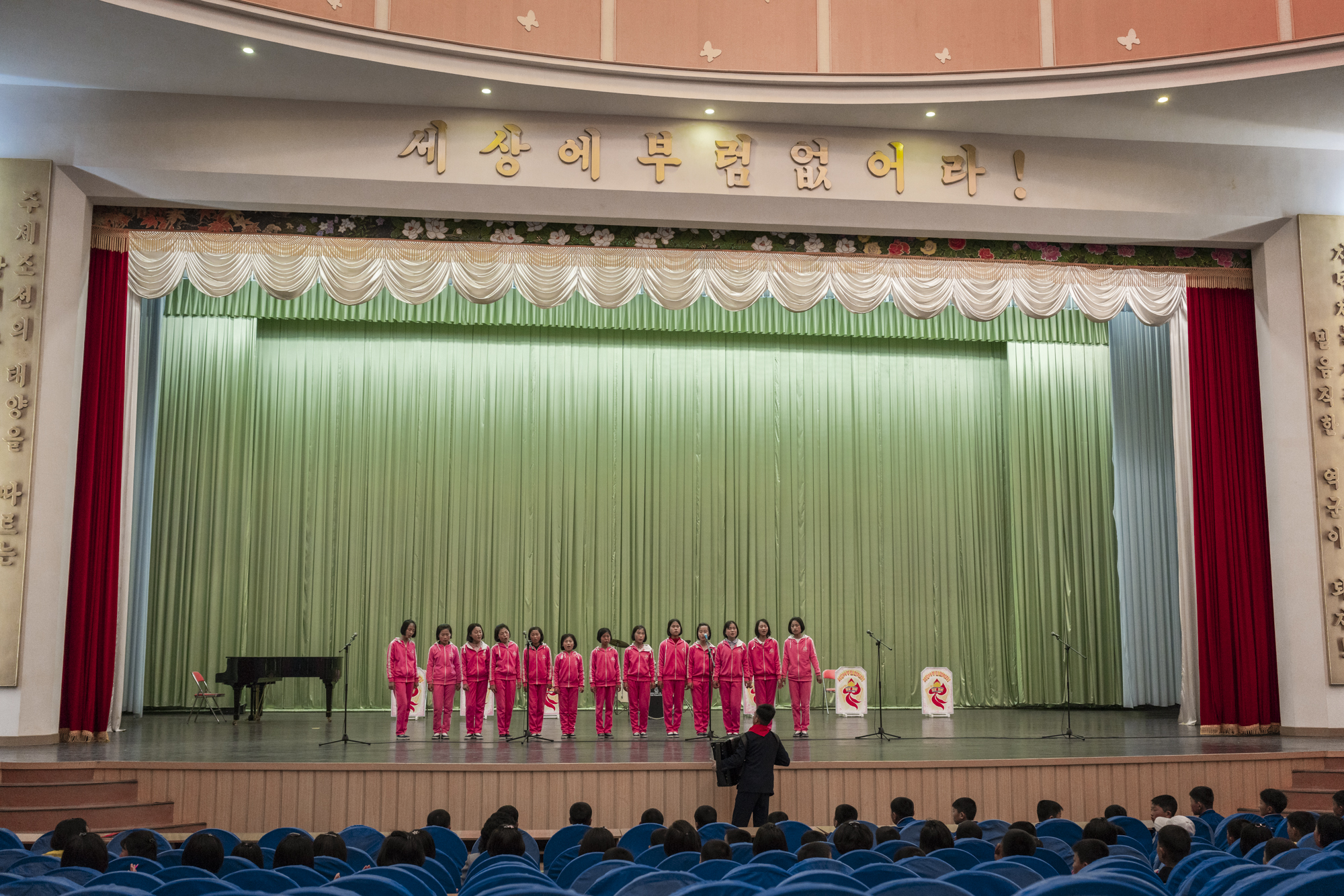
As part of the cultural exchange, students of the Songdowon International Children’s Camp learn how to perform North Korean songs and dances.
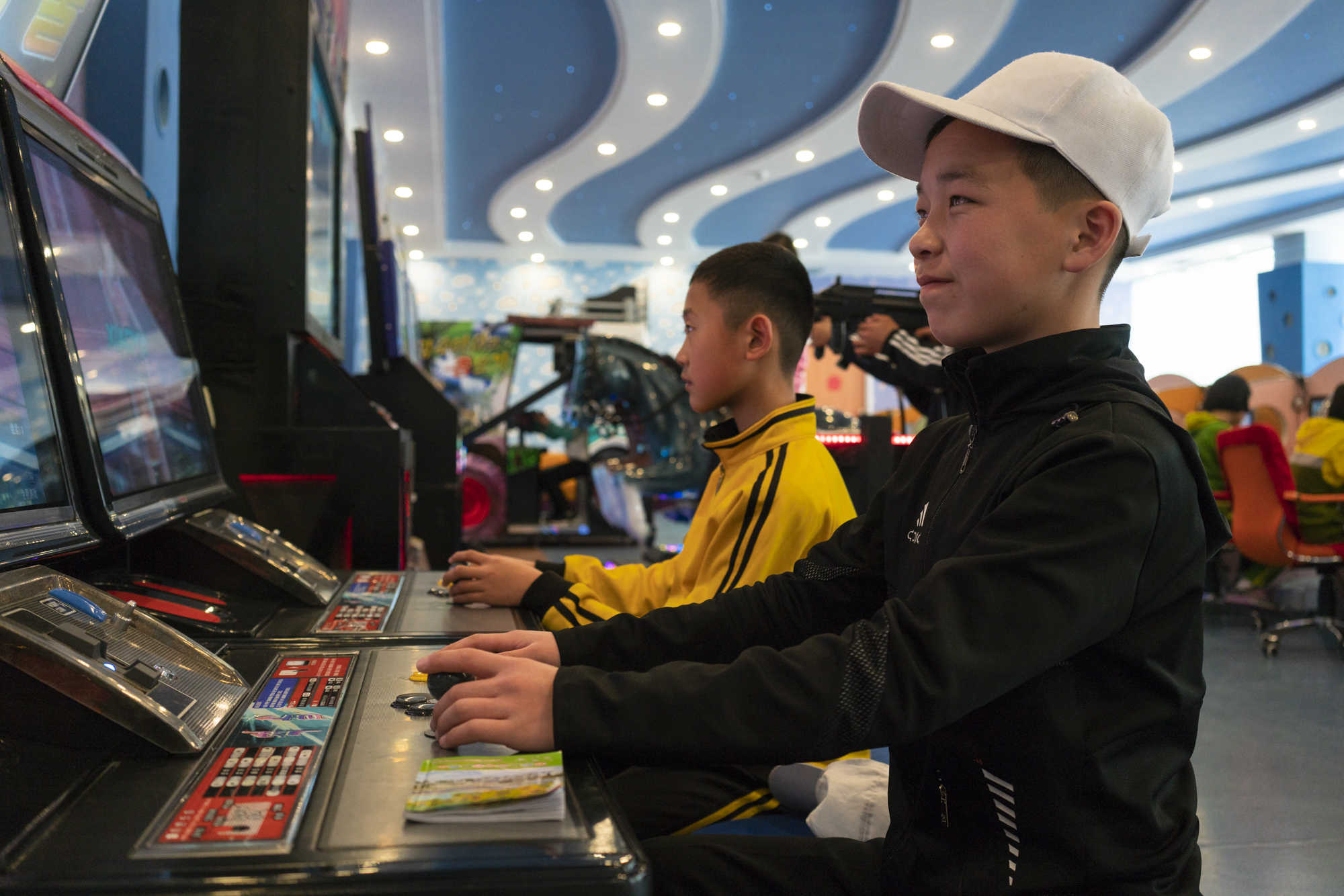
Children of Songdowon International Children’s Camp have the chance to be entertained in rooms filled with all sorts of video games, computers, and even a movie theatre.
It is hard to say how much of this idyllic environment is genuine, if not even constructed ad-hoc, and for how long these children are given access to the facilities once foreigners’ attention is elsewhere.
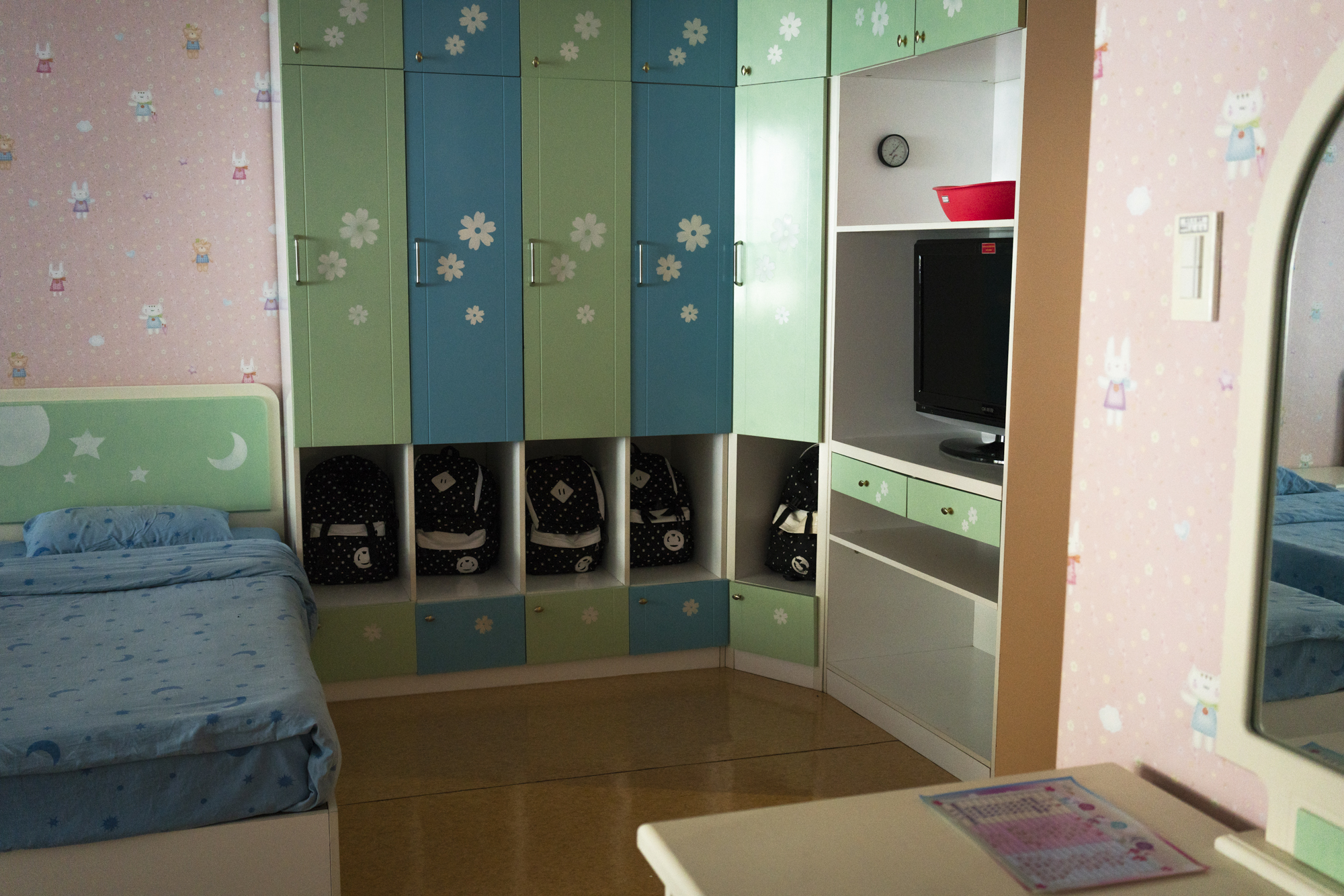
An air conditioned male dormitory at the Songdowon International Children’s Camp.
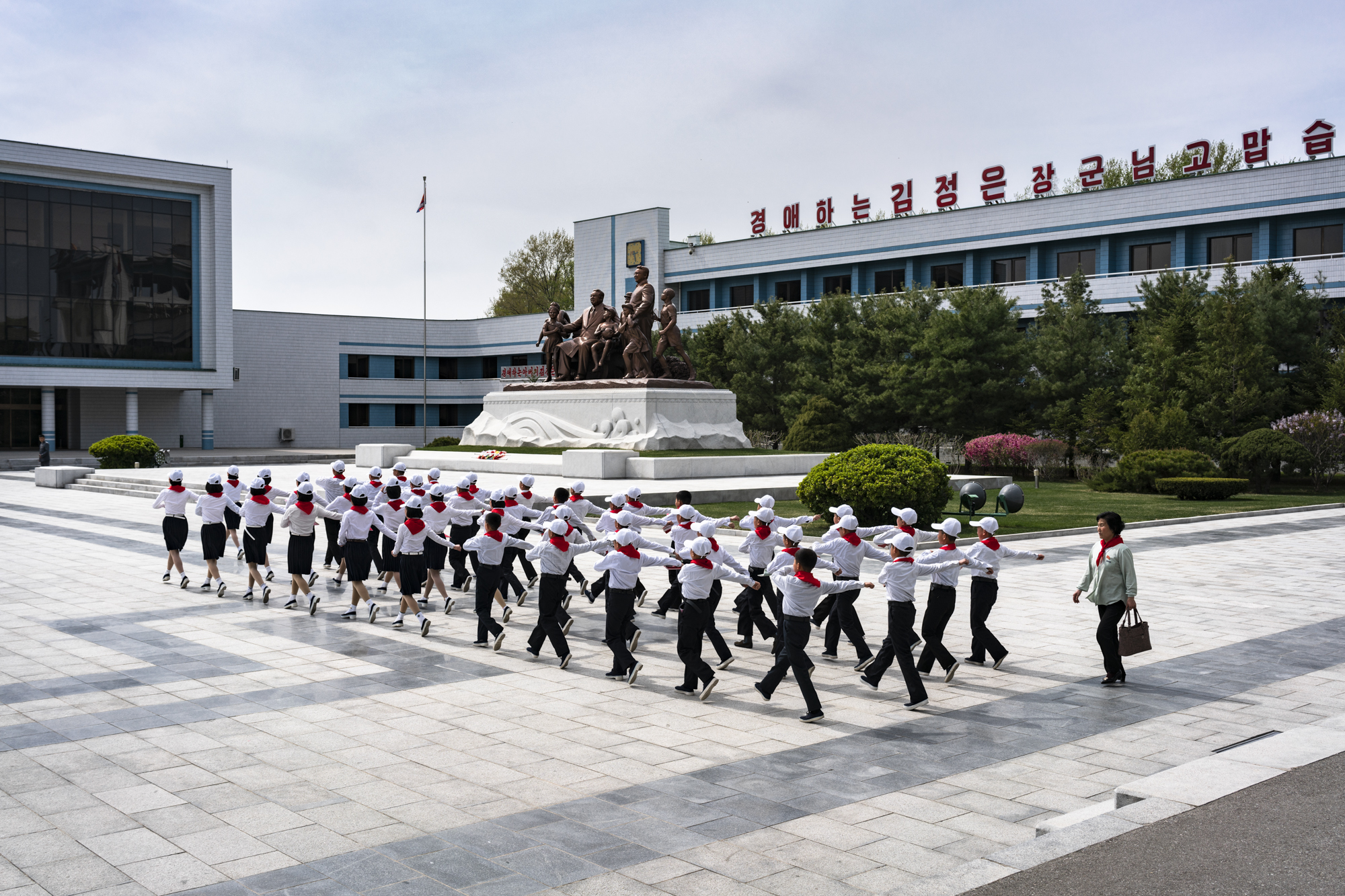
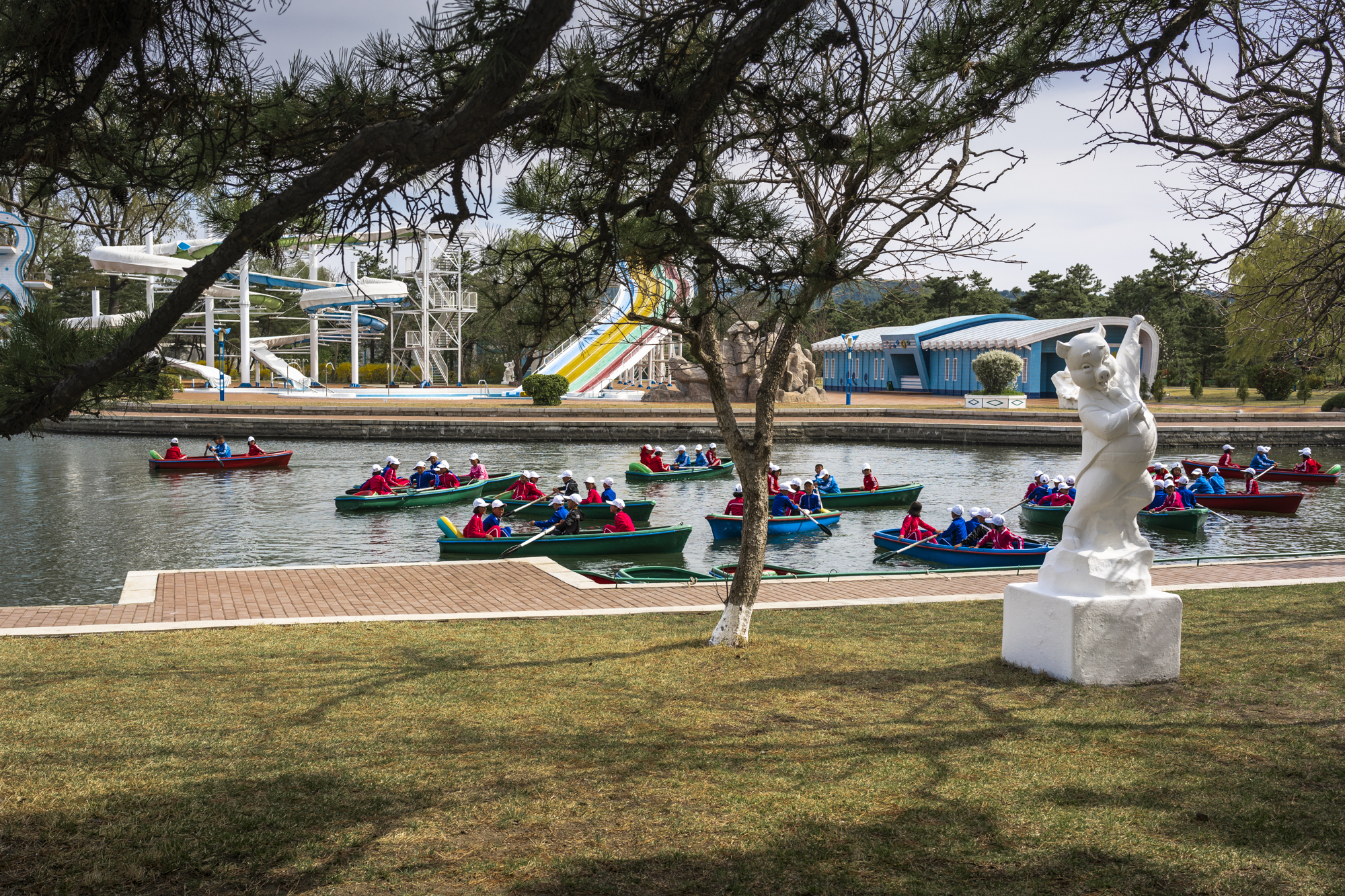
Students of Songdowon International Children’s Camp on boating classes.
What was originally intended to strengthen the relations with Communist countries, became later an international camp open to accept youth from anywhere in the world.
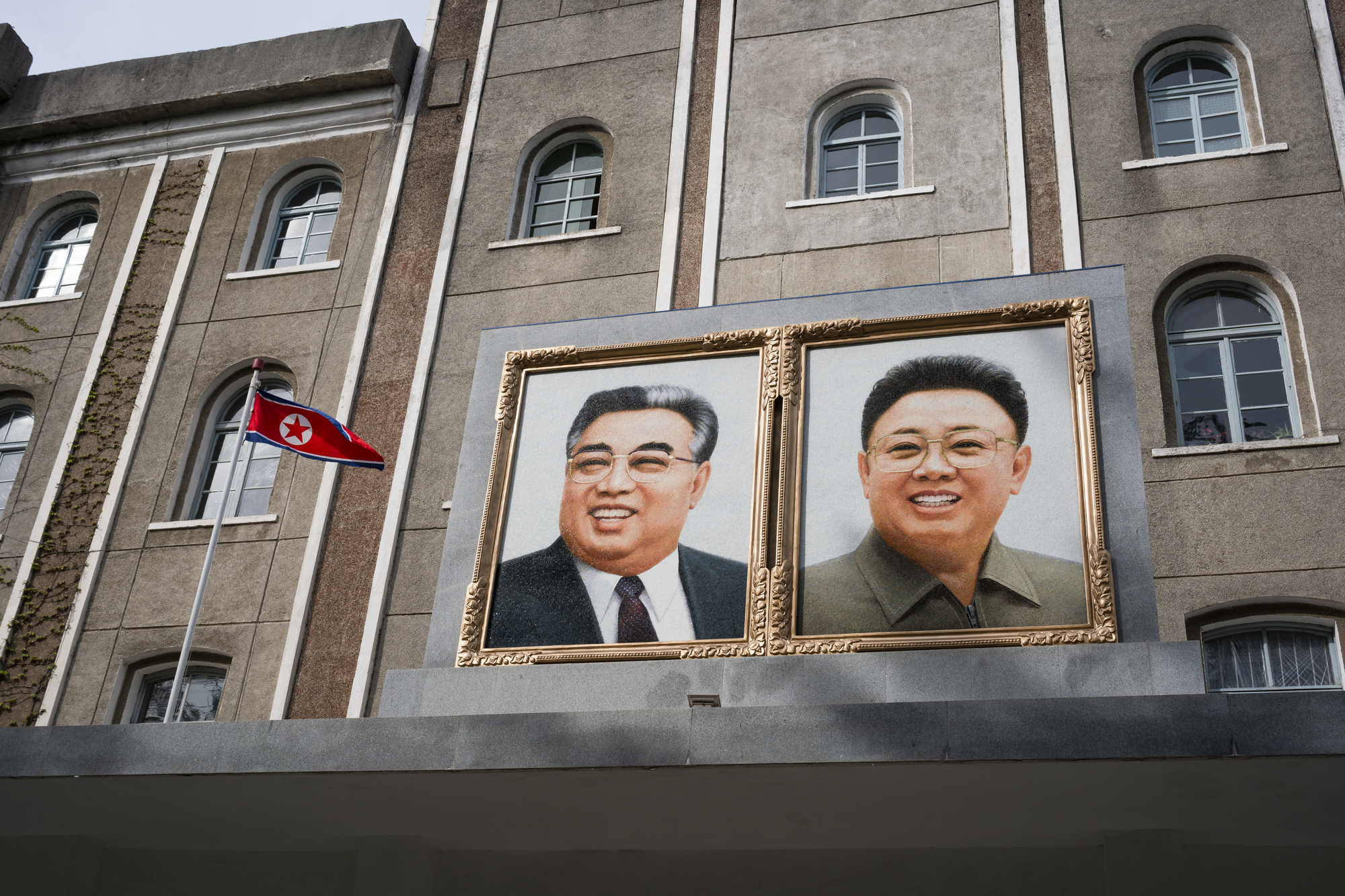
A DPRK flag and large-scale mosaics of the Great Leaders oversee the entrance of the Wŏnsan Agricultural University.
Founded in 1948 and built on the remains of an old German church, the university is a nonprofit and prestigious institution accredited by the North Korean Ministry of Education.
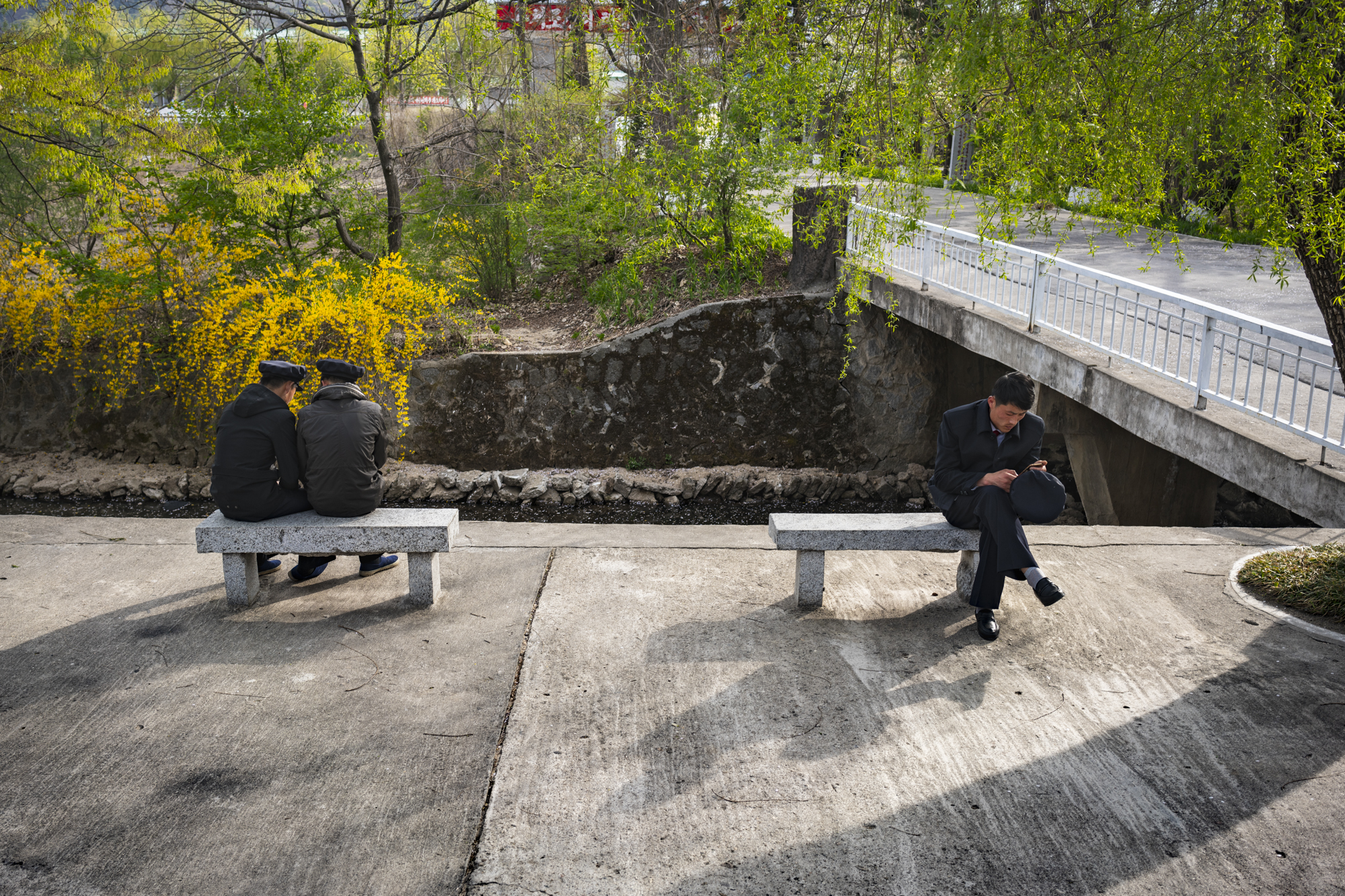
Students of the Wŏnsan Agricultural University.
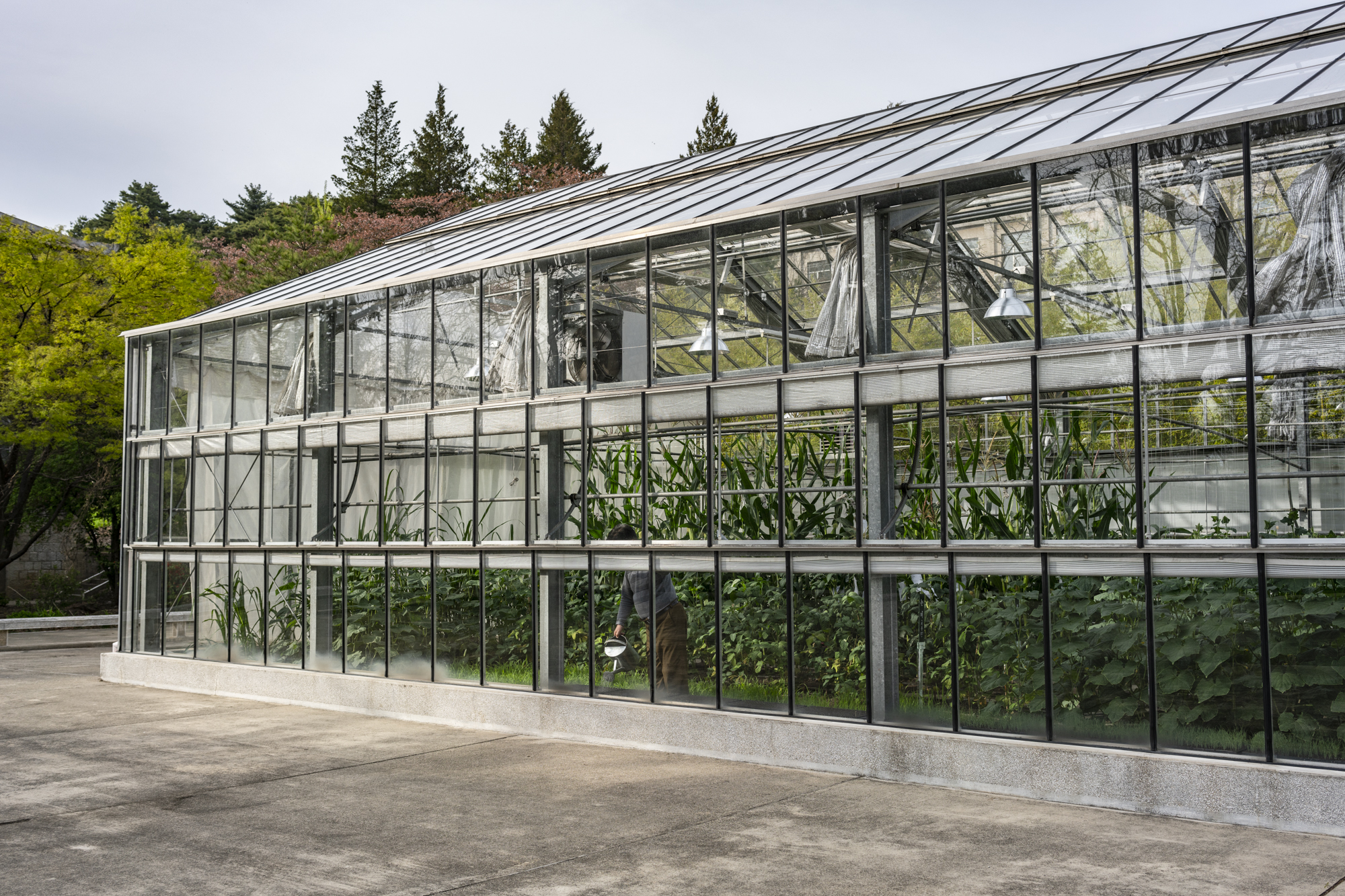
A student is watering the plants in the Wŏnsan Agricultural University greenhouse.
In line with the Juche ideology, students learn about farming techniques, agricultural management, veterinary sciences, and other agricultural related fields.
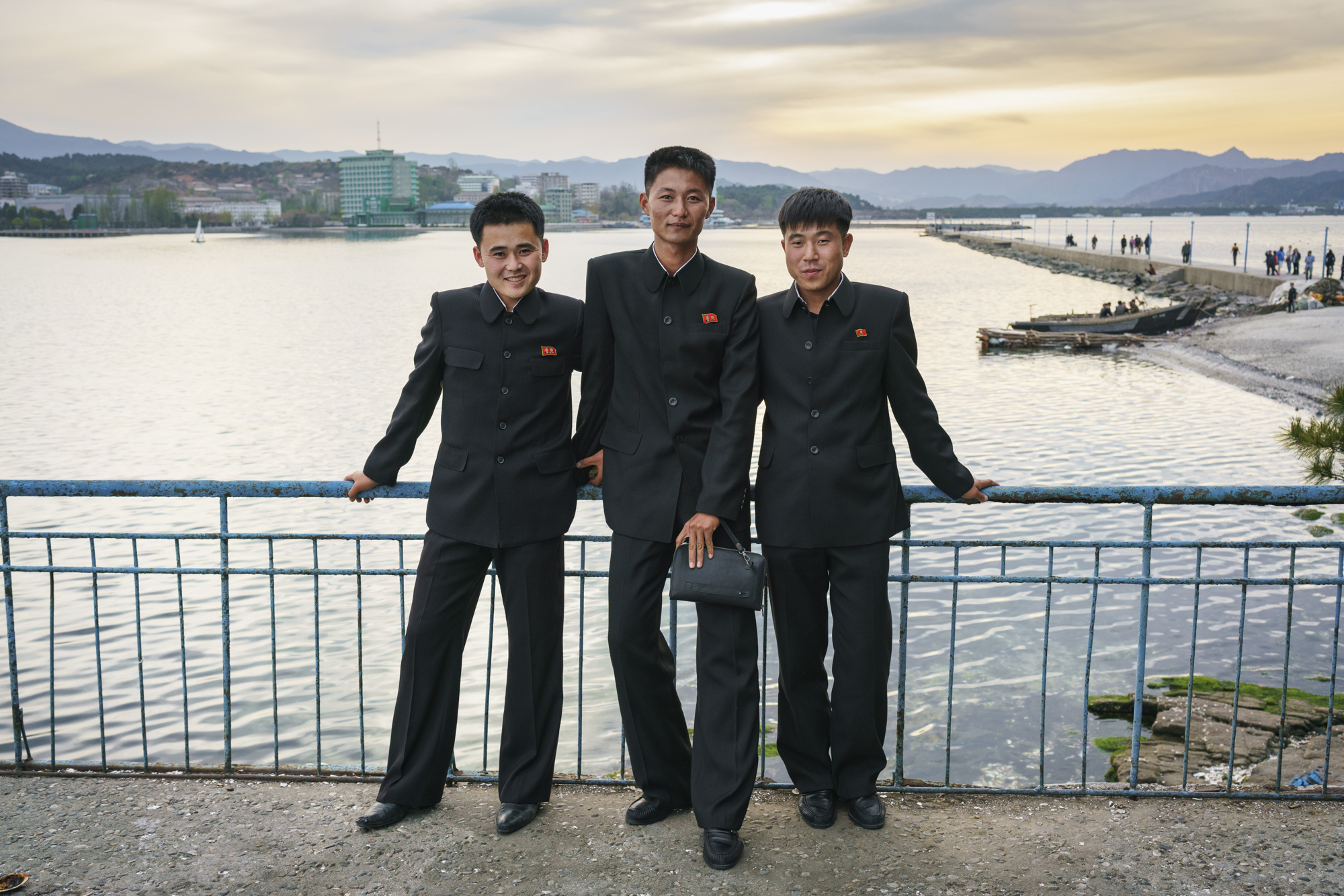
On Jangdok Islet, three North Korean students enjoy the sunset on the panoramic balcony that faces the city of Wŏnsan.
The small island is known for the Changdokdo lighthouse, built by the Japanese in 1919 to help in their trading enterprises.
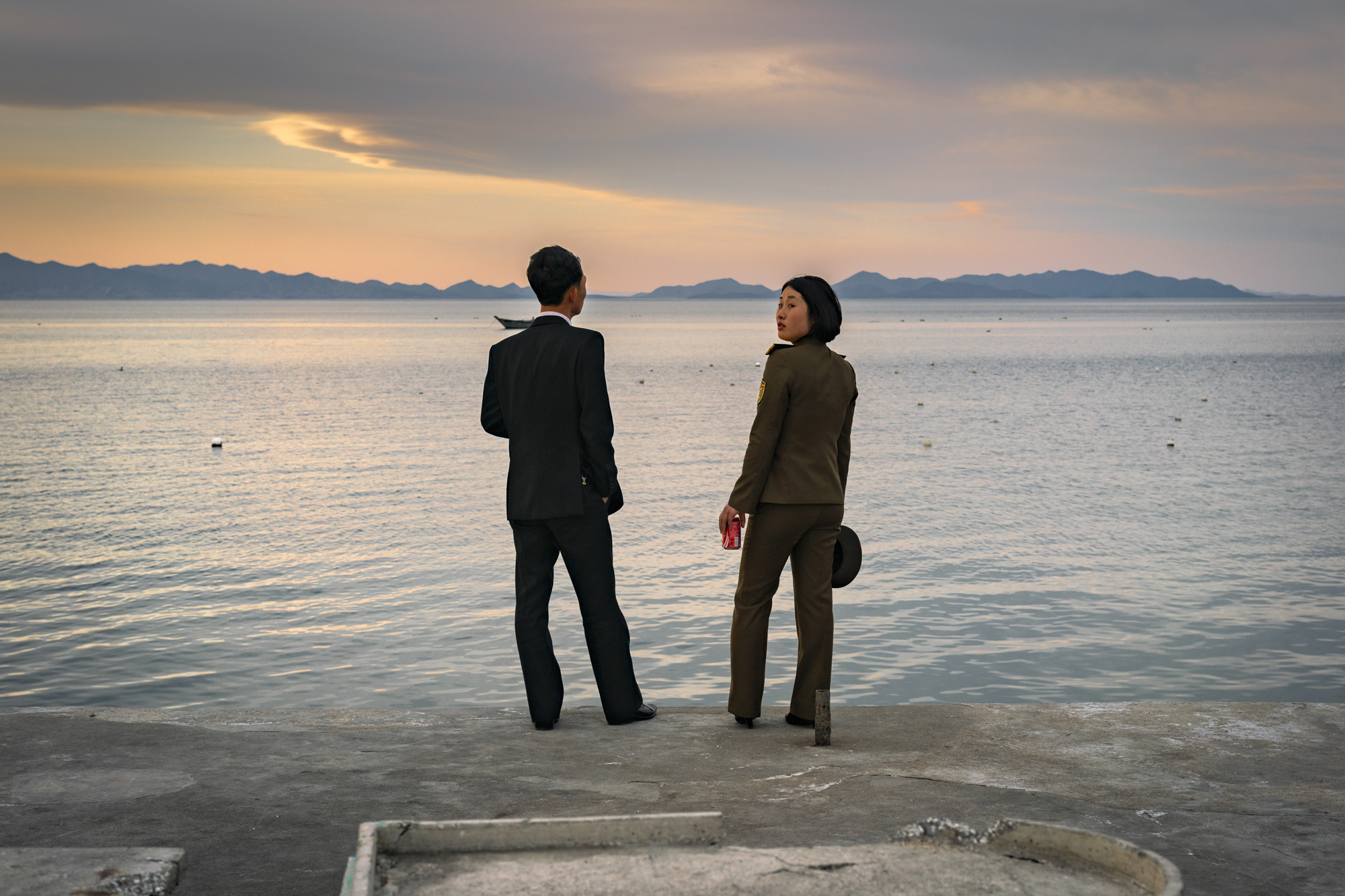
A couple watches the sunset over Yonghung Bay on the pier to Jangdok Islet.
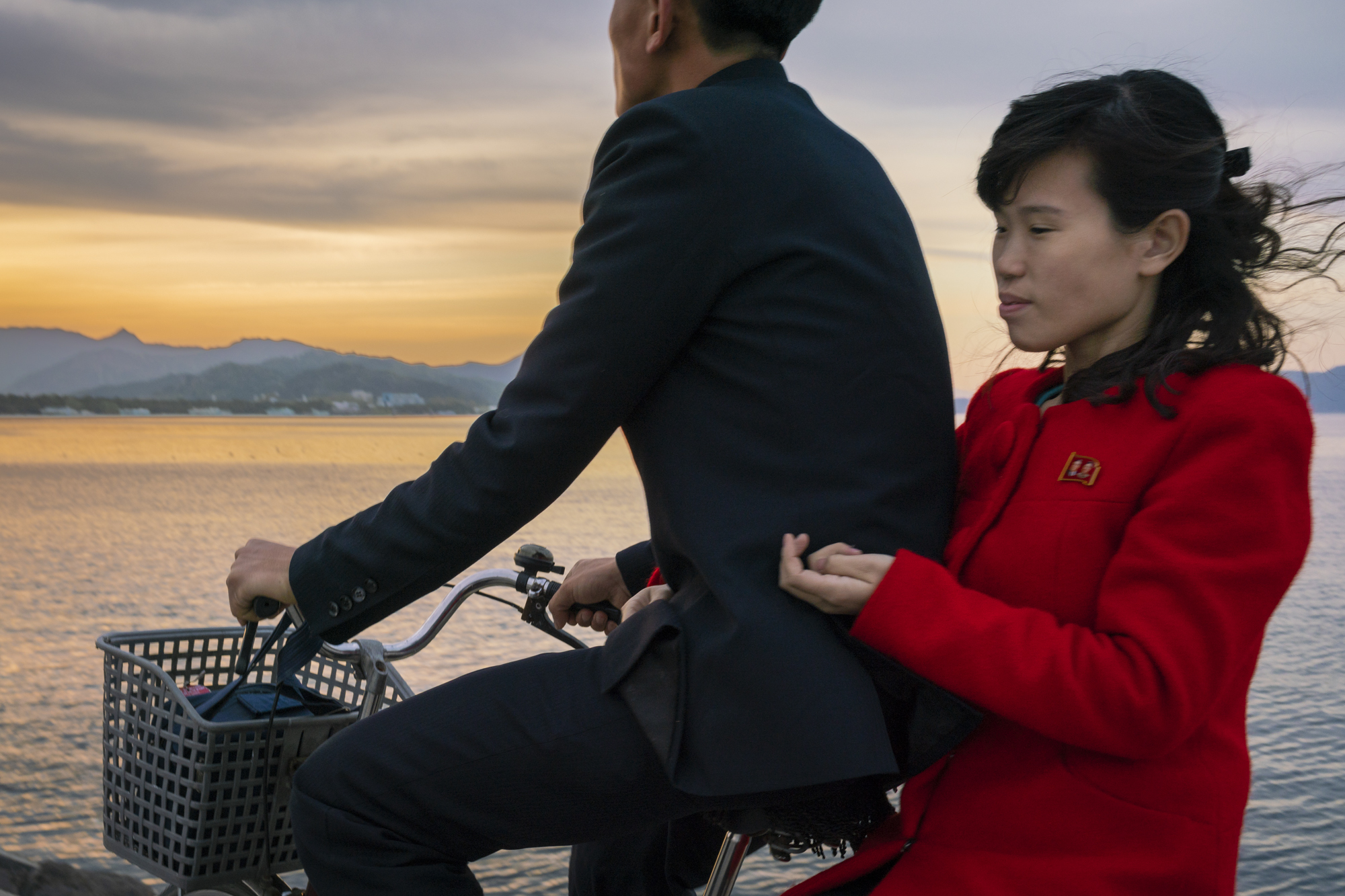
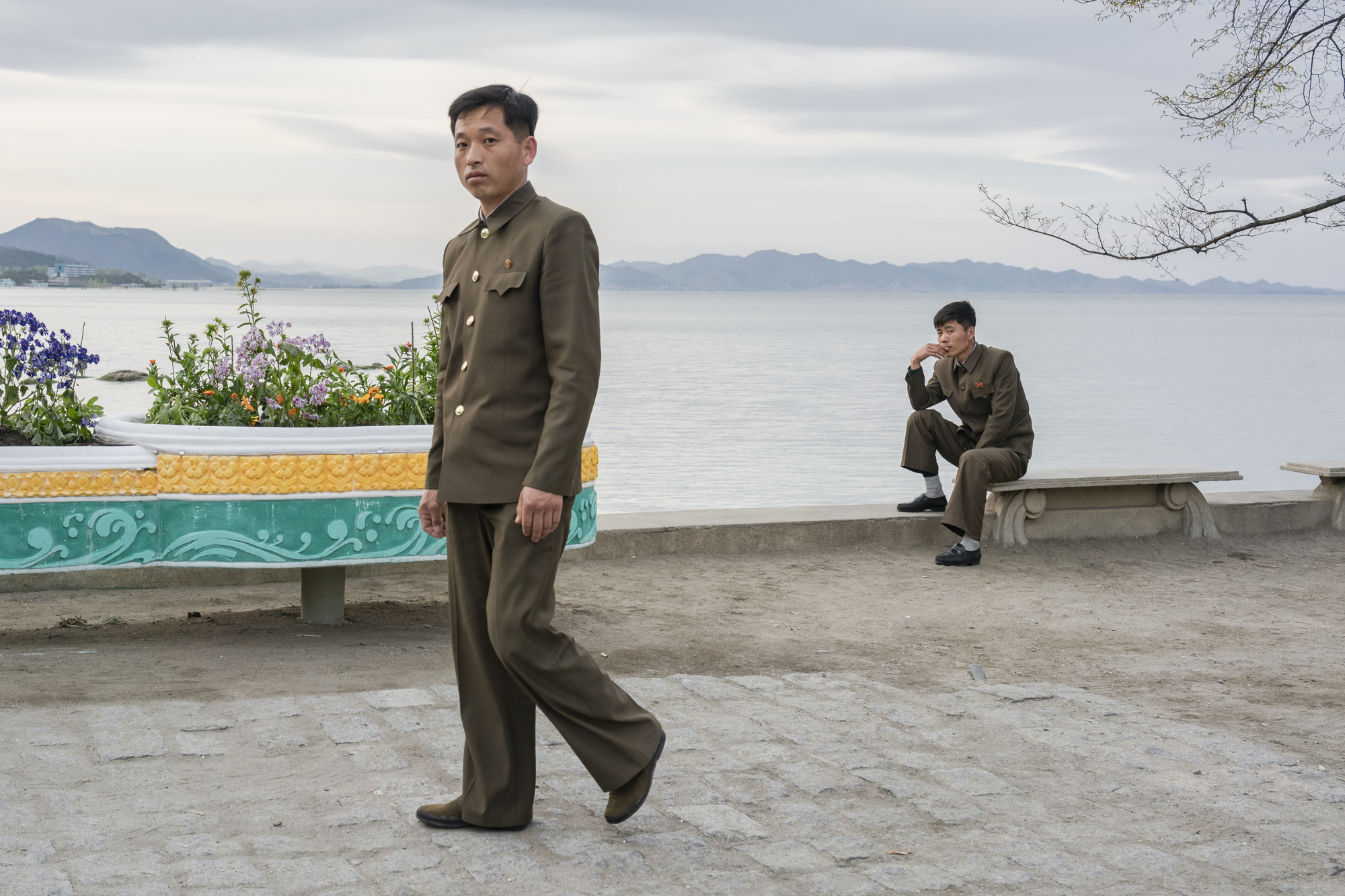
Uniformed North Koreans on the seaside in Wŏnsan, a port city and naval base located in Kangwŏn Province, along the eastern side of the Korean Peninsula.
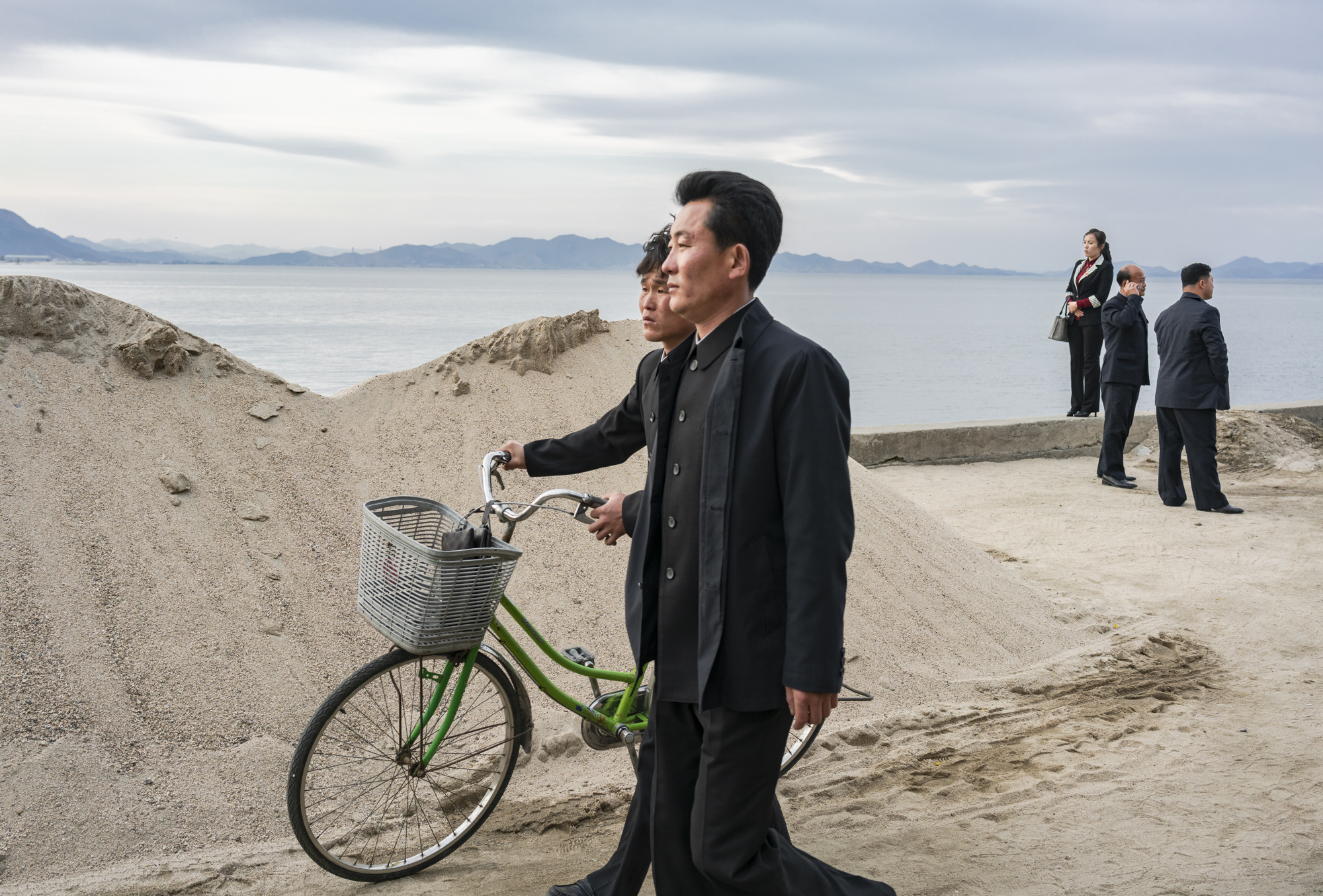
North Koreans returning from the pier that connects the Wŏnsan docks to Jangdok Islet.
To visit the small island and the Changdokdo lighthouse, foreigners are asked to pay a $1 entry fee. The pier itself is considered an attraction amongst locals who enjoy biking across it.
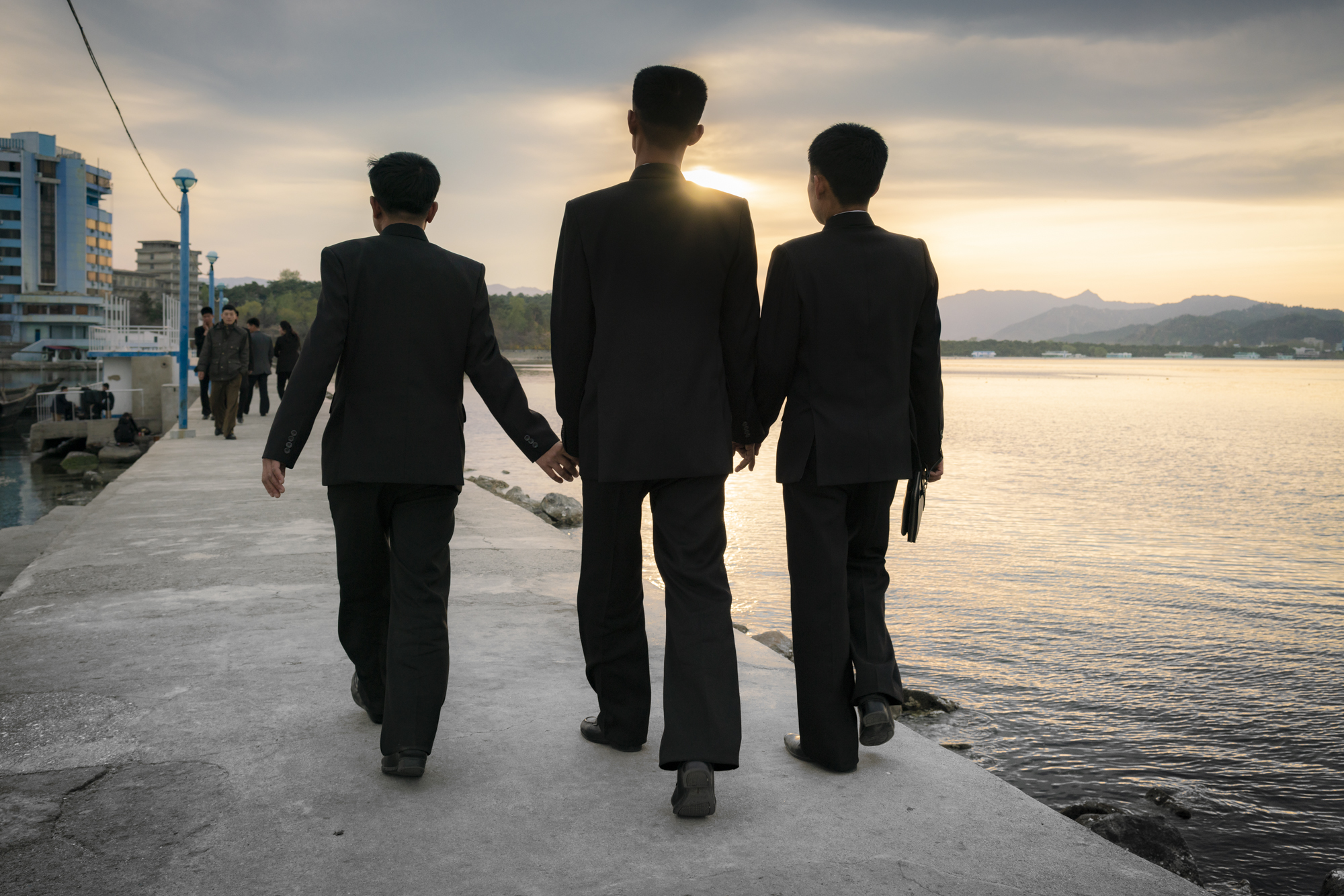
As the sun sets behind the hills, three North Korean students hold hands on the pier that connects the Wŏnsan docks to Jangdok Islet.
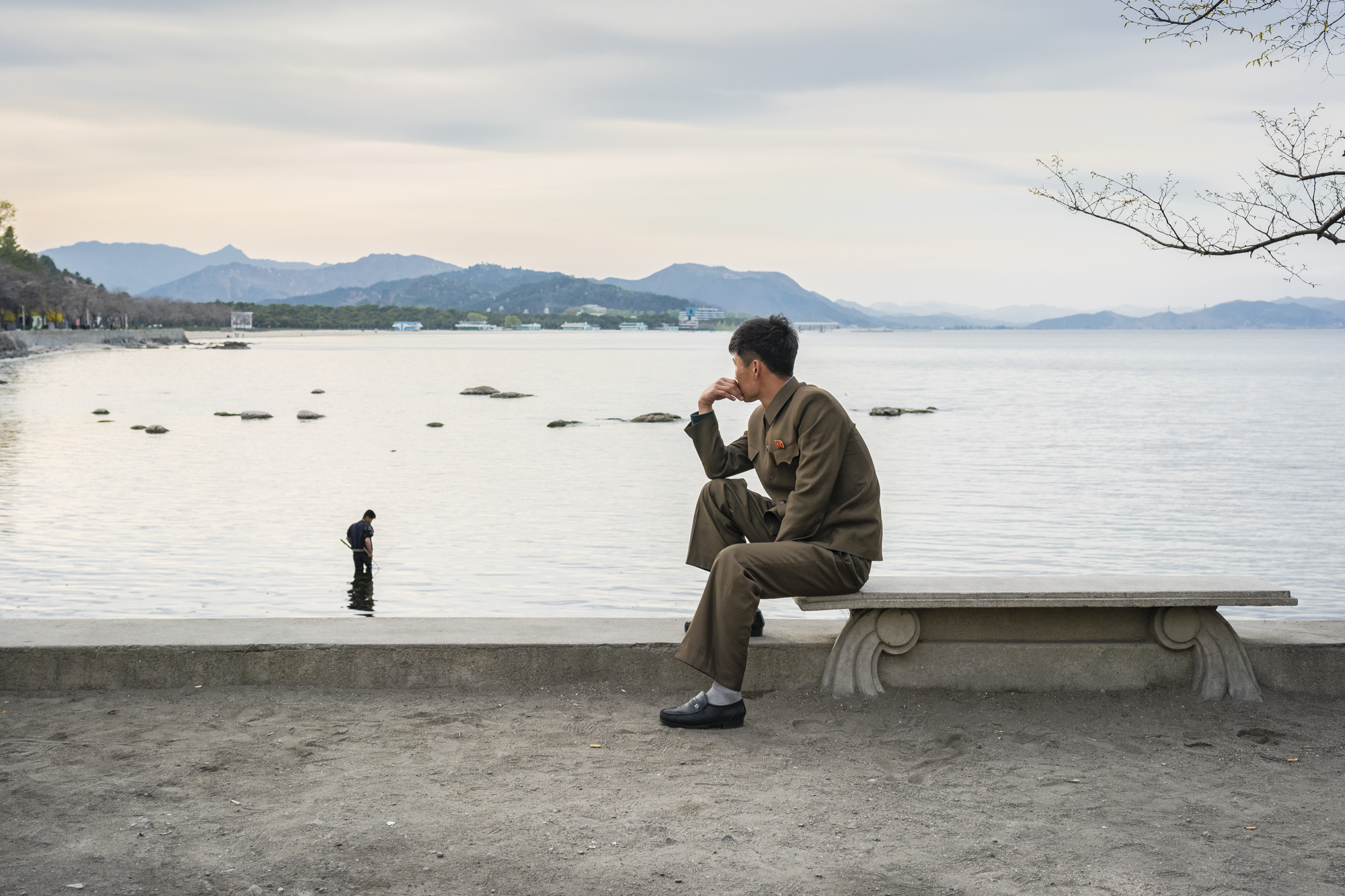
As the sun sets behind the hills on eastern side of the Korean Peninsula, North Koreans enjoy the warm temperatures on the shoreline in Wŏnsan.
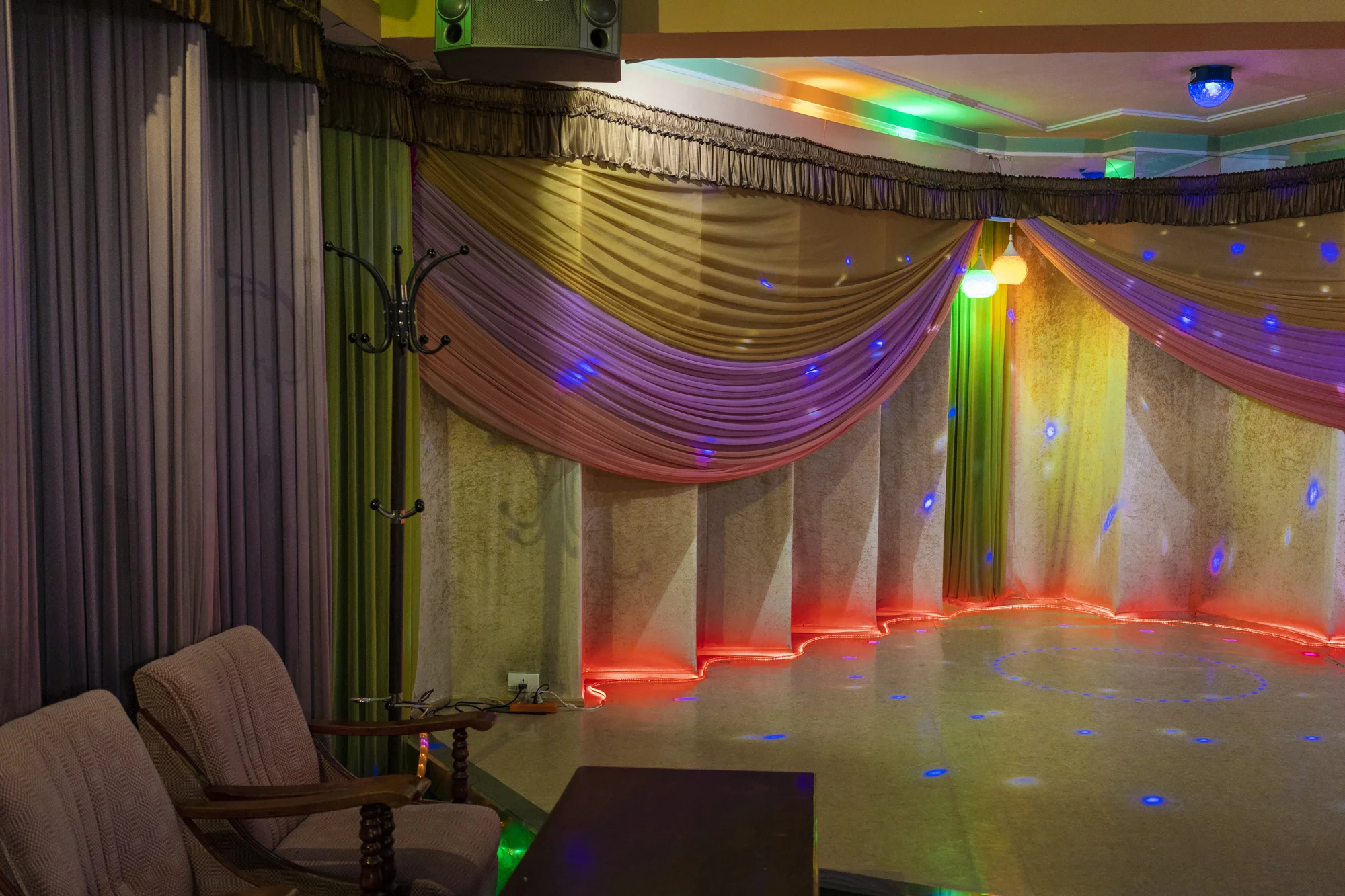
An empty dancing floor in a hotel on the East Coast in Wŏnsan city.
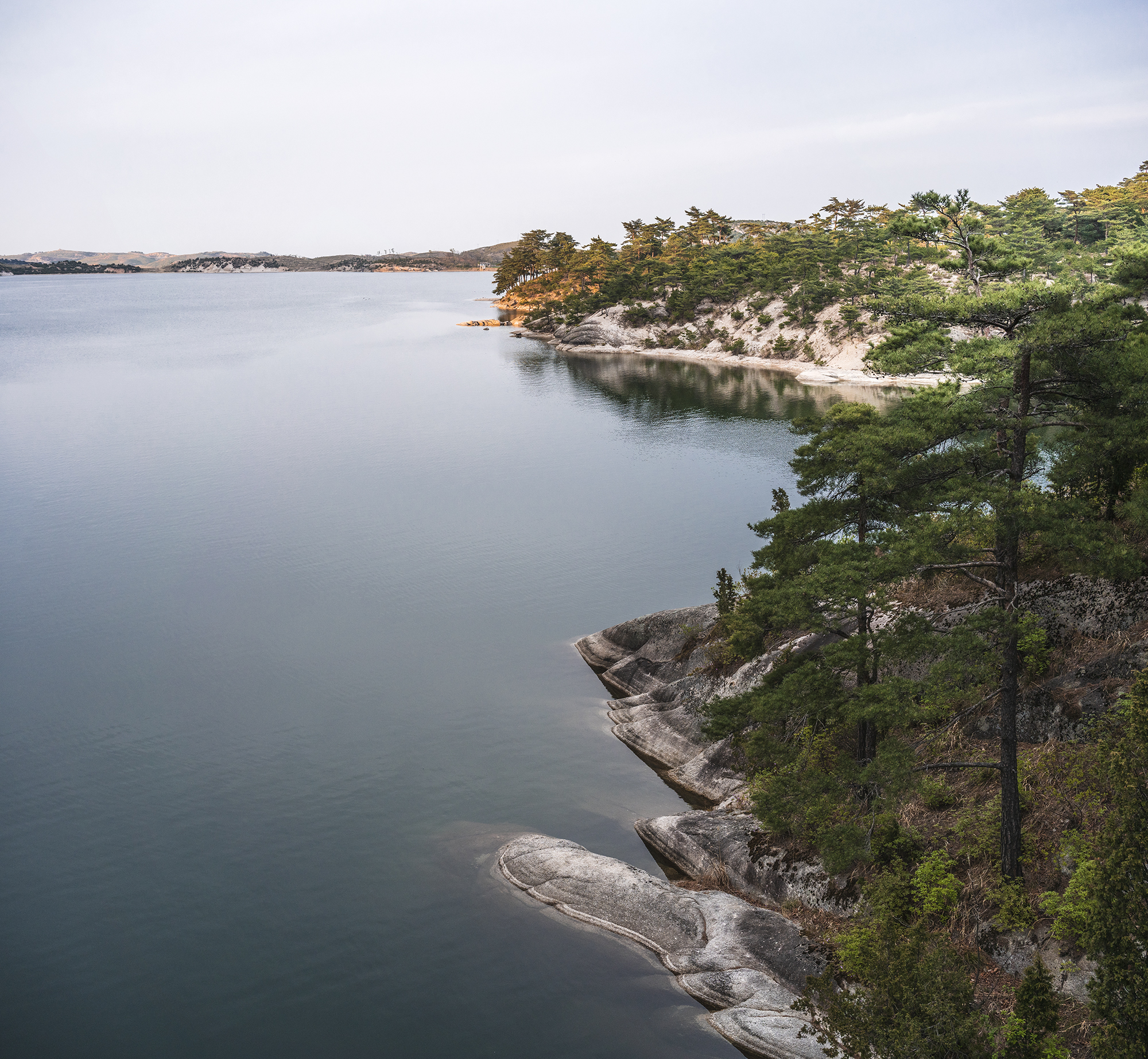
Lake Samilpo, Mt. Kumgang Biosphere Reserve UNESCO site.
Mount Kumgang is a forest-oriented ecosystem linked to coastal, agricultural and freshwater ecosystems.
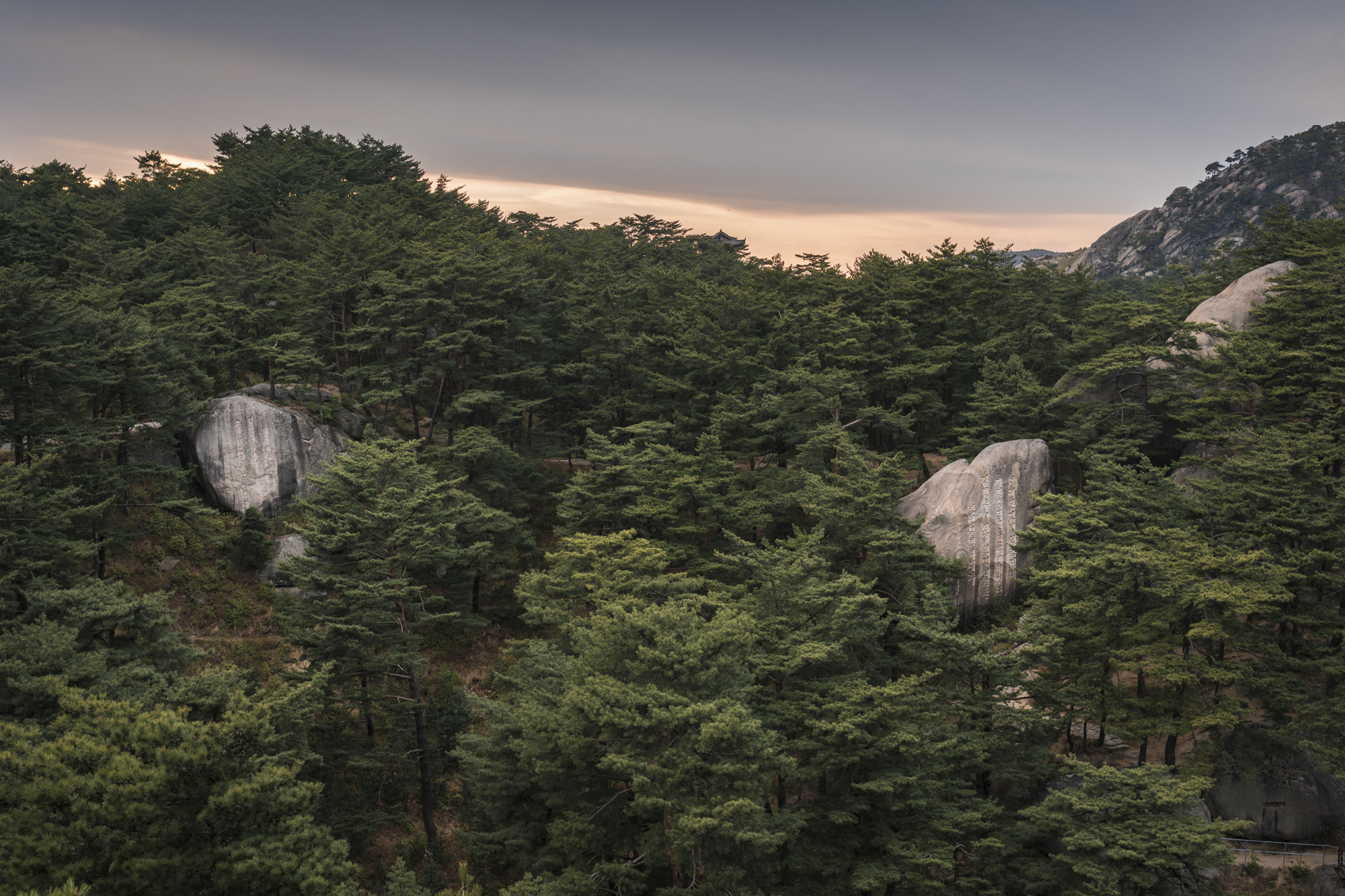
Inscriptions on the large granite rocks between red Korean pine trees in Mt. Kumgang Biosphere Reserve UNESCO site.
The reserve is located in the South-East of North Korea.
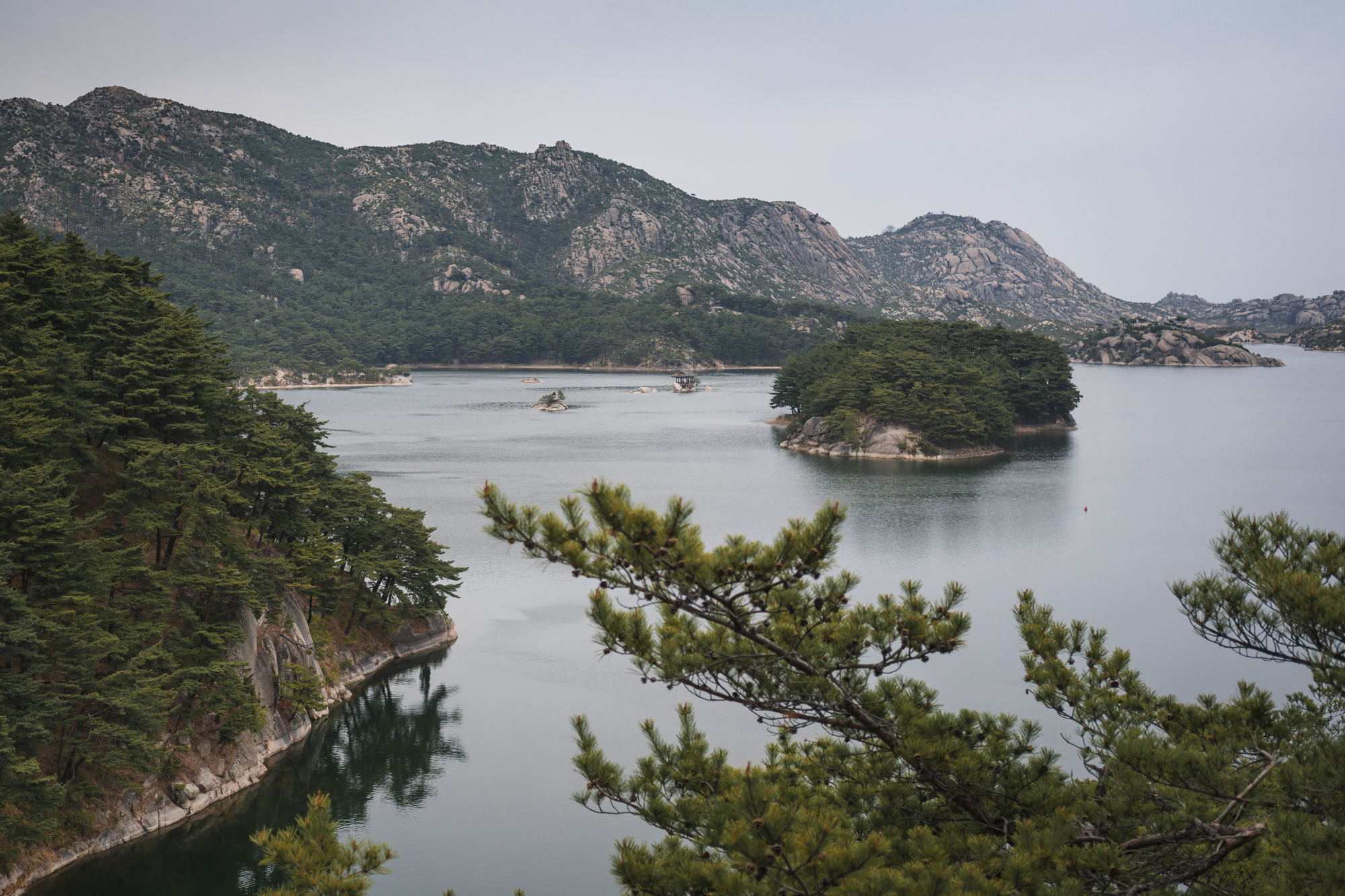
The Lake Samilpo is a freshwater lake part of the Mt. Kumgang Biosphere Reserve UNESCO site in the Mount Kumgang Tourist Region which runs along the east of the Korean Peninsula.
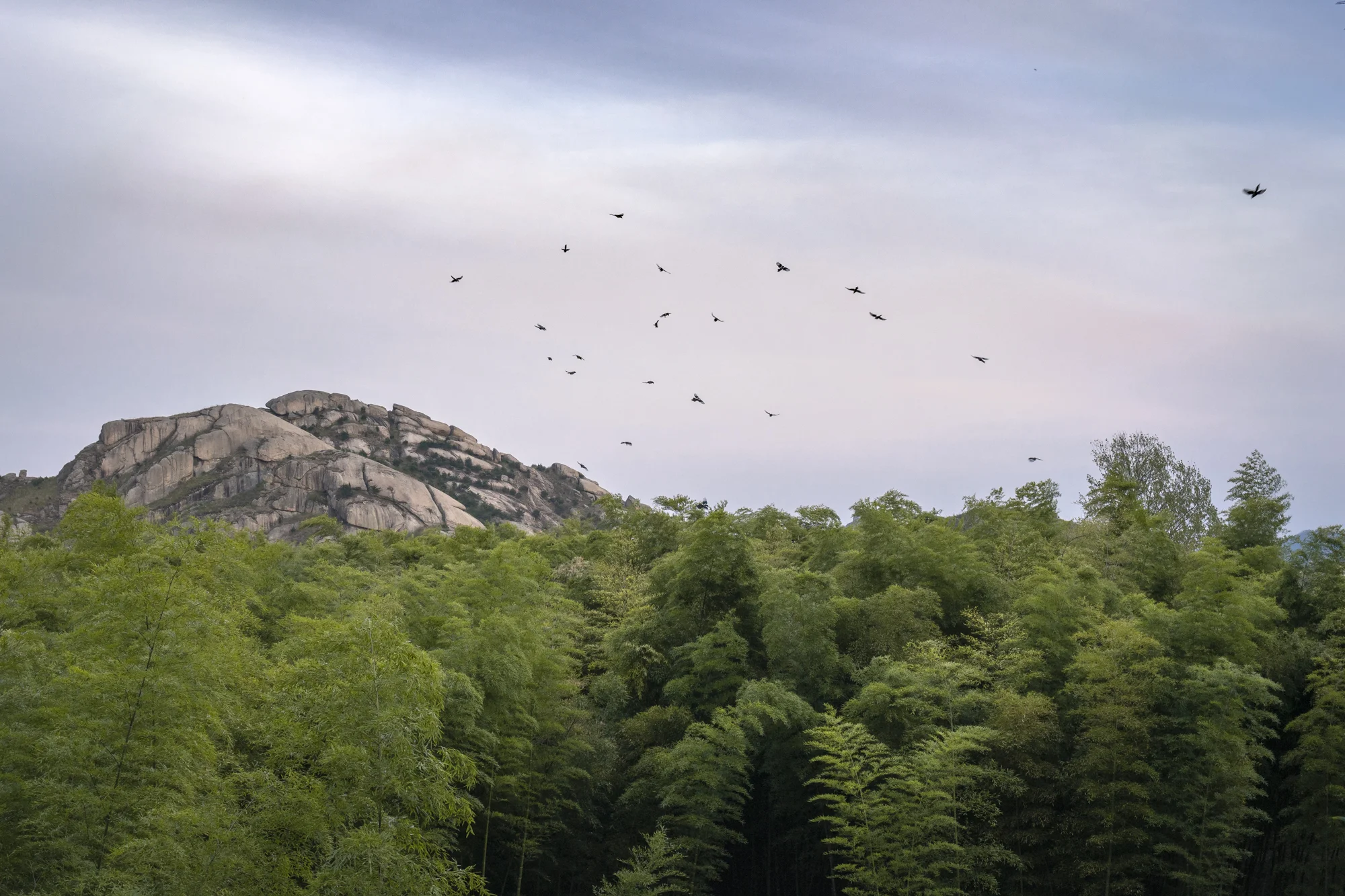
A flock of Eurasian magpie flies over a bamboo grove at the Mt. Kumgang biosphere reserve.
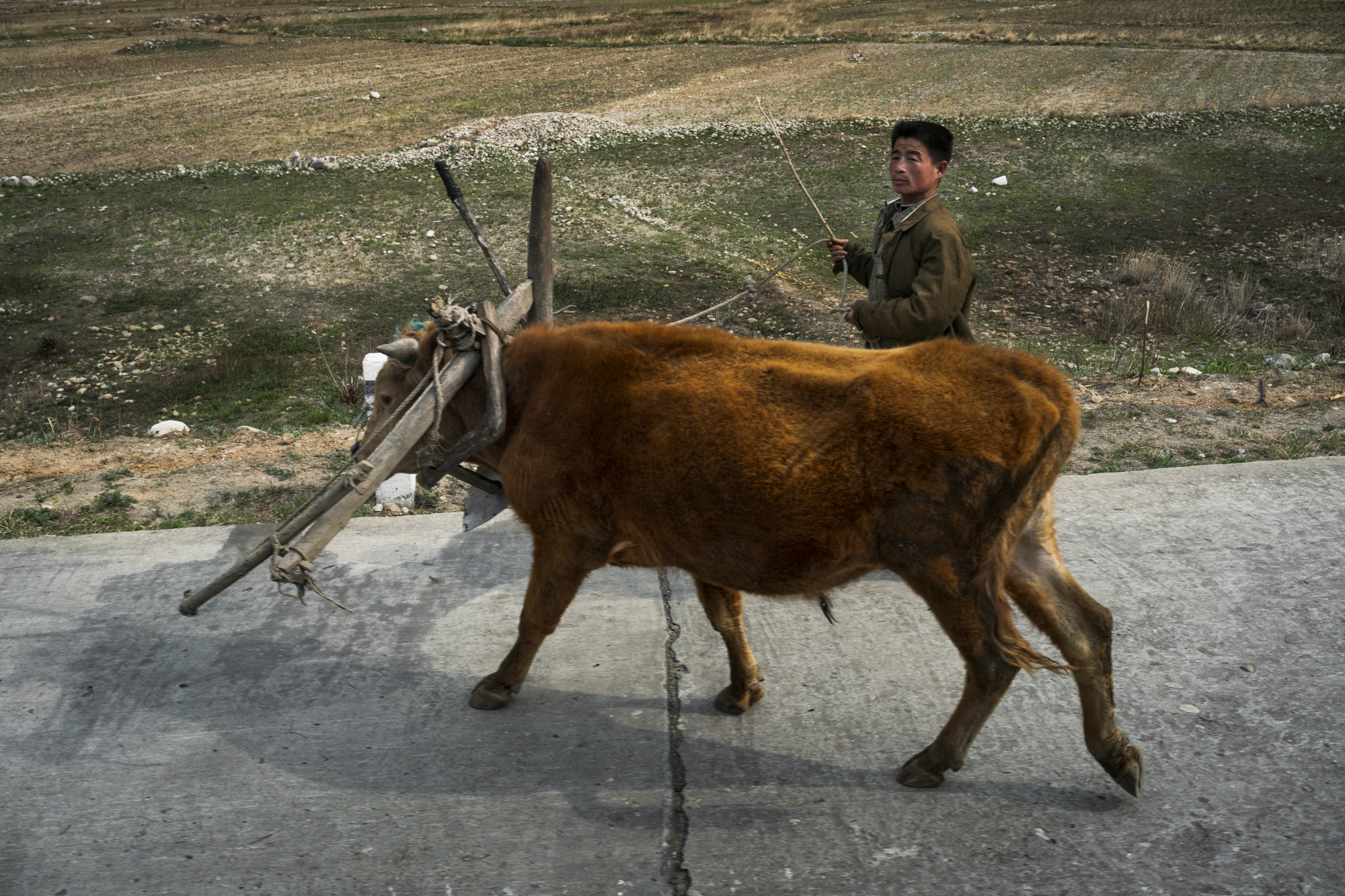
A farmer with his cattle on a roadside in the Kangwŏn Province.
Poverty is widespread in North Korea after years of sanctions and economic mismanagement with many North Koreans still rely on traditional farming practices to live.
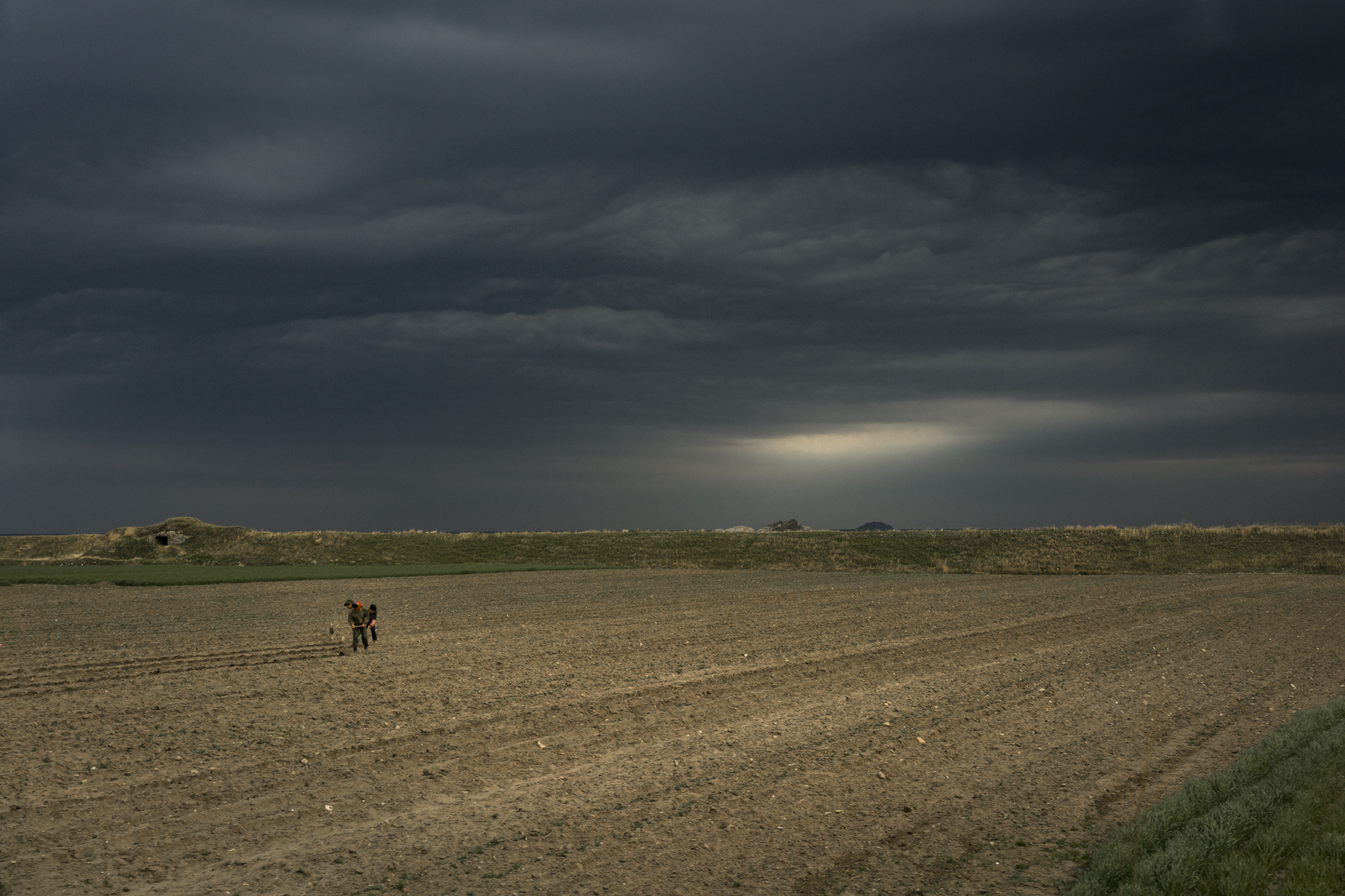
Farmers working the land in the Kangwŏn Province on the North Korean South-East coast near the Sea of Japan, also known as the “East Sea”.
Farming in North Korea is concentrated in the flatlands of the four west coast provinces where more favourable conditions permit the most intensive cultivation of crops. Rice is North Korea’s primary farm product.
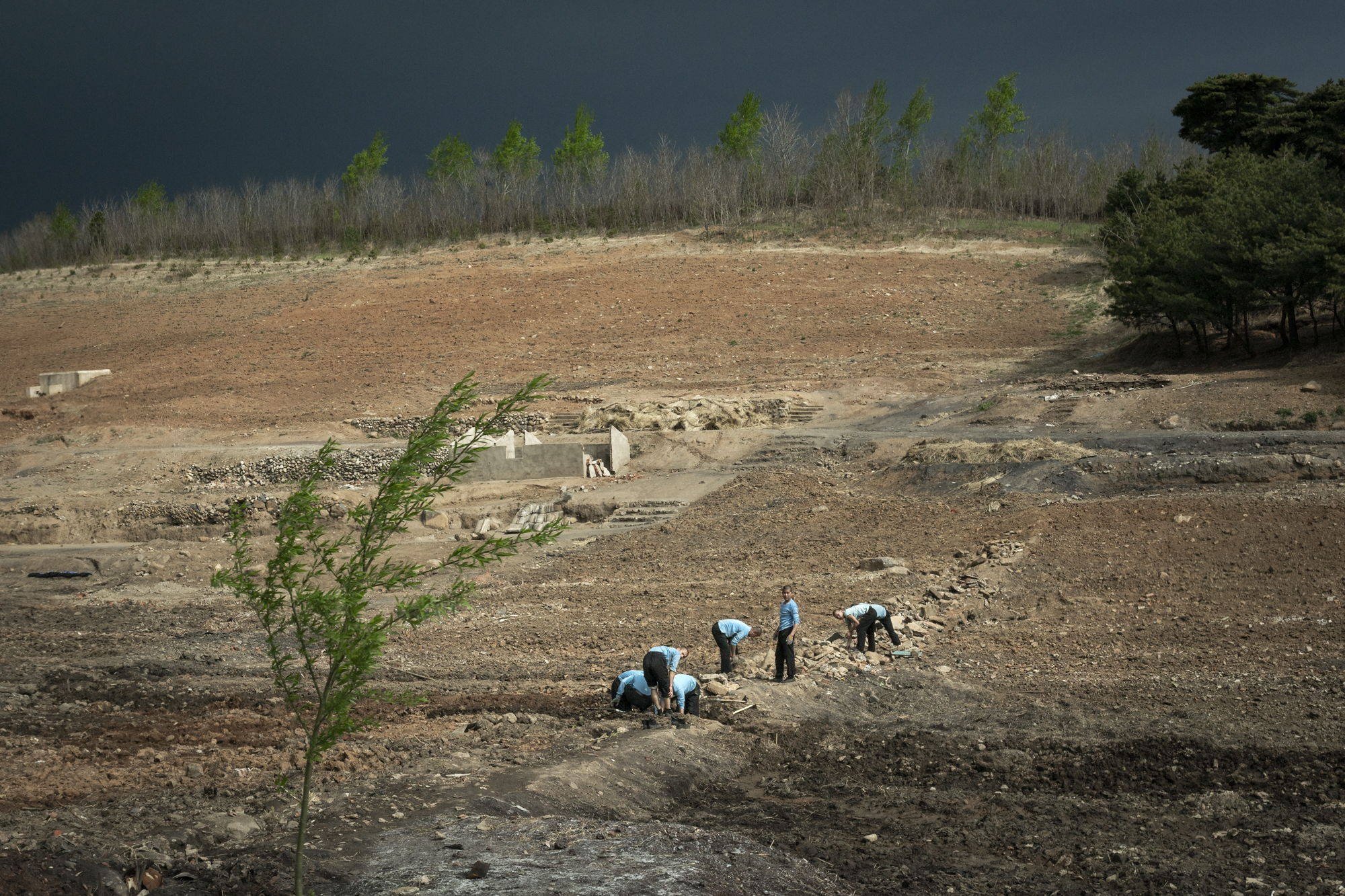
In North Korea soldiers are used as a labour force to compensate for the weak economy of the country. It is not unusual to see them working in the fields helping farmers, fixing roads, or on construction sites.
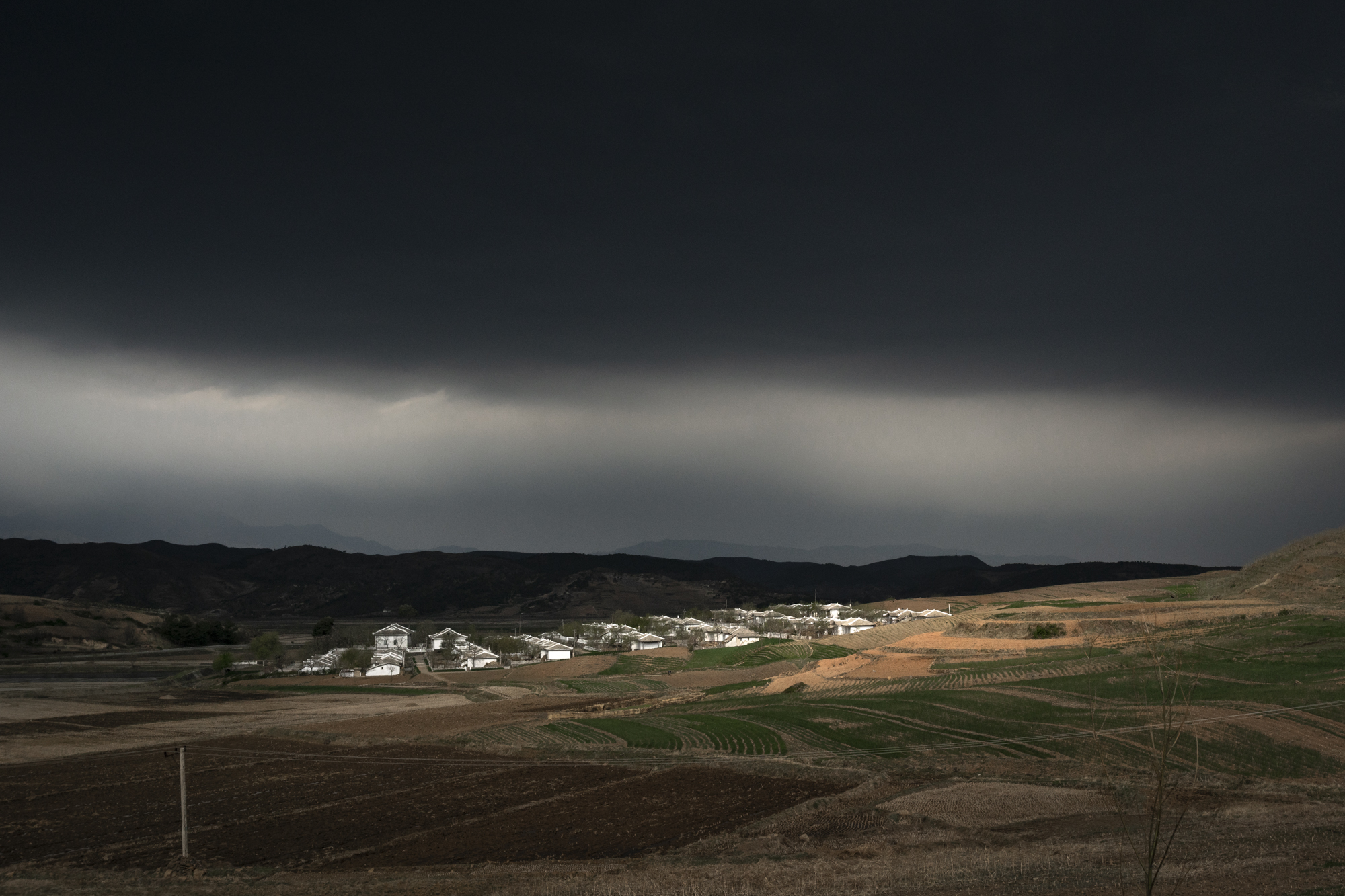
Under a gloomy cloud threatening rain, a beam of light shines on a small rural settlement in the Kangwŏn Province.
Forty percent of North Korea’s population lives in rural and agricultural communities. North Korean officials usually restrict foreigners to photographing these areas fearing they could give a perception of poverty.
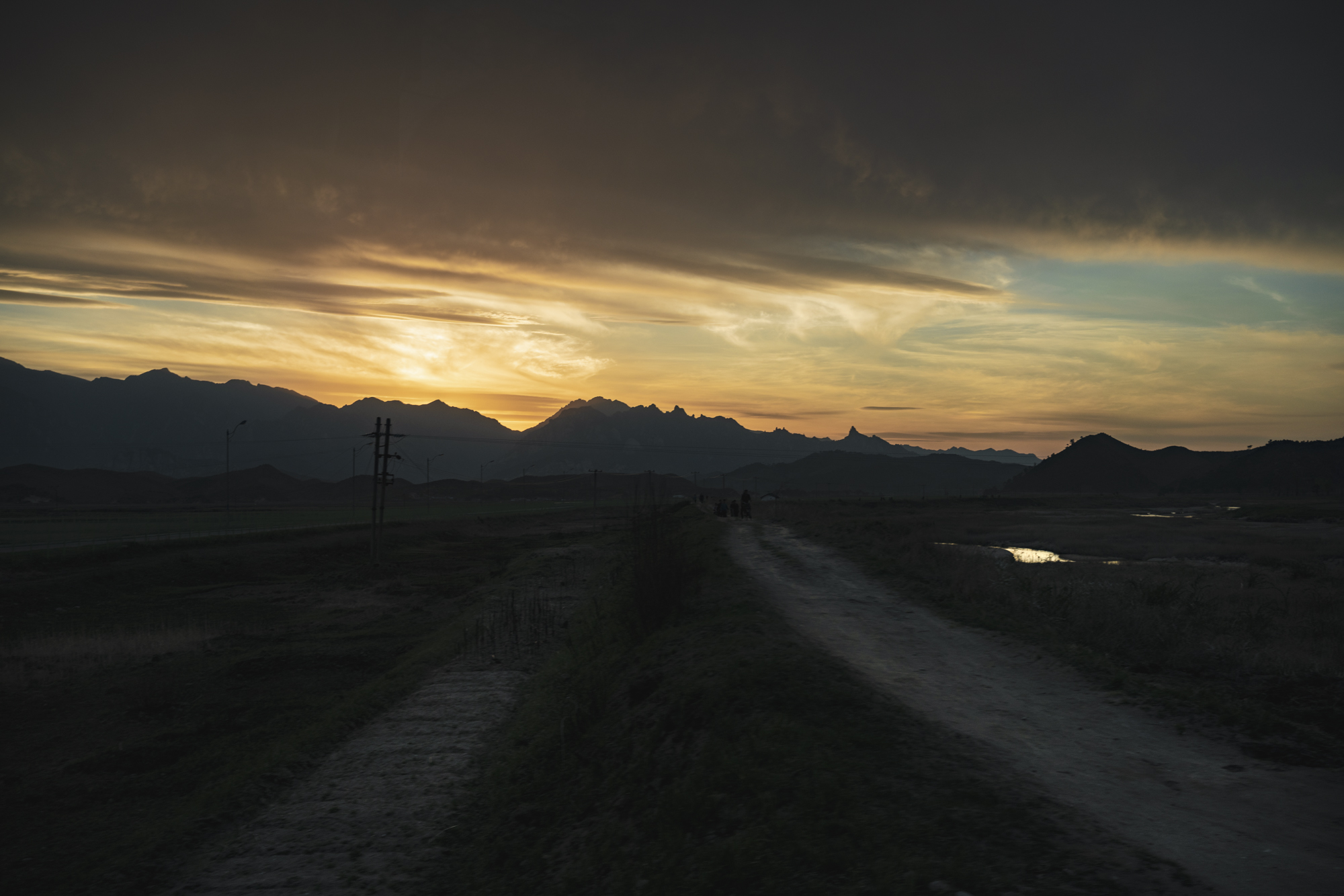
Sunset above the Mt. Kumgang National Park, in the south-east of North Korea.
For its geographical conditions with many hills and plateaus, the farming activities around the Mt. Kumgang Biosphere Reserve are mainly focused on the cultivation of non-paddy field crops, as well as fruit and sericulture.
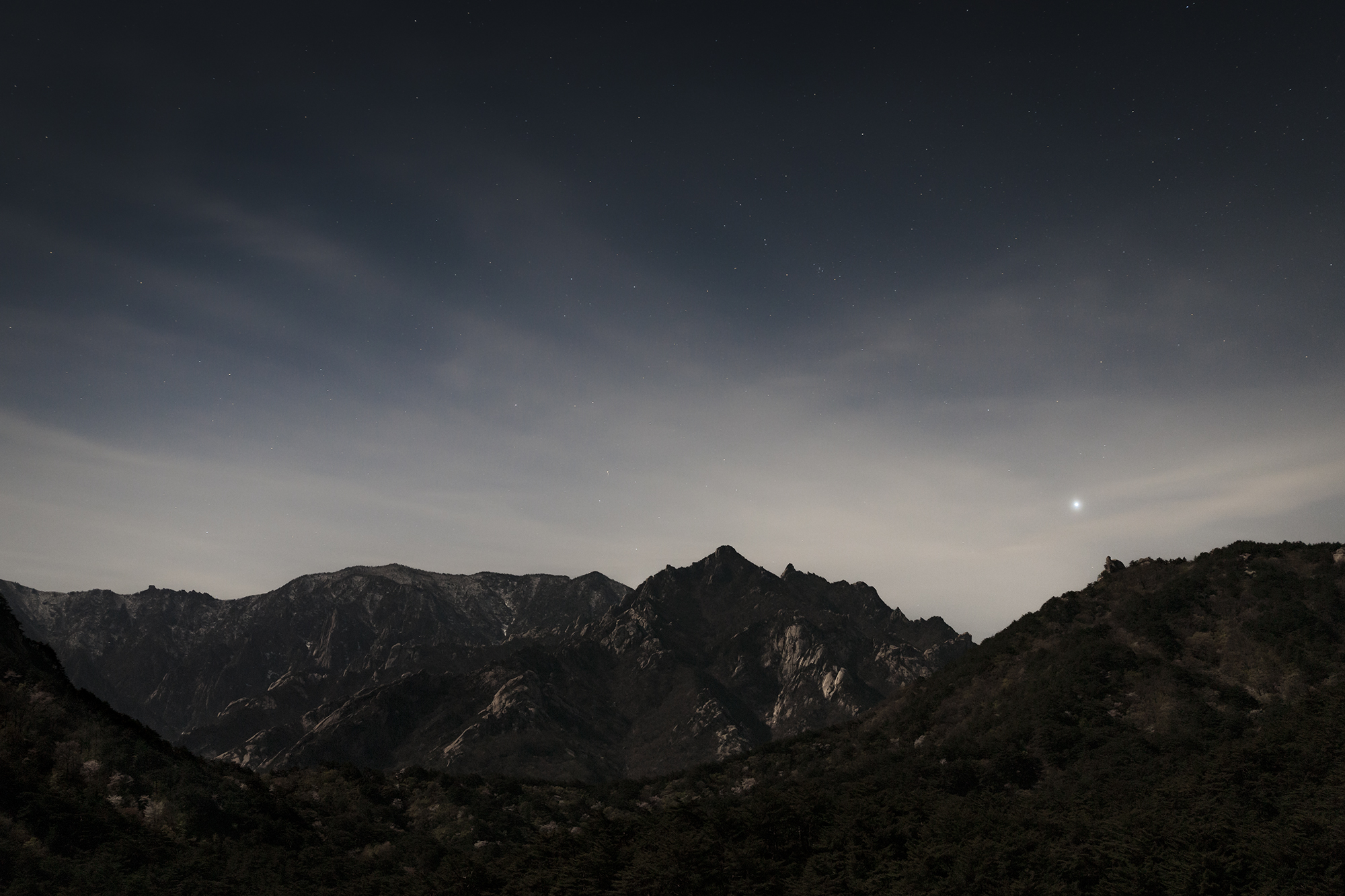
A photograph of the Mount Kumgang at night, the second highest mountain in North Korea with its 1,638-metre-high peak. Kangwŏn Province.


















































































The journey from Sinŭiju–a North Korean city on the Chinese border–down to Pyongyang, is a six hours-long ride, passing through the central highlands, towns and villages.
Arriving in Pyongyang, the Ryugyong Hotel dominates the scenery of the city since dawn.
Backed initially by the Soviet Union, the construction on the mysterious building–nicknamed “Hotel of Doom” due to the continuous interruptions on its completion–began in 1987 under the direction of Kim Jong Il, former Leader of North Korea, with the intention to create a national landmark for businessmen and international travellers. A partial opening was announced for 2013, but it was eventually cancelled. Yet, nowadays, more than thirty years later, it isn’t clear to what use the 105-story building is conceived for.
A train station officer with a whistle on the platform at Pyongyang Railway Station.
A North Korean man is standing by the platform n.1 at the Pyongyang Railway Station, which also serves as the main station in North Korea connecting most of the cities in the country.
North Korean commuters are standing on the platform waiting for the train.
The North Korean Railway still utilises old Soviet trains from the mid-20th century.
The North Korean government guides, known as “minders”, an assured–sometimes even pleasant–part of any visit to the DPRK.
A man is reading propaganda messages on a wall in a Pyongyang neighbourhood.
All propaganda messages are produced following the guidelines set by the Propaganda and Agitation Department (PAD) and placed throughout the whole country to encourage people to work hard and to boast about the glories of North Korea.
A propaganda mural depicting the Great Leader Kim Il Sung leading the Nation.
Most of the North Korean propaganda disseminates Juche, which means “self-reliance,” the North Korean ideology of independence promoted by North Korean founder Kim Il Sung.
In North Korea, public transportation connecting the main towns is nearly nonexistent, citizens need permits to go from one place to another. By entering and leaving Pyongyang and other major cities, soldiers are assigned at checkpoints placed on the road to control people’s movements.
The majority of North Koreans do not own cars. As well as for the city’s best neighbourhoods and apartments, also cars are reserved for the Party elite as symbols of a higher rank in society.
The entrance to the Victorious Fatherland War Museum in Pyongyang. A history and military museum dedicated to the Korean War.
Crops are harvested in the North Hwanghae Province.
Natural disasters and poor farming practices led to North Korea’s worst yield in more than a decade. In recent years, North Korea has been fighting severe droughts which decimated its production of crops causing chronic food shortages.
A North Korean guide wearing a traditional dress is walking towards the International Friendship Exhibition Hall in the Myohyang Mountains area.
The complex is an underground exhibition consisting of all the gifts that the Great and Dear Leaders of North Korea received on state visits and official occasions.
Two motionless North Korean army soldiers with polished silver-plated machine guns guarding the entrance to the Friendship Exhibition Hall complex in the Myohyang Mountains area.
A North Korean official is standing in front of a map that illustrates the border between North and South Korea in the DMZ.
Behind the barbed wire, farmers work the land in Kijŏng-dong, also known in North Korea as “Peace Village”, one of the only two villages permitted to remain in the four-kilometre-wide DMZ laid out under the 1953 armistice ending the Korean War.
According to the North Korean government, the village has a collective farm that is run and maintained by 200 local families living in the area.
A North Korean soldier points a map of the border between North and South Korea in the DMZ.
A uniformed North Korean army official is supervising the operations at the entrance of the DMZ in Kijŏng-dong.
The Korean Demilitarized Zone (DMZ) is a strip of land running across the Korean Peninsula serving as a buffer zone between North and South Korea.
A uniformed North Korean army official is walking on the pathway towards the Joint Security Area (JSA) on the North Korea side.
Inside the DMZ, the Joint Security Area (JSA) is an area jointly policed by South and North, established as negotiating site, where the two sides occasionally meet for discussions.
A North Korean soldier in the Armistice room, wherein 1953 North and South signed a truce that stopped hostilities, thus ending the Korean war and establishing the current borders.
A street scene in Kaesŏng, North Hwanghae Province, the ancient capital of the Koryo Dynasty, North Pyongyang. On the left, the monument inspired by the Juche Tower.
The Arch of Reunification on the Reunification Highway in Pyongyang, is a monument that symbolises North Korea's intention of reuniting North and South Korea into one democratically governed 'Koryo Federation.'
A mosaic depicting Kim Il Sung as a young man leaving home to lead the resistance against the Japanese.
Mangyongdae, just outside Pyongyang, is the birthplace of Kim Il Sung. The area, considered a sacred site, is a place of revolutionary pilgrimage and glorified as a North Korean cultural icon.
North Korean army officials marching in Mangyongdae, Pyongyang.
The area was designated as historic and listed as a revolutionary site by Kim Jong Il to solidify the North Korean cult of personality centred around him and his father, Kim Il Sung.
A traditional North Korean music performance by three young women in a Pyongyang restaurant open to foreigners.
North Korean students perform at a Mass Dance in honour of the former Great Leader Kim Il Sung on his birthday anniversary in Pyongyang on April 15.
North Korean students perform at a Mass Dance in honour of the former Great Leader Kim Il Sung on his birthday anniversary in Pyongyang on April 15.
Mass Dances are large choreographed dances, accompanied by revolutionary and folk music, taking place at various locations around the country and can include hundreds to thousands of participants.
A street scene near the Kim Il Sung Stadium in Moran Hill, Pyongyang.
At Puhung (Prosperity) Station, built in 1987 and one of the many 100-metre deep subway stations on the Pyongyang subway network, a North Korean metro attendant is walking in front of one the many propaganda murals depicting revolutionary and socialist ideology.
At the Pyongyang metro Station, on the Chollima Line, a commuter is reading a daily report of the official newspaper of North Korea’s ruling Workers’ Party while awaiting the train.
Newspapers in North Korea go through tight censorships by the PAD (Propaganda and Agitation Department).
A North Korean couple rides the escalator in silence at the Pyongyang subway station.
The centrality of the Leaders can be seen in everyday’s life. In the Pyongyang subway, portraits of Kim Il Sung and Kim Jong Il are present in every train carriage.
By law, the structures of the frames are made thicker on the top side and angled downwards to oversee the people in any room they are placed.
Commuters walking in front of an electronic board on the Chollima line at the Pyongyang metro Station.
The Pyongyang Metro is the deepest subway system in the world at 110 metres with an almost four-minute descent to reach the train platforms.
North Koreans pay tributes to nation founders Kim Il Sung and his son Kim Jong Il at the Kumsusan Memorial Palace of the Sun in Pyongyang, the largest structure in the world of its kind.
Although some Koreans will never get the chance to visit it, others living in or near the capital Pyongyang will visit on special occasions.
A North Korean soldier walks in front of the bronze statues of former North Korean leader Kim Il Sung and Kim Jong Il in Mansu Hill, Pyongyang, while citizens pay tribute bringing flowers on the birthday anniversary of the Eternal Leader.
The Juche Tower, also known as the Tower of the Juche Idea, located in Pyongyang on the Taedong river, represents the North Korean Juche ideology of independence promoted by North Korean founder Kim Il Sung, which could be defined as the ability of men and women to be in charge of their own destinies in order to make the nation great.
Building topped by revolutionary decoration, across from Kim Il Sung Square.
Markings on the floor of Kim II sung Square are used to guide positioning of parades and synchronised displays.
A North Korean traffic security officer stands on duty on a deserted intersection in Kim II Sung Square.
Chosen for their look and highly desired by the DPRK’s male population because of their beauty and high social status, the traffic officers have more privileges compared to the average North Korean citizens, as like as receiving better pay, more food per day, free housing and health care.
Street scene. A woman is waiting for a bus in Kim Il Sung Square.
The back of the bus stop itself is a large-scale print of the Munsu Water Park, a state run water park located in the east of Pyongyang.
On the birthday anniversary of the former Leader Kim Il Sung , on April 15, North Koreans pay tributes visiting the Kimilsungia and Kimjongilia Flower Exhibition Hall in Pyongyang, two flowers named after Kim Il Sung and Kim Jong Il respectively.
On special occasions, soldiers from all over the country are taken on trips to Pyongyang to visit and pay their respects to the Great Leaders, such as on the birthday anniversary of the former Leader Kim Il Sung, on April 15.
On the birthday anniversary of the former Great Leader Kim Il Sung, thousands of North Koreans visit various monuments as the Kimilsungia and Kimjongilia Flower Exhibition Hall located by the Taedong riverside.
The Kimilsungia and Kimjongilia Flower Exhibition is one of the highlighted events in North Korea. Citizens from all over the country arrive here to commemorate and to pay tributes to their late Leaders.
North Korean students marching in the front yard of the Songdowon International Children’s Camp, located in the Kangwŏn Province outside of Wŏnsan city.
The camp’s experience allows children to make connections worldwide, as well as helping open North Korea to the world.
Students of the Songdowon International Children’s Camp are told by their teacher to revere the“Great Leader” Kim Il Sung.
The Political indoctrination starts at a young age in North Korea, where propaganda about the Eternal Leader and his Juche philosophy permeates all aspects of life.
At the Songdowon International Children’s Camp, computers seem to be using Windows 7 software.
Cut out portraits of the North Korean former Leaders on a huge wall-painting depicting the national symbols – a northern goshawk and the magnolia flower, chosen for the purity perceived by its white colour.
Portrait of a young woman working at the Songdowon International Children’s Camp.
At first afraid to be caught interacting with a foreigner by the omnipresent minders, she agreed to be photographed after hiding herself behind a column in one of the camp’s dining rooms.
As part of the cultural exchange, students of the Songdowon International Children’s Camp learn how to perform North Korean songs and dances.
Children of Songdowon International Children’s Camp have the chance to be entertained in rooms filled with all sorts of video games, computers, and even a movie theatre.
It is hard to say how much of this idyllic environment is genuine, if not even constructed ad-hoc, and for how long these children are given access to the facilities once foreigners’ attention is elsewhere.
An air conditioned male dormitory at the Songdowon International Children’s Camp.
Students of Songdowon International Children’s Camp on boating classes.
What was originally intended to strengthen the relations with Communist countries, became later an international camp open to accept youth from anywhere in the world.
A DPRK flag and large-scale mosaics of the Great Leaders oversee the entrance of the Wŏnsan Agricultural University.
Founded in 1948 and built on the remains of an old German church, the university is a nonprofit and prestigious institution accredited by the North Korean Ministry of Education.
Students of the Wŏnsan Agricultural University.
A student is watering the plants in the Wŏnsan Agricultural University greenhouse.
In line with the Juche ideology, students learn about farming techniques, agricultural management, veterinary sciences, and other agricultural related fields.
On Jangdok Islet, three North Korean students enjoy the sunset on the panoramic balcony that faces the city of Wŏnsan.
The small island is known for the Changdokdo lighthouse, built by the Japanese in 1919 to help in their trading enterprises.
A couple watches the sunset over Yonghung Bay on the pier to Jangdok Islet.
Uniformed North Koreans on the seaside in Wŏnsan, a port city and naval base located in Kangwŏn Province, along the eastern side of the Korean Peninsula.
North Koreans returning from the pier that connects the Wŏnsan docks to Jangdok Islet.
To visit the small island and the Changdokdo lighthouse, foreigners are asked to pay a $1 entry fee. The pier itself is considered an attraction amongst locals who enjoy biking across it.
As the sun sets behind the hills, three North Korean students hold hands on the pier that connects the Wŏnsan docks to Jangdok Islet.
As the sun sets behind the hills on eastern side of the Korean Peninsula, North Koreans enjoy the warm temperatures on the shoreline in Wŏnsan.
An empty dancing floor in a hotel on the East Coast in Wŏnsan city.
Lake Samilpo, Mt. Kumgang Biosphere Reserve UNESCO site.
Mount Kumgang is a forest-oriented ecosystem linked to coastal, agricultural and freshwater ecosystems.
Inscriptions on the large granite rocks between red Korean pine trees in Mt. Kumgang Biosphere Reserve UNESCO site.
The reserve is located in the South-East of North Korea.
The Lake Samilpo is a freshwater lake part of the Mt. Kumgang Biosphere Reserve UNESCO site in the Mount Kumgang Tourist Region which runs along the east of the Korean Peninsula.
A flock of Eurasian magpie flies over a bamboo grove at the Mt. Kumgang biosphere reserve.
A farmer with his cattle on a roadside in the Kangwŏn Province.
Poverty is widespread in North Korea after years of sanctions and economic mismanagement with many North Koreans still rely on traditional farming practices to live.
Farmers working the land in the Kangwŏn Province on the North Korean South-East coast near the Sea of Japan, also known as the “East Sea”.
Farming in North Korea is concentrated in the flatlands of the four west coast provinces where more favourable conditions permit the most intensive cultivation of crops. Rice is North Korea’s primary farm product.
In North Korea soldiers are used as a labour force to compensate for the weak economy of the country. It is not unusual to see them working in the fields helping farmers, fixing roads, or on construction sites.
Under a gloomy cloud threatening rain, a beam of light shines on a small rural settlement in the Kangwŏn Province.
Forty percent of North Korea’s population lives in rural and agricultural communities. North Korean officials usually restrict foreigners to photographing these areas fearing they could give a perception of poverty.
Sunset above the Mt. Kumgang National Park, in the south-east of North Korea.
For its geographical conditions with many hills and plateaus, the farming activities around the Mt. Kumgang Biosphere Reserve are mainly focused on the cultivation of non-paddy field crops, as well as fruit and sericulture.
A photograph of the Mount Kumgang at night, the second highest mountain in North Korea with its 1,638-metre-high peak. Kangwŏn Province.